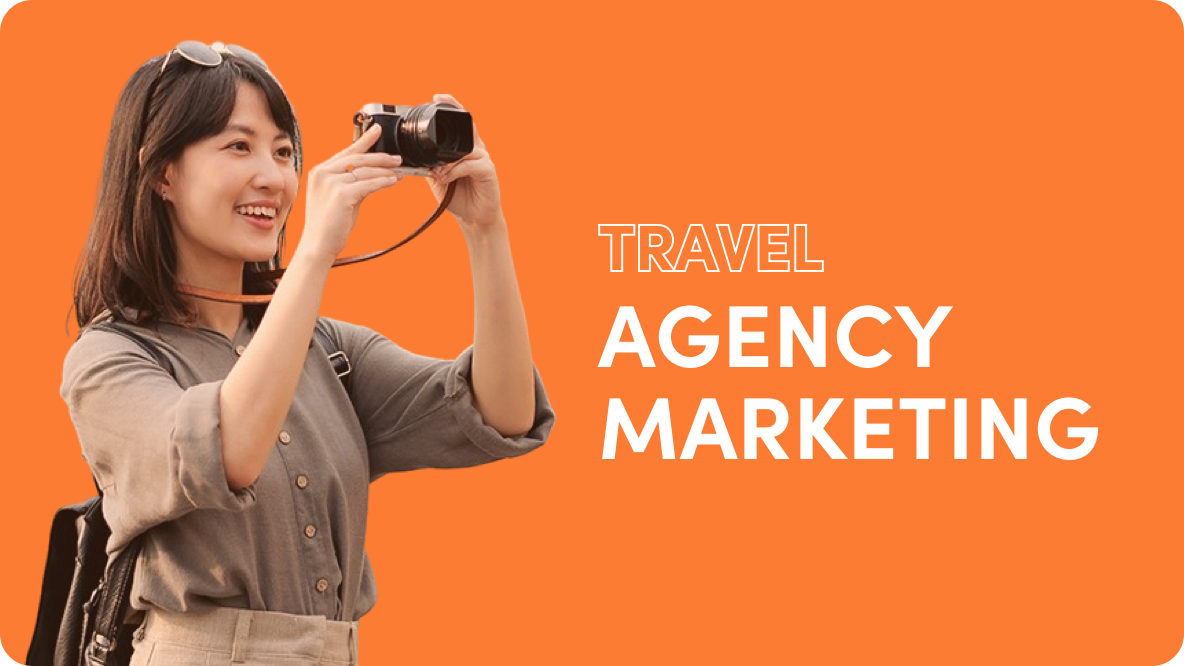

Creating Your Travel Agency’s Digital Marketing Plan: 8 Best Practices

Laura Kloot
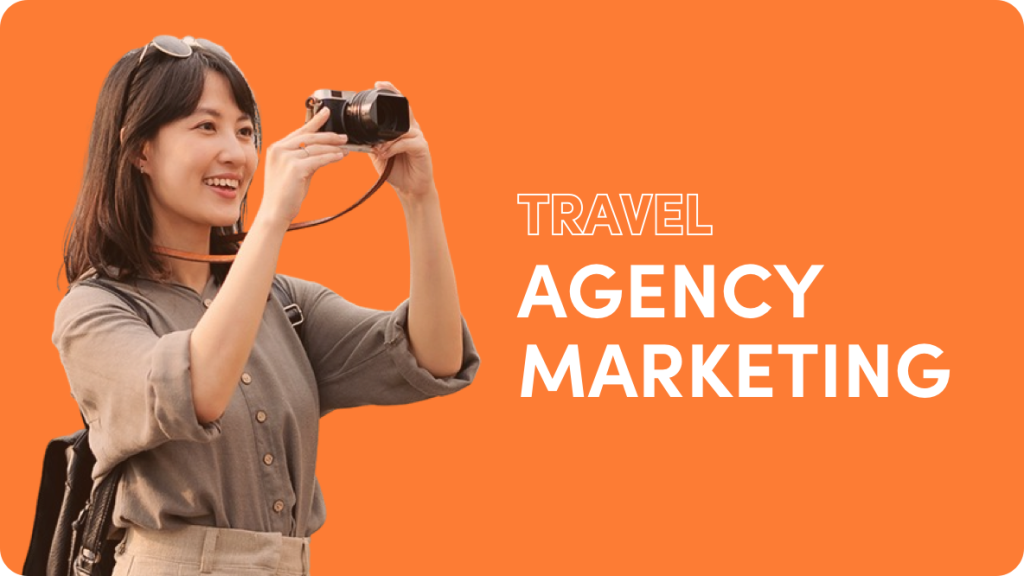
In the ever-evolving digital landscape, travel agencies face increasing competition in attracting online bookings and building customer relationships. An effective travel agency marketing plan tailored to your niche and target market is essential for maximizing your ROI. This article provides 8 updated tips and best practices for creating a successful marketing plan that resonates with customers and drives growth in the travel industry. Let’s go!
Personalize Your Website, Content, and Services
To stand out in the crowded travel market, personalization is key. Create a unique identity and image for your agency by offering personalized or niche services, interactive customer experiences, and customized recommendations based on individual preferences. Tailor your website design, content, and offerings to provide a personalized touch that resonates with your target audience.
Focus on High-Quality Content
Compelling content is the foundation of a successful travel agency website. Create informative, engaging, and visually appealing content that captivates your audience and drives traffic to your site. Incorporate storytelling, share personal travel experiences, provide destination guides, and offer insider tips. Invest in professional copywriting or try out generative AI writing tools to produce a regular stream of high-quality content that boosts site visits and encourages customer engagement.
Leverage User Reviews and Testimonials
Online reviews and testimonials are powerful tools for building trust and enhancing your agency’s reputation. Encourage satisfied customers to leave reviews on platforms like Google My Business, TripAdvisor, Yelp, and industry-specific review sites. Respond promptly to both positive and negative reviews, demonstrating your commitment to customer satisfaction and actively addressing concerns.
Optimize Your Website for User Experience
A visually appealing, user-friendly website is essential for converting visitors into customers. It is also essential for good SEO rankings . Ensure your website is responsive, optimized for mobile devices, and offers seamless navigation. Utilize intuitive booking interfaces, high-quality visuals, and captivating headlines to engage visitors and drive conversions. Incorporate customer reviews and testimonials into your website to showcase social proof and build trust.
Boost Your Social Media Presence
Focus on the platforms where your target audience spends their time, whether it be Facebook, Instagram, TikTok, Twitter, LinkedIn, or a combination of these. Stay updated with emerging platforms such as BeReal, Telegram, and Clubhouse. Leverage social media to connect with a broader audience, share engaging content, promote special offers, and interact with customers in real time. Influencer collaborations can also amplify your agency’s reach and credibility.
Focus on Mobile Marketing
As mobile usage continues to rise, optimizing your marketing efforts for mobile devices is critical. Develop a mobile-responsive website or create a dedicated mobile app for your travel agency. Mobile apps offer personalized experiences, loyalty programs, and push notifications, enhancing customer engagement and convenience. Prioritize mobile advertising, mobile-friendly emails, and mobile-specific promotions to reach and engage your mobile-savvy audience.
Harness the Power of Visuals
Visual content plays a crucial role in captivating and inspiring potential travelers. Utilize high-quality images, videos, and immersive virtual tours to showcase destinations, hotels, and experiences. Incorporate user-generated content by encouraging travelers to share their photos and videos, further enhancing your agency’s authenticity and social proof.
Set Goals, Track Metrics, and Adapt
Establish measurable goals for your marketing plan and regularly monitor KPIs to track progress. Analyze website analytics, social media engagement, conversion rates , and customer feedback to gain insights into what resonates with your audience. Use data-driven decision-making to adapt your marketing strategies, focusing on successful channels, content formats, and customer preferences.
With the rapid changes in online marketing, travel agencies must adapt their strategies to remain competitive. Stay agile, experiment with new trends, and continuously refine your strategies to attract, engage, and convert customers in the crowded and challenging travel industry.
Launch your Campaign!
Create full funnel campaigns that drive real business results..

Related Articles
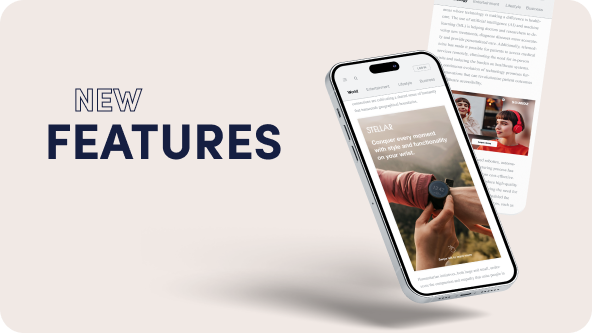
Heather Riley

Camilla Salemme

For Advertisers
- Advertise with Outbrain
- Native Advertising
- Contextual Advertising
- Demo Outbrain
- How to Buy Outbrain
- Outbrain Academy
- Advertiser Guidelines
- Advertising FAQ
- Advertising Glossary
- Vertical Insights
- Vertical Hub
- Affiliate Marketing
- Affiliate Hub
- High-Conversion Content
- Repurpose Social Campaigns
About Outbrain
- Company Overview
- Cultural Manifesto
- Trust & Transparency
- For Publishers
- Thought Leadership
- Outbrain Blog
- Resources Hub
- Case Studies
- Performance Marketing
- Advertising Academy
- Publisher's Directory
- Help Center
Ready to start?
Try Outbrain for Advertisers today
- Interest-Based Ads (Opt Out)
- Privacy Policy
- Terms of Use
- Projects 21 21
- Brand Strategy
- Brand Purpose & Positioning
- Brand Voice
- Brand Audit
- Brand Architecture
- Brand Research & Analysis
- Copywriting
- Content Strategy & Creation
- Brand Identity
- Brand Guidelines
- Brand Name & Tagline
- Logo Design
- Brochure Design
- Packaging Design
- OOH & Print Design
- Retail Branding
- Events and Exhibitions
- Web Design & Development
- Brand Storytelling
- Photography, Film & Animation
- Public and Media Relation
- Environmental Branding
- Digital Branding
- Search Engine Optimization
- Search Engine Marketing
- Social Media Marketing
- Email Marketing
- Influencer Marketing
- Media Strategy, Planning & Buying
- Monitoring, Analysis & Audits
- Stories 63 63
- Clients 92 92
- Careers 7 7
- Blogs 300 300
Our Brand Perspectives

Importance of Digital Marketing for the Travel And Tourism Industry
In today’s digital age, the importance of digital marketing in the travel and tourism industry cannot be overstated. The world is becoming increasingly connected, and consumers are relying more and more on digital channels to plan and book their travel experiences.
As a result, digital marketing has become a crucial component of any successful travel and tourism marketing strategy. Subsequently, there’s been a surge in tourism digital marketing agencies.
If you work in the travel and tourism sector, you already understand directly how important digital marketing is to the success of your company.
Reviews on websites like Yatra, MakeMyTrip, and Ixigo have long been crucial to the promotion of travel. However, focusing only on managing your reputation on those platforms as part of your digital marketing plan is a defensive move. In your off-seasons, it does very little to bring in revenue.
Successful digital marketing for tourism and hospitality helps to entice clients during peak times and even extends peak times to increase company all year long.
Here in this article, we’ll demonstrate how. Continue reading to learn about the importance of digital marketing for tourism and hospitality businesses can use to increase brand recognition, draw clients, and prolong the busy season.
Why is digital marketing important for the travel and tourism Industry?
Digital marketing for travel and tourism encompasses a broad range of tactics and channels, from social media and search engine optimization (SEO) to email marketing and content marketing.
By leveraging these tools, travel and tourism businesses can reach new audiences, build brand awareness, and drive more bookings. The ability to precisely target specific groups is one of the biggest advantages of digital marketing . With the help of data analytics and digital advertising platforms, businesses can identify and target travellers based on their interests, demographics, and behaviour.
For example, a travel company like redBus or EaseMyTrip might use Meta’s advertising platform to target users who have shown an interest in adventure travel, hiking, or camping. Digital marketing also allows travel and tourism businesses to build relationships with customers over time. By providing valuable content, engaging with customers on social media, and offering personalized promotions, businesses can build brand loyalty and generate repeat business.
In addition, by leveraging customer data, businesses can tailor their marketing messages to specific segments of their customer base, further increasing the effectiveness of their campaigns. Perhaps most importantly, digital marketing enables travel and tourism businesses to measure and track their marketing efforts with greater accuracy than traditional marketing channels .
By tracking website traffic, engagement rates, and booking conversions, businesses can optimize their marketing strategies in real-time, making data-driven decisions that lead to better results. The importance of digital marketing in the travel and tourism industry cannot be overstated.
From targeting specific audiences with precision to building brand loyalty and measuring results, digital marketing offers a broad range of benefits that can help businesses succeed in today’s increasingly connected world. By embracing digital marketing and staying ahead of the latest trends and technologies, travel and tourism businesses can reach new heights of success and continue to thrive in the years to come.
The 5 Major Challenges of Tourism Marketing
Tourism and hospitality marketing is an essential aspect of the travel and tourism industry, and it plays a crucial role in promoting destinations, accommodations, attractions, offers, and experiences to potential travellers.
However, despite its importance, tourism marketing is not without its challenges. Let’s explore some of the main challenges of tourism marketing and their impact on the industry.
1) Competition
One of the biggest challenges facing tourism marketing is competition. There are thousands of destinations worldwide, each vying for attention and trying to attract tourists.
With so many options available, it can be difficult for a particular destination to stand out and capture the attention of potential travellers.
2) Changing consumer preferences
Another challenge facing tourism marketing is changing consumer preferences. What was popular last year may not be as popular this year, and destinations and tourism operators must adapt to these changes.
For example, the growing trend of sustainable and responsible tourism has led to increasing demand for eco-tourism and other environmentally friendly travel options.
3) Technological evolution
Technology has transformed the way we travel and the way tourism businesses market their products and services. Despite the many opportunities provided by technology, such as social media, online booking platforms, and mobile applications, they also present challenges for tourism marketing.
For example, the vast amount of information available online can be overwhelming for travellers, and it can be difficult for businesses to cut through the noise and get their message heard.
4) Economic instability
Economic instability can also pose challenges for tourism marketing. A recession, for example, can lead to a decrease in travel and tourism spending as people tighten their belts.
Additionally, political instability and security concerns in a destination can discourage travellers, which lowers tourism revenue.
5) Seasonal fluctuations
Seasonal fluctuations in travel demand can also pose challenges for tourism marketing. For example, some destinations may experience a high demand for tourism during the summer months but struggle to attract visitors during the winter.
This can create challenges for tourism businesses that need to maintain a steady stream of revenue throughout the year. In order to overcome tourism marketing challenges, you must be creative, adaptable, and willing to embrace change.
How can Digital Marketing Help the Tourism and travel industry?
1) convey information & shaping perception with a single click.
The emergence of social media has simplified the process of sharing information globally, compared to earlier times when there were no practical or quick methods for doing so.
Due to their accessibility on mobile devices, mobile applications of brands with a broad reach, such as TripAdvisor, MakeMyTrip, and Clear Trip, are a continuous resource for tourists as they choose an experience.
Anyone can now obtain information about travel and tourism using a variety of social media tools.
Not only has trip planning become easier, but more educated choices have been made, as a result. That helps a lot of tour companies because it helps them comprehend their customers better.
2) Use Google for dedicated digital marketing for tourists
The undisputed leader in all things Internet, Google has sophisticated algorithms for determining a site’s SEO value in addition to hotel reservations and weather forecasts.
It also provides opportunities for hotel reservations, flights, and weather forecasts for numerous locations.
Due to this, Google plays an even bigger role in publicizing your tourism company and encouraging customers to make reservations through you. You must also maintain a correct and up-to-date Google My Business listing to help users find you easily.
Make sure you’re updating your material consistently and effectively. An updated website and informative yet immersive blog can work wonders with Google wizards to keep your site ranking well.
3) Utilize data to design a tailored trip experience
You can more effectively gather and evaluate your data with the help of digital marketing and digital tools in general.
You can track every client interaction with you through the sales pipeline and service duration with a streamlined channel.
In order to provide a more customized experience for your customers on a bigger scale and to spot trends that might have a negative impact on your services, the collected data can be analyzed.
Then, you’ll be in a superior position to comprehend your client’s needs and provide them with the ideal travel experience.
4) Identify and choose the right travel Influencers
In addition to content marketing on your own blog, consider identifying and working with influencers your target audience already follows and respects.
Together, you can produce blogs, videos, or social media pieces that will raise your profile and boost sales both in and out of season.
However, approach with caution. Consider using a contract to protect your company. Define the influencer’s obligations and the compensation schedule.
Also keep in mind that if the travel influencer you’re working with gets into trouble, it might hurt the image of your own brand. Choose your influencer smartly.
5) Provide offers, information, and full-circle benefits in weekly newsletters
Email marketing is essential when discussing internet marketing for the travel and tourism sector.
Email marketing is a digital marketing tactic that is well worth your time and effort, regardless of whether you already have a large list of email contacts or want to make that an objective in the upcoming months.
Email newsletters are a fantastic way to keep in touch with your audience, build brand awareness, and let people know about exclusive deals or brand-new attractions.
Keep this in mind as you plan the substance of your emails: Successful email newsletters never feel spammy. Yes, offer discounts, but don’t confine your email marketing to just sales.
Instead, add value by giving visitors to your region advice on what to see and skip new restaurant reviews, and hotel recommendations.
What are the best kinds of content travel and tourism businesses can produce?
There are various types of content that travel and tourist businesses can produce for marketing purposes.
- Destination Guides
Travelers often research extensively before choosing a destination. You as a tourism and hospitality company can create destination guides that provide detailed information about the location, such as the best places to stay, eat, and visit.
- Travel Blogs
Travel blogs are a great way to share personal experiences, tips, and recommendations with potential travelers. They can help build a sense of community and establish your transport and travel business as a trusted source of information.
- Social Media Posts
Social media platforms like Instagram and Facebook are excellent for showcasing visually appealing content, such as stunning photographs and videos of destinations, hotels, and activities.
- User-Generated Content
User-generated content such as reviews, photos, and videos from satisfied customers can be a powerful marketing tool. This type of content can help potential travellers get a better sense of what to expect from your tourism company and the destination too.
- Travel Vlogs & Videos
Vlogs and videos are an engaging way to showcase destinations, hotels, and activities. They can help potential travellers visualize their trip and provide a more immersive experience.
By creating a marketing mix of different types of content, travel and tourism businesses can reach a wider audience and increase their chances of success.
How Litmus branding can help you develop a marketing mix for tourism?
To no one’s surprise, the tourism industry is highly competitive, and a well-designed marketing mix can help tourism businesses effectively promote their products or services to potential customers.
A marketing mix refers to the combination of different marketing tactics that a business uses to achieve its marketing goals.
Your travel business’s digital marketing mix should include the following components for remarkable results:
Product: Referring to the actual tourism service being offered, such as hotel accommodations, guided tours, or adventure activities. If you are to taste success in the travel industry, you need to design your products or services to be attractive to potential customers.
Price: For your tourism business, you need to set prices that are competitive, yet also reflect the value for money that your tourism business offers.
Place: This alludes to the sales/distribution channels used to market travel-related services, such as city-wise located travel agencies and/or online booking platforms.
To reach your target market, your tourism & travel company must make sure that your services are accessible through the proper channels in a proper manner.
Digital Marketing Strategies for a Successful Business
Digital marketing for financial services, digital marketing strategies for textile business, digital marketing strategies of fintech apps, digital marketing strategies for edtech business, digital marketing strategies for transportation and logistics business, jewellery marketing ideas, digital marketing strategies for d2c brands.

Director Ahmedabad, India Hiren Panchal co-founded Litmus with Kapil. Hiren owns an exhaustive character and sharpens his views with an analytical mindfulness. He observes every creative with a conscious magnifier. Just as his doer attitude wins over his believer attitude, his thought leadership aims at creating leaders and not followers on his team. His creative insights have created brands worldwide and he has been commanding in the industry for +20 years. Come to the point, he’s already there.
It has recently come to our notice that there are fraudsters connecting with job seekers offering jobs, payments, freelance opportunities under our name.
We wish to inform you that our official communication, assignments, or offers will always be routed through [email protected] or other official email IDs bearing our domain name @litmusbranding only.
If you’ve recently been approached with any suspicious offers, please write to us on [email protected] , or call us directly on 079 4003 8388
The ultimate travel marketing strategy guide
Discover the ultimate travel marketing tactics to succeed and stay ahead.
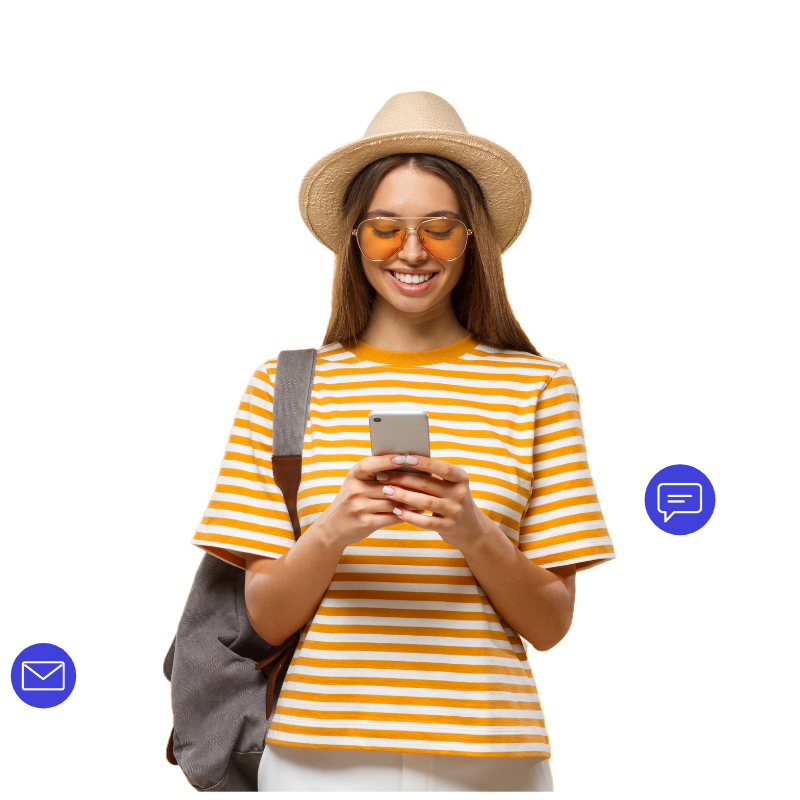
The importance of getting your marketing right in the travel sector is at an all-time high. Social media and influencers have helped make the world more visible than ever before. Consumers are turning to social channels as a source of inspiration. They’re hunting for the next trending destination and best travel deals.
On top of this, there has been a much-needed post-COVID travel boom. So-called ‘revenge holidays’ are in full swing and worldwide tourist arrivals are expected to reach up to 95% of pre-pandemic levels . It finally looks like things are getting back to normal and opportunities are everywhere.
But competition is growing. Standing out from the crowd is becoming increasingly difficult and keeping travelers engaged enough to complete the checkout process is a challenge.
At the same time, there are question marks over how long this travel boom will last. Staffing issues, the cost of fuel and energy, and uncertainty around the cost of living are causing concern for travelers and travel marketers alike.
In this ultimate guide, we will have a look at the current state of the travel marketing landscape and break down all the channels and tactics you need to utilize to succeed in the highly competitive sectorwere
- Travel marketing strategy
- Email marketing for travel marketers
- Segmentation strategies
- SMS marketing for travel brands
- Marketing automation programs
6. Web personalization for travel brands 7. Push notification marketing 8. Reporting and analytics 9. AI for travel marketing 10. Integrations for travel marketers
What is travel marketing and why is it important?
People are always dreaming of their next vacation, surely that means travel brands basically sell themselves, right?
Unfortunately, not. How brands market themselves is what makes travelers choose one resort and airline over another. Travel brands must promote and sell their products, services, and experiences to customers. You need to showcase the distinctive features of your destination, accommodation, leisure activities, and travel packages to spark interest and motivate bookings.
The travel industry is vast and continuously evolving. Some of the primary types of businesses that make up the industry include:
- Train operators
- Cruise liners
- Bus companies
- Car rental agencies
- Hotels and resorts
- Bed & breakfasts (B&B)
- Vacation rentals (e.g. Airbnb, VRBO)
- Camping and glamping sites
- Travel agencies (online and offline)
- Tour operators
- Online travel agencies (OTAs)
- Travel management companies (TMCs)
- Travel insurance providers
- Guided tours and sightseeing excursions
- Adventure activities and sports (e.g. skiing, scuba diving)
- Museums, galleries, and cultural centers
- Theme parks and amusement parks
- Restaurants, bars, and cafes
- National tourism boards
- Regional and state tourism offices
- City visitor bureaus
- Travel booking and comparison sites
- Mobile applications for travel planning and navigation
- Travel review and recommendation sites (e.g. TripAdvisor)
- Metasearch engines for flights, hotels, and car rentals (e.g. Kayak, Skyscanner)
Why is marketing in the travel industry important?
Marketing is an indispensable tool for travel brands. Without it, you would struggle to achieve your business goals. Effective marketing can help you attract more customers, increase your revenue, and establish a strong brand.
What are the benefits of travel marketing?
- Increased visibility: Marketing helps significantly to increase your brand’s exposure. This ensures that potential customers are aware of the travel services and experiences you offer and boosts overall visibility in the crowded marketplace.
- Customer acquisition: A well-executed marketing campaign attracts new customers by showcasing the value and unique aspects of your travel business, ultimately driving revenue growth.
- Improved customer retention: Marketing enables your travel brand to maintain long-term relationships with your existing customers by offering personalized and contextually relevant content and engaging with them consistently across channels.
- Enhanced customer loyalty: Including loyalty programs, exclusive offers, and personalized promotions in your marketing can build customer loyalty, leading to repeat business and higher customer lifetime value (CLV).
- Competitive advantage: Innovative and targeted marketing strategies can help your travel brand stand out from the competition, positioning you as a leader and providing an advantage in a highly competitive market.
- Increased revenue: Marketing can be used to generate upselling and cross-selling opportunities, increasing the average transaction value and ultimately resulting in higher revenue.
- Improved brand reputation: Using marketing, you can manage your online presence, customer reviews, and social media engagement. This positively influences your brand reputation, driving more business from potential customers who trust and value your brand.
- Informed decision-making: Leveraging data collected through your marketing activities for analysis and insights can help your business make informed decisions about product and service offerings, and marketing strategies, allowing you to optimize your efforts and boost performance.
- Expansion into new markets: Marketing can play a critical role in identifying new potential markets, demographics, and customer segments to target, enabling you to expand your reach and tap into new growth opportunities.
- Adaptability and resilience: Marketing enables you to react quickly to unpredictable events, market trends, and competitive moves, adapting your strategies to maintain customer engagement and drive bookings while ensuring resilience in the face of challenges.
Need to know marketing statistics for the travel industry
In today’s complicated and dynamic digital world, you must do all you can to understand the intricacies of the travel industry. Using these statistics, you will be able to get a bird’s eye view of global trends, customer behavior trends, and forces that are set to drive the multibillion-dollar industry forward in the years to come.
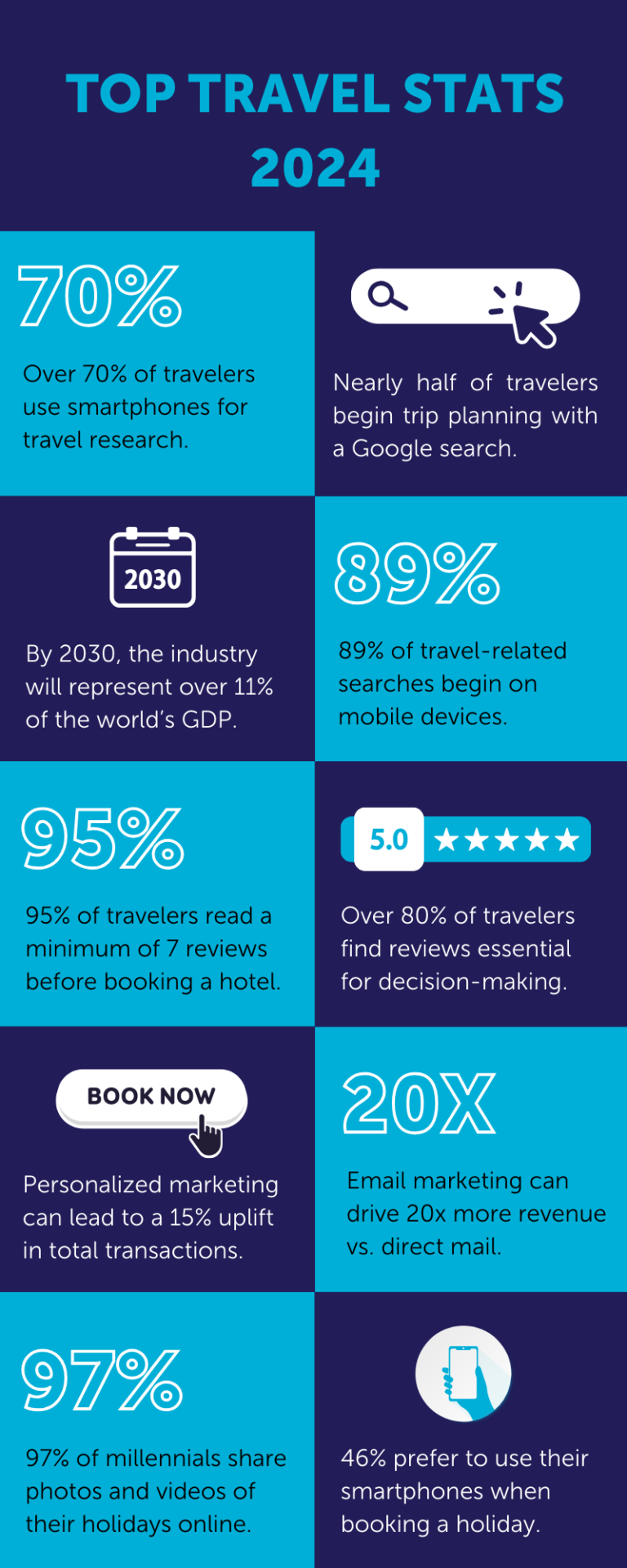
What are the challenges of travel marketing?
Despite economic uncertainty and the lasting impact of the pandemic, the travel industry is returning to pre-pandemic levels and enjoying steady growth.
Still, airlines, hotels, travel agencies, and other travel brands across the world are facing unique challenges that set you apart from typical marketing teams. In the ever-changing world of travel marketing, you have your hands full keeping up with the latest trends and technological advancements. Below are just a few of the top challenges you’re facing on an almost daily basis and how to overcome them.
With inflation in flux and travel expenses rising, travelers now consider price to be their top priority. To connect with your audience, you should emphasize low rates and demonstrate high value. Promoting discounts, bundles, and loyalty programs will appeal to budget-conscious consumers.
As remote work, digital engagement, and eco-consciousness continue to impact customer behaviors, you need to stay on top of trends to cater to emerging segments like bleisure (business and leisure) travelers. Data-centric platforms like Dotdigital plug into CRM systems and use machine learning can help brands understand these new customer groups.
With 86% of travelers seeking personalized experiences , you need to create tailored campaigns that resonate with your audience. Data collection and integration with CRM platforms are essential for delivering enjoyable, relevant, and personalized marketing experiences.
By understanding and following emerging travel trends, you can engage with audiences throughout the whole customer journey. You need to approach the journey holistically and create a cohesive experience across channels. Tools like single customer view (SCV) and eRFM will help you get a clearer view of travelers’ behavior.
To maintain your competitive edge, you must offer a seamless, efficient experience for customers, from booking to post-break feedback. You should tap into technology to adapt to market changes. Ensuring data quality and consolidation will help you reap the full benefits of new tech advancements.
To cater to your more environmentally-conscious travelers, you need to demonstrate a genuine commitment to sustainable practices. Avoiding greenwashing and adopting eco-friendly practices help you align your campaigns with customer values and support a greener future.
How to build a successful travel marketing strategy
Building a successful travel marketing strategy involves careful planning, targeting the right audience, and effectively leveraging your various marketing channels. Here’s a step-by-step guide to creating a winning travel marketing strategy:
Step 1: Define your target audience
Start by clearly defining your target audience. Conduct market research to determine their demographics, preferences, and behaviors. This will help you tailor your marketing materials to resonate with this specific group and achieve better results.
Step 2: Develop a strong brand identity
Create a memorable and eye-catching brand identity that encapsulates your company’s ethos and values. This includes your company name, logo, tagline, color scheme, and visual style. Consistency across all marketing channels reinforces brand recognition and establishes trust.
Step 3: Optimize your online presence
Create a user-friendly website that provides relevant information, showcases your offerings, and guides visitors to conversions (i.e. bookings or inquiries). Ensure your website has strong SEO to improve search engine ranking. Utilize social media platforms to engage with your audience and share valuable content.
Step 4: Leverage content marketing
Produce high-quality, informative, and engaging content that inspires travelers and provides value. This could include blog articles, videos, or destination guides. Diversifying your content not only keeps your audience interested but also addresses different stages of their customer journey.
Step 5: Monitor, analyze, and adapt
Implement analytics tools to track your marketing efforts and identify what works best. Monitor key performance indicators (KPIs) and adjust your strategy accordingly to optimize results. By continually learning from your data, you can make informed decisions and enhance your marketing effectiveness.
Boost growth with cutting-edge marketing technology
To enhance your visibility, captivate travelers, and boost bookings and inquiries, it’s essential to tap into the technology you have available. For peak success in the travel sector, you need technology that collaborates seamlessly with your existing tech solutions.
Dotdigital’s customer experience and data platform (CXDP) delivers an array of travel marketing tools and channels through a unified, all-encompassing platform. By maximizing your technology usage, you can elevate traveler engagement, increase bookings, and optimize your travel marketing initiatives.
Email marketing for travel marketers
Email marketing is a powerful tool for the travel industry, as it enables you to reach your target audience, build lasting relationships, and drive conversions.
In this section, we’ll explore the benefits of email marketing and the essential elements of successful email marketing for travel businesses, including creating targeted campaigns, utilizing data to send personalized content, and ensuring that emails are engaging and mobile-friendly.
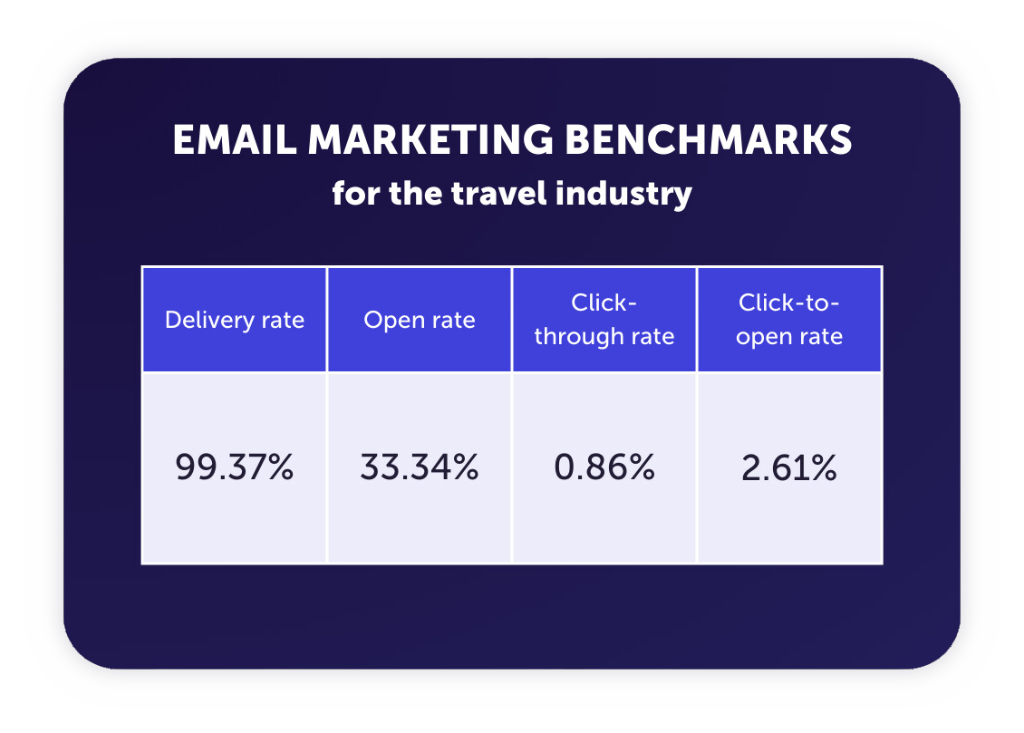
The benefits of email marketing for travel brands
Email marketing is an essential tool for marketers in the travel industry for several reasons:
1. Direct communication channel
Email marketing is a direct line of communication with your target audience, allowing you to share news, updates, offers, and content straight to subscribers’ inboxes, enhancing engagement and nurturing long-term relationships.
2. Strong ROI
Compared to other forms of marketing in the travel sector, email marketing is relatively inexpensive while maintaining a high return on investment (ROI). This makes it one of the best options for travel brands looking to reach large audiences or target specific segments without breaking the bank.
3. Personalization capabilities
Email marketing enables you to create perfectly personalized content and offers based on your subscriber’s demographics, preferences, and travel or engagement history. Ultimately, personalization leads to increased customer satisfaction and loyalty, as your audience feels catered to and valued by your brand.
4. Behavioral targeting
With email marketing campaigns, you can track various metrics such as open rates, click-through rates, and conversions, allowing a better understanding of travelers’ behaviors and preferences. This valuable information can be utilized to optimize future campaigns, ensuring better audience targeting and fostering long-term customer relationships.
5. Urgency and exclusivity
You can use email marketing to create a sense of urgency through time-sensitive offers, limited promotions, and exclusive deals, encouraging customers to book their travel or upgrade reservations.
6. Increased customer retention
By regularly sending informative content, helpful resources, and engaging promotions through email marketing campaigns, you will nurture customer loyalty and increase repeat bookings over time.
7. Relevance and timeliness
Email campaigns can be triggered based on specific events or customer actions, ensuring that the content is relevant and timely as per each individual’s needs. This could include sending reminder emails about upcoming trips or limited-time promotions resulting in better engagements and more conversions.
Email marketing best practice for travel marketers
Travel marketers can employ these best practices to create effective and engaging email campaigns:
Write catchy and enticing subject lines to increase open rates. Make your subject line relevant to the email’s content, and ensure it resonates with your target audience. Tap into the power of generative AI to really save time and improve results.
Personalize your email campaigns by using the recipient’s first name and providing recommendations, content, or offers based on their preferences, travel history, or demographics.
Divide your subscribers into targeted segments based on factors such as geographical location, interests, booking history, or language, and send tailored content that appeals to each segment’s unique attributes.
Embed high-quality images and videos of destinations, accommodations, or activities to inspire and evoke emotions, leading to higher engagement levels.
Make your CTAs clear, concise, and visually emphasized, directing subscribers toward the desired action, such as visiting a web page, booking a travel package, or redeeming special offers.
Ensure that your email template is mobile-friendly, with easy-to-read text and a clean layout, as a large portion of your audience will likely read your emails on mobile devices.
Aim to provide valuable, informative, and engaging content that relates to the interests and needs of your subscribers, building trust and fostering lasting customer relationships.
A/B test various elements of your emails, such as subject lines, send times, layout, or content, to determine what generates higher engagement and conversions. Continuously optimize your campaigns based on the insights gained from these tests.
Keep track of key email marketing metrics such as open rates, click-through rates, conversion rates, and unsubscribe rates to measure the effectiveness of your campaigns and identify areas for improvement.
Regularly review and clean your email list, removing inactive subscribers or outdated addresses to improve deliverability and maintain a high-quality mailing list.
Segmentation strategies for travel marketers
Segmentation is a crucial tactic for all marketers, but none more so than marketers in the travel sector. It involves dividing your target audience into distinct groups based on their preferences, demographics, or behaviors.
Implementing a segmentation strategy allows you to create highly targeted marketing campaigns that resonate better with each group, ultimately driving higher customer engagement and conversions.
Top five benefits of segmentation
1. targeted marketing messages.
Segmentation allows you to tailor your marketing messages and content to specific segments, resulting in greater relevance, customer engagement, and conversion rates.
2. Improved customer experience
Offering personalized content, recommendations, and offers based on segmentation fosters a better customer experience, deepening brand loyalty, and strengthening long-term relationships.
3. Resource allocation
By focusing marketing resources on specific customer segments, you can effectively allocate your budget, time, and efforts, ensuring maximum impact for your marketing activities. eRFM customer modeling will help you identify highly engaged, high-value customers to prioritize.
4. Increased ROI
Using segmentation, you can build tailored campaigns designed to appeal to different groups, resulting in higher response rates and, ultimately, an increased return on marketing investment.
5. Market insights
Segmentation provides insights into your customer preferences and behaviors, helping you identify new market opportunities, improvement areas, or trends that can inform marketing strategy.
Top tips for implementing a segmentation strategy
Collect customer data from various sources, such as website behavior, booking history, survey responses, third-party travel partners, and CRM systems, and unify them to build a comprehensive understanding of your audience.
Utilize Dotdigital’s advanced segmentation tools, including eRFM (engagement, recency, frequency, monetary) modeling and single customer view (SCV) data. These features allow you to achieve more precise targeting and improved insights into customer behavior.
Develop content and promotional offers that resonate with the specific needs, desires, and pain points of each segment. Personalized marketing messages have a higher chance of engaging and converting customers. Use the data collected from Dotdigital’s eRFM and SCV features to inform these strategies.
Ensure that appropriate marketing channels are used for each segment. Different customer groups may prefer email, SMS, or other channels, so align your strategy accordingly. Dotdigital’s customer insights will help you build a seamless cross-channel marketing plan.
Continuously test and analyze the performance of segmented campaigns. Monitor key metrics such as open rates, click-through rates, conversion rates, and CLV to identify areas for improvement. Adjust your segmentation approach and marketing strategies based on these data-driven insights.
Customer preferences and behaviors change over time. Periodically reassess your segments, refresh your data, and leverage updated customer insights to ensure your marketing efforts remain relevant and effective.
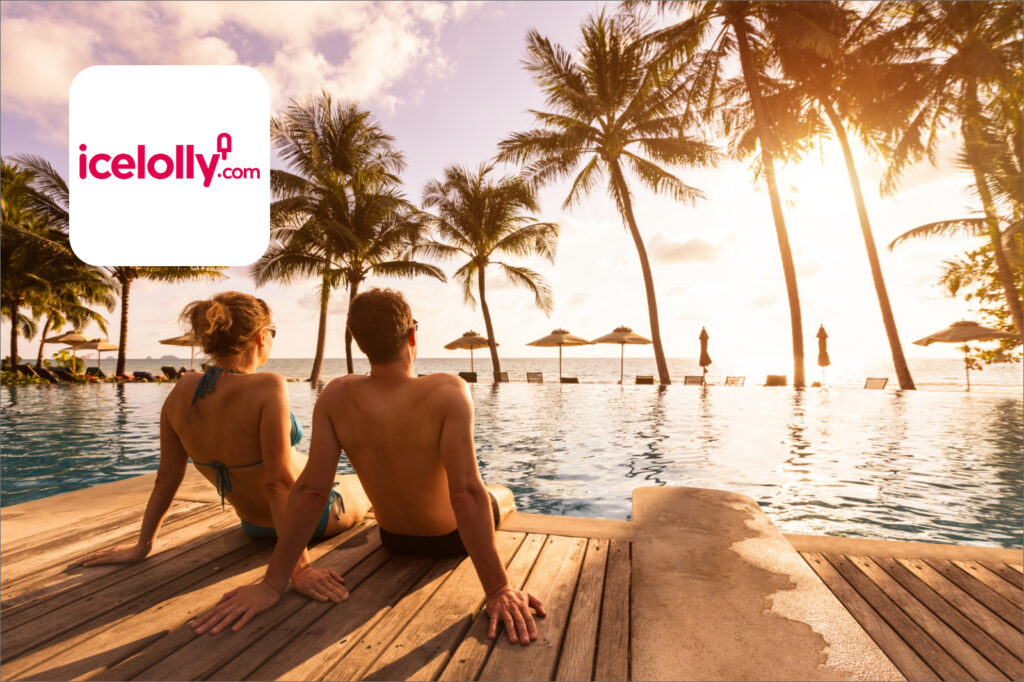
Successful customer re-targeting
Discover how the holiday comparison site, Icelolly boosted conversion rates and enhanced its email marketing performance with personalized re-targeted marketing.
SMS marketing in the travel industry
SMS marketing is a powerful and often underutilized marketing channel that can boost engagement and provide exceptional value for travel businesses like yours. As a direct and immediate form of communication, SMS marketing can help you reach customers in ways other channels might not.
Benefits of SMS marketing for travel marketers
1. high open rates.
SMS messages have an exceptional open rate, with most recipients reading the message within minutes of receiving it. This ensures that promotional offers, updates, or reminders are seen by the vast majority of your target audience.
2. Real-time communication
SMS provides real-time, immediate communication that allows you to send time-sensitive offers, last-minute deals, or critical travel updates to your customers.
3. Mobile accessibility
With the vast majority of the population carrying mobile devices, SMS marketing provides an efficient way to reach your customers regardless of their location or internet access.
4. Cost-effective
SMS marketing campaigns are easy to set up and cheaper than most other marketing channels. This means you can effectively reach your target audience, even on a budget.
5. Personalized experiences
SMS campaigns can be tailored to individual users based on their preferences, interests, or travel history, creating a more personalized and engaging experience for your customers.
6. Easy integration with other marketing channels
SMS marketing can be easily combined with other channels such as email, app, or social media, to create a comprehensive and cohesive marketing campaign for your travel brand.
How to integrate SMS into your travel marketing
By adopting SMS marketing, your travel business can unlock new avenues of customer engagement and diversify your overall marketing efforts, ultimately boosting bookings and customer satisfaction. Here are some campaign ideas that can be implemented through SMS marketing:
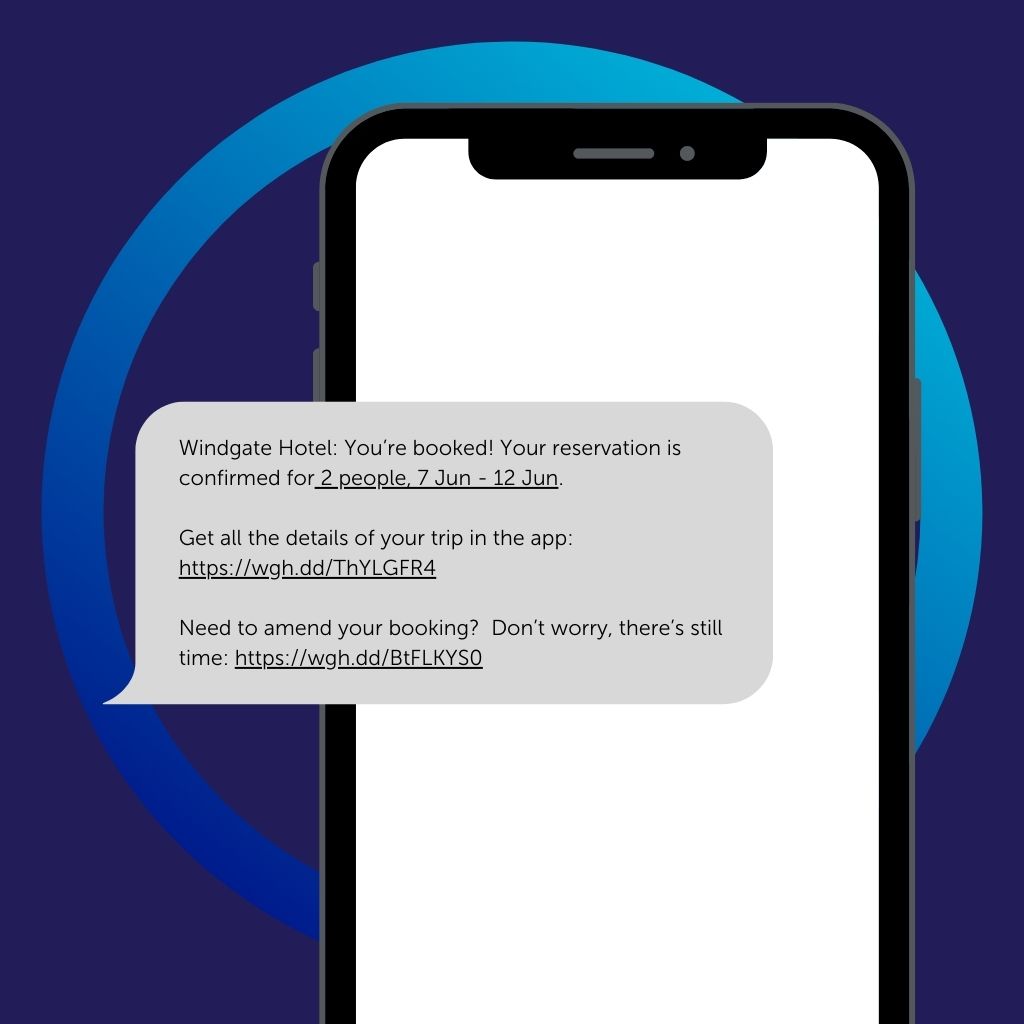
Send helpful reminders for upcoming trips, pre-travel checklists, departure times, locations, or travel document requirements.
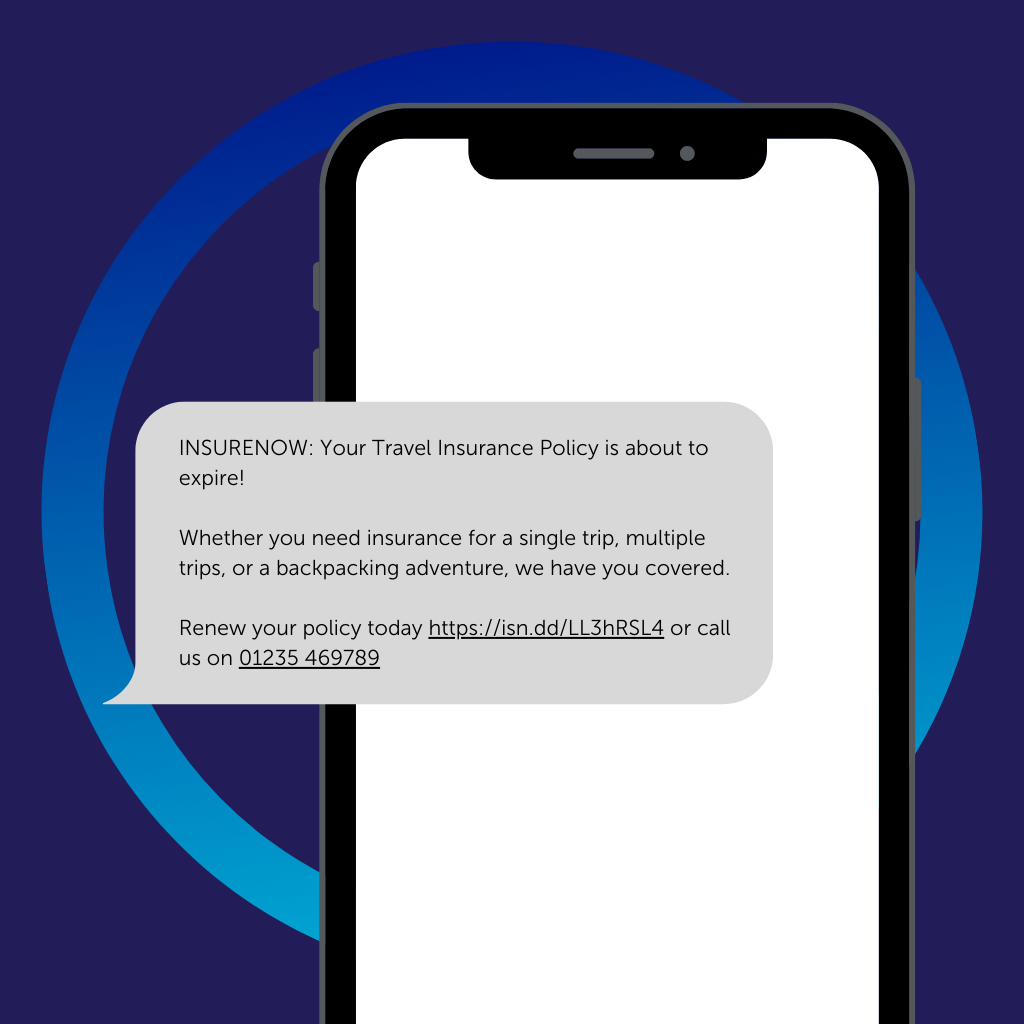
Share essential real-time updates like flight delays, gate changes, or itinerary adjustments, ensuring customers are well-informed and prepared. Ultimately, this will lead to higher satisfaction and experience overall.

Send exclusive deals, discounts, limited-time offers, or last-minute specials to encourage customers to book travel or secure a service through your business.
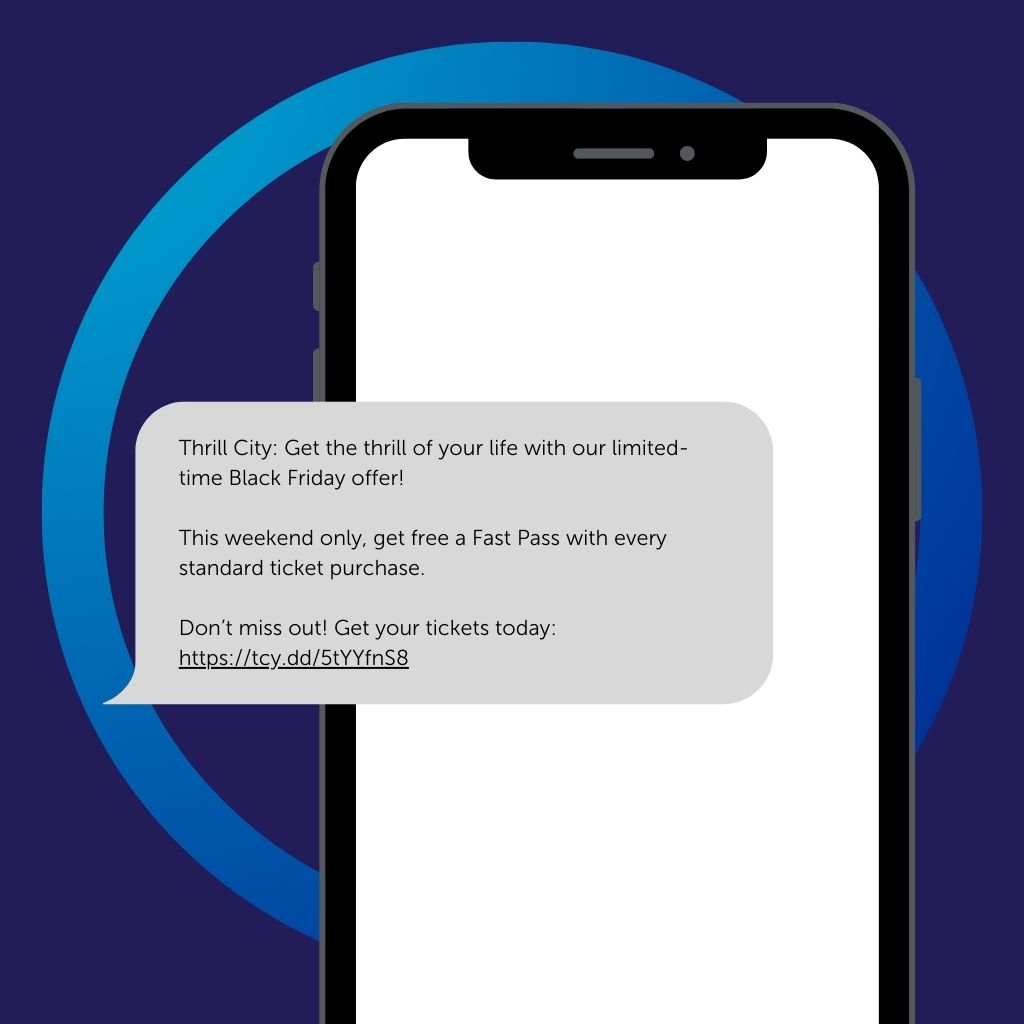
Remind customers about travel packages, accommodation options, or services they were considering but have not completed the booking process.
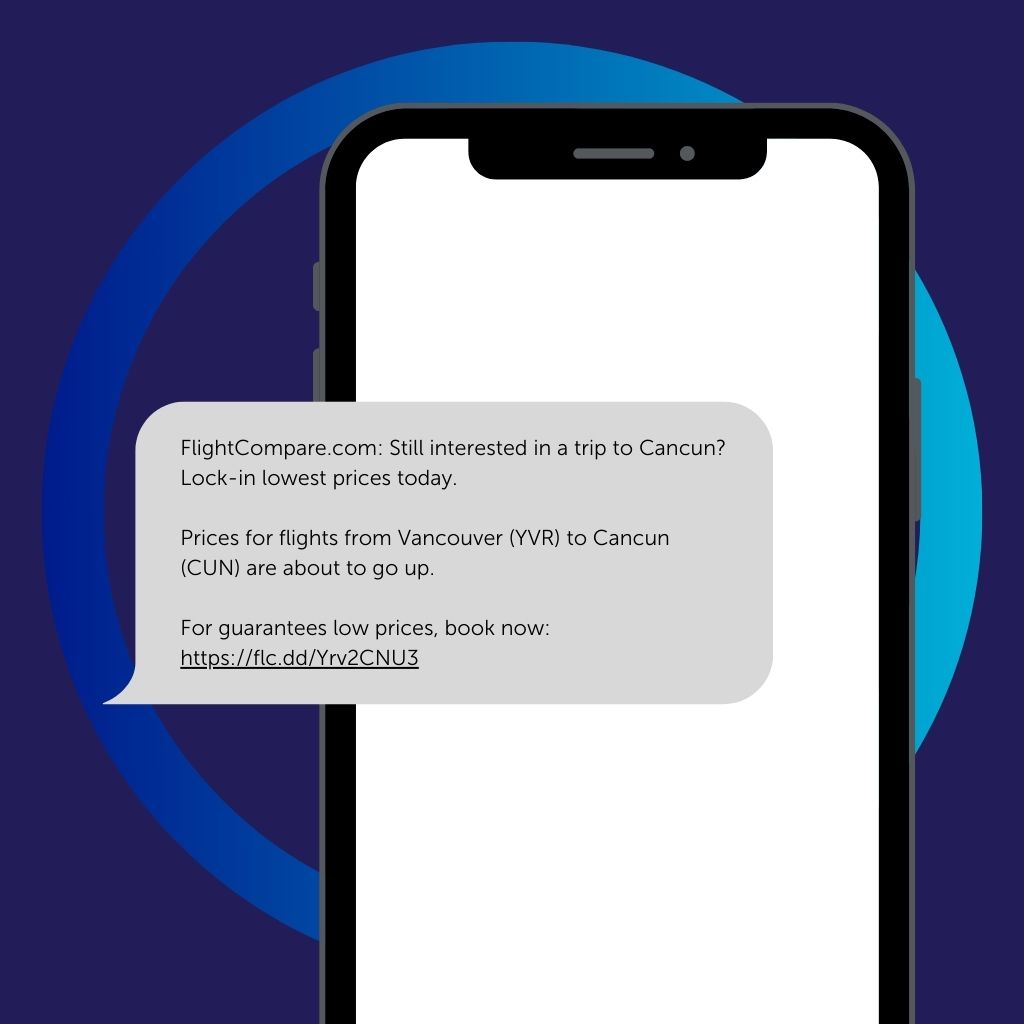
Suggest relevant add-ons or upgrades to customers based on their travel plans, such as excursions, activity bookings, premium seating, or transportation options.
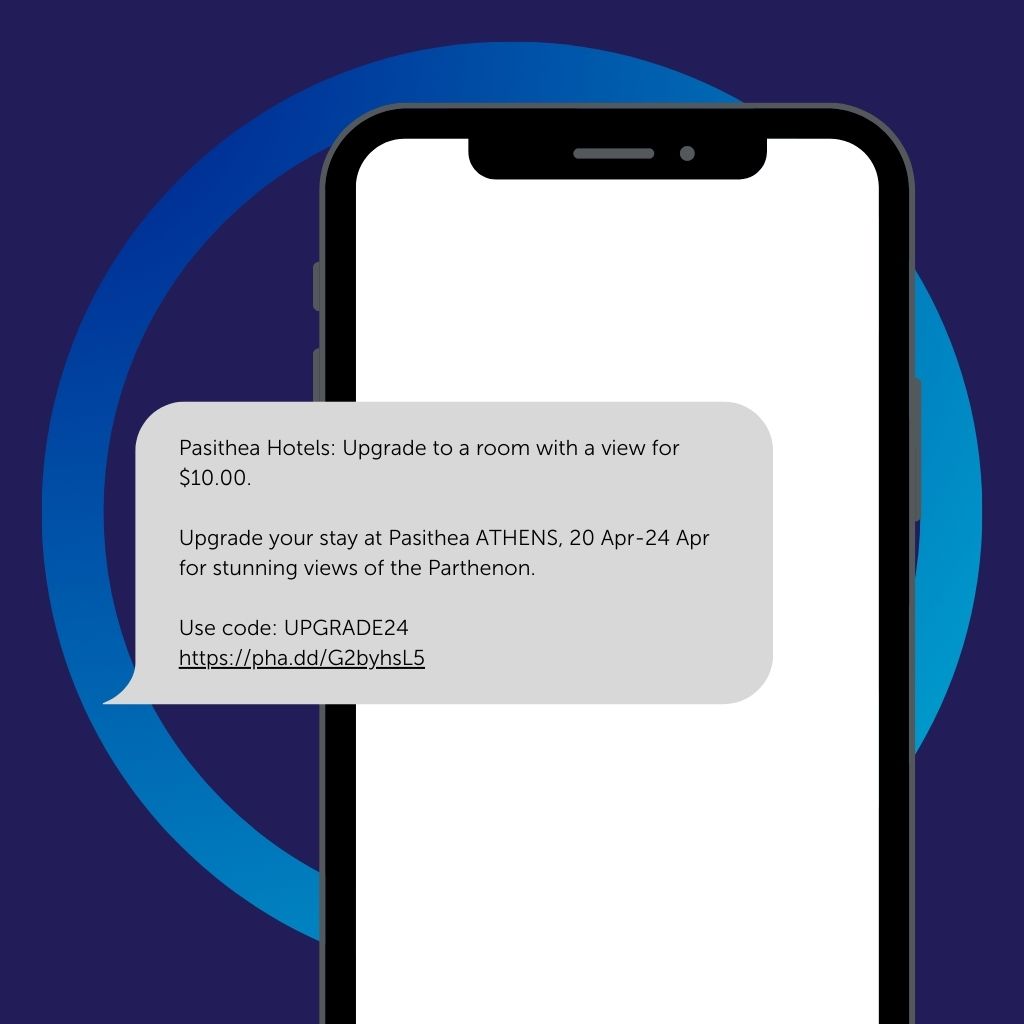
Request post-trip feedback, ratings, or reviews through an SMS message, using the insights to improve your services and customer satisfaction. SMS is a great channel for this because it requires little lift from your team and has a high completion rate.
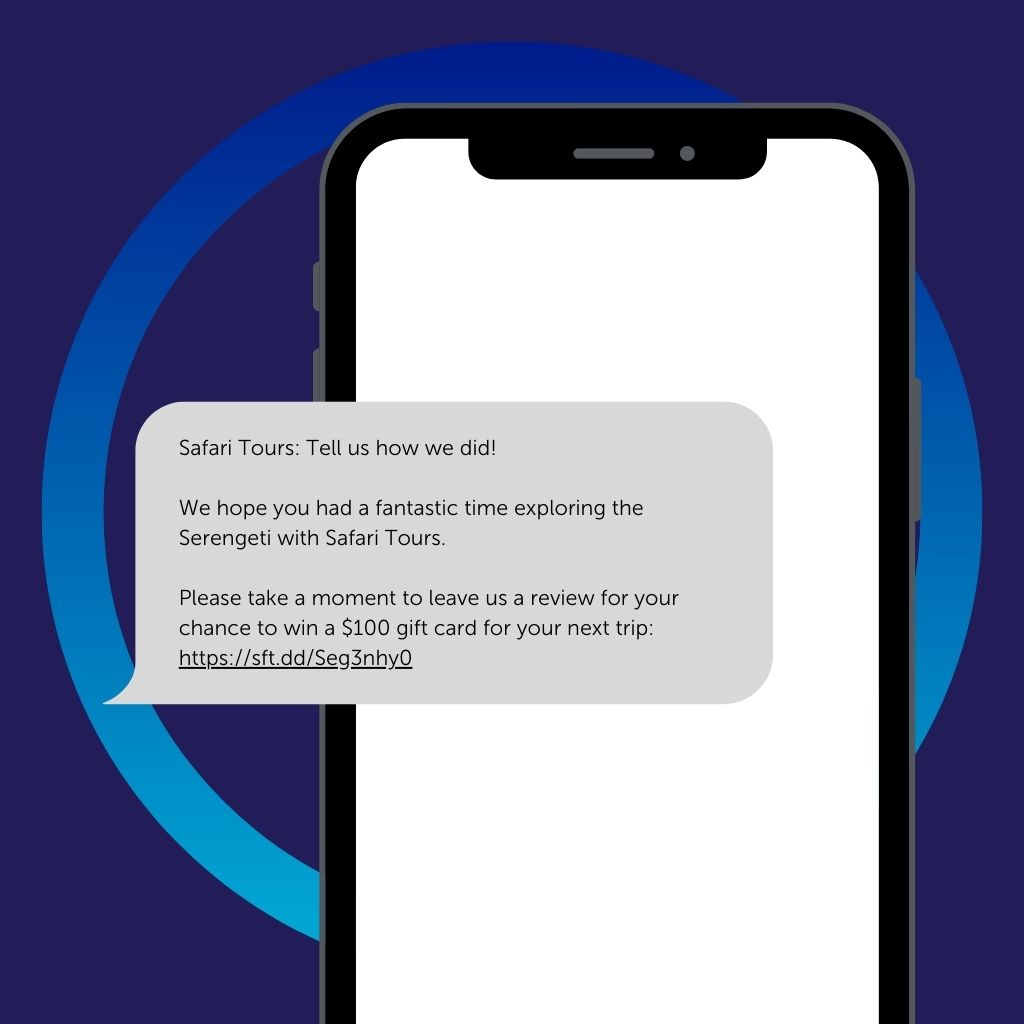
Notify customers of their rewards or loyalty points balance and inform them of any opportunities to earn additional points or redeem special offers.
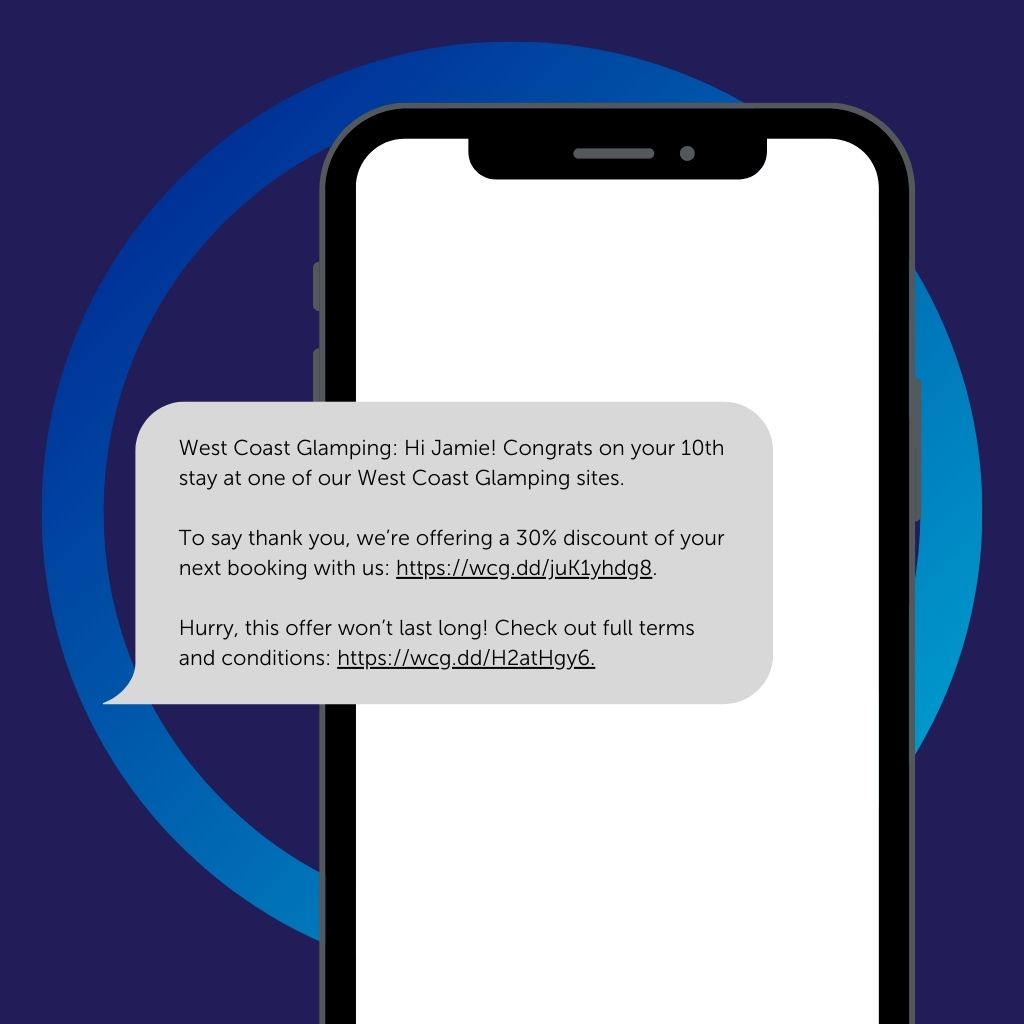
Share useful destination-based information, such as local attractions, events, dining options, or safety tips, to enhance your customers’ travel experiences.
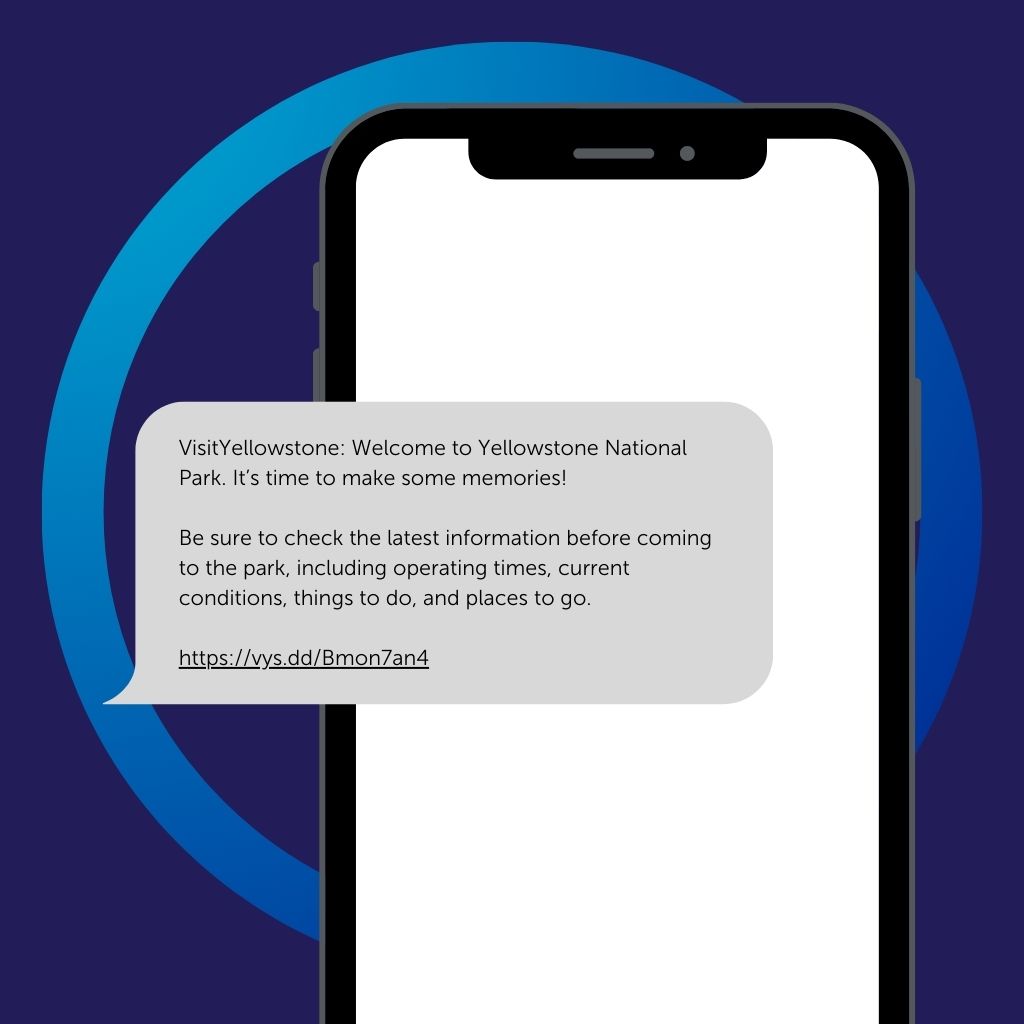
Top tips for successfully incorporating SMS into your travel marketing campaigns
- Combine SMS with email marketing Integrate SMS marketing into your existing email marketing strategy, sending important alerts, reminders, or limited-time offers through SMS to complement your email marketing activity.
- Segment your audience Create targeted SMS campaigns based on demographics, geographic location, or travel preferences, ensuring that your messages resonate with subscribers and are relevant to their needs in the moment.
- Personalize messages Deliver tailored content and offers based on customers’ booking history, travel destinations, or preferences, creating a sense of exclusivity and personal connection.
- Use automation Use customer actions to trigger SMS marketing campaigns, such as booking confirmation, travel reminders, or payment due notices. This will ensure your text messages are landing at the best time to drive customer conversions.
- Keep messages concise Deliver the key message or the call-to-action within the constraints of the character limit. Stay concise, and focused, and ensure your message is easy to understand. Tap into AI tools to help.

Using SMS for two-way communications
Discover how British Airways used Dotdigital’s two-way SMS functionality to encourage travelers to complete monthly customer satisfaction surveys.
MMS for travel marketing campaigns
MMS (multimedia messaging service) is a branch of SMS marketing that allows the sending of multimedia content, such as images, videos, and audio files, alongside text messages. It presents new and exciting opportunities to engage customers in a more dynamic and visually appealing way.
MMS allows you to send rich visual content, including high-quality images and videos that showcase destinations, accommodations, or activities. This allows customers to get a better sense of the travel experience being offered and will inspire them to book.
Multimedia messages, including images and videos, have higher engagement rates compared to simple text messages. By leveraging MMS, you can evoke stronger emotional responses and drive customer interest, resulting in increased conversions and bookings.
MMS helps you to create immersive narratives by sharing pictures, videos, or audio clips of real travel experiences. This storytelling approach can help build a connection with potential travelers, increasing the likelihood of them engaging with your brand.
MMS can be customized based on individual preferences, interests, or travel history. By sending personalized multimedia content to customers, you can create a more relevant and memorable connection, ultimately fostering brand loyalty.
Although MMS adoption is growing, many businesses still primarily rely on text-based marketing. By being an early adopter of MMS, you can differentiate yourself from competitors and establish a unique brand identity in the minds of consumers.
MMS works well in conjunction with SMS, email, and social media campaigns. Integrating MMS into your overall marketing strategy can help create a comprehensive and cohesive approach that covers different stages of the customer journey.
Marketing automation for travel marketers
Marketing automation streamlines and optimizes repetitive marketing tasks, leading to enhanced efficiency, reduced manual efforts, and improved results. Intelligent marketing automation tools like Dotdigital create conversion-driving, loyalty-inspiring experiences by tapping into customer data and turning it into real-time marketing campaigns.
Benefits of marketing automation for travel brands
1. time-saving and cost-efficiency.
Marketing automation significantly reduces manual tasks associated with campaign management and customer segmentation, freeing up time for you and your teams to focus on strategic tasks, such as content creation and performance analysis.
2. Seamless communication
Marketing automation ensures regularly scheduled and consistent communication with customers across different channels. This is essential for maintaining customer engagement and building long-term brand loyalty.
3. Personalization
By tracking customers’ actions, preferences, and booking history, marketing automation tools help you deliver personalized and relevant content that resonates with your target audience. This moments-based approach to marketing enhances the overall customer experience, improving ROI, average order value (AOV), and customer lifetime value (CLV).
4. Cross-channel campaign management
Marketing automation platforms help you manage and coordinate campaigns across various channels, such as email, SMS, social media, and web push notifications, ensuring a seamless and cohesive marketing strategy.
5. Data-driven insights
With the help of detailed analytics provided by Dotdigital, you can make data-driven decisions, monitor campaign performance, and optimize your strategies for maximum results.
Essential automation programs for travel brands
Set up automated welcome emails or messages for new subscribers, providing an initial introduction to your brand, exclusive offers, and personalized travel recommendations based on their preferences.
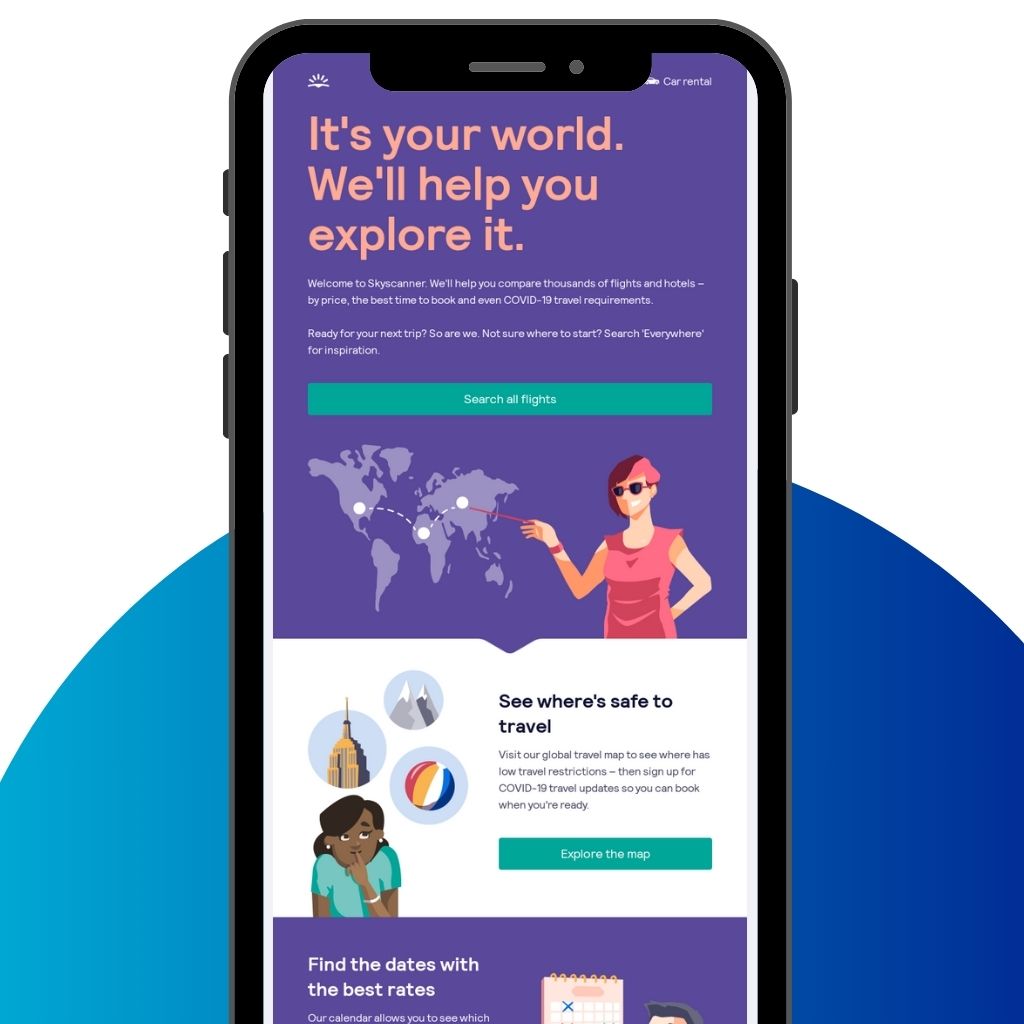
Automate booking confirmations, reservation details, and pre-travel reminders, ensuring all necessary information reaches the customer on time. This can include flight check-in reminders, pre-trip preparation tips, and travel documentation requirements.
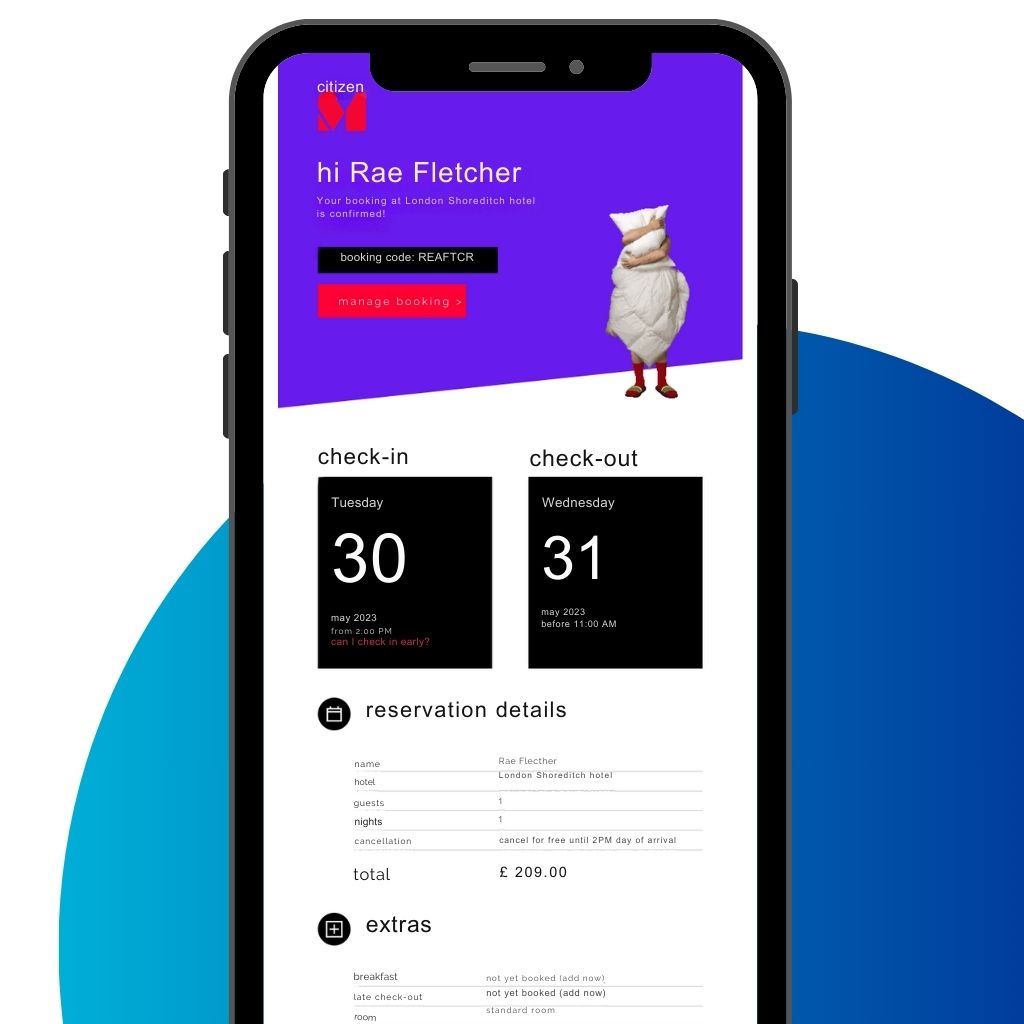
Implement automated messages for customers who added travel packages or services to their cart but didn’t complete the booking process. These messages can include personalized incentives or offers to encourage conversion, AI-powered recommendations, or exclusive discounts for high-value customers.
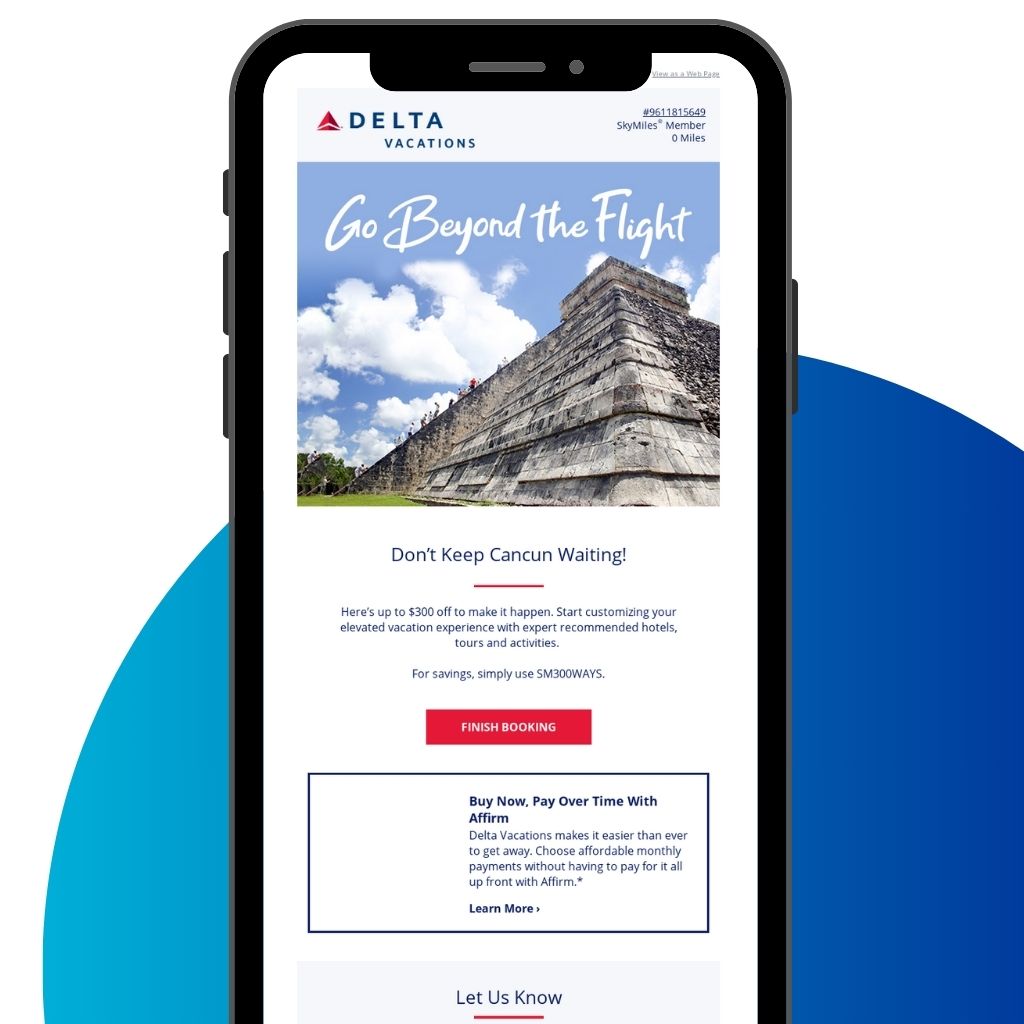
Build automated re-engagement or nurture campaigns to connect with inactive or lapsed customers, offering relevant travel deals or content that sparks renewed interest in your brand. Use eRFM to identify these customers and SCV to gain insight into the channels and content that will drive them toward conversions.
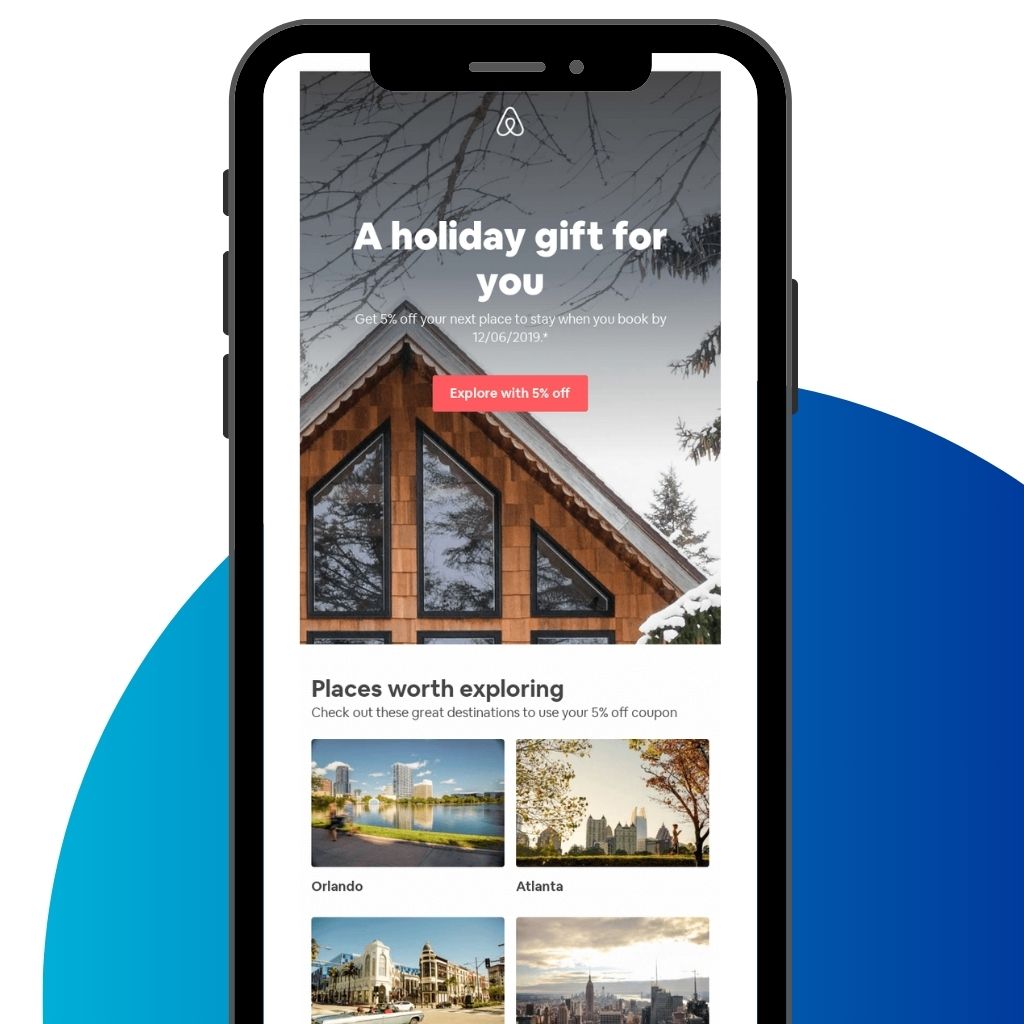
Loyalty programs are a big motivating factor in the decision-making process of modern travelers. Automate loyalty program updates, notifications, or special offers to reward repeat customers and enhance long-term brand loyalty.
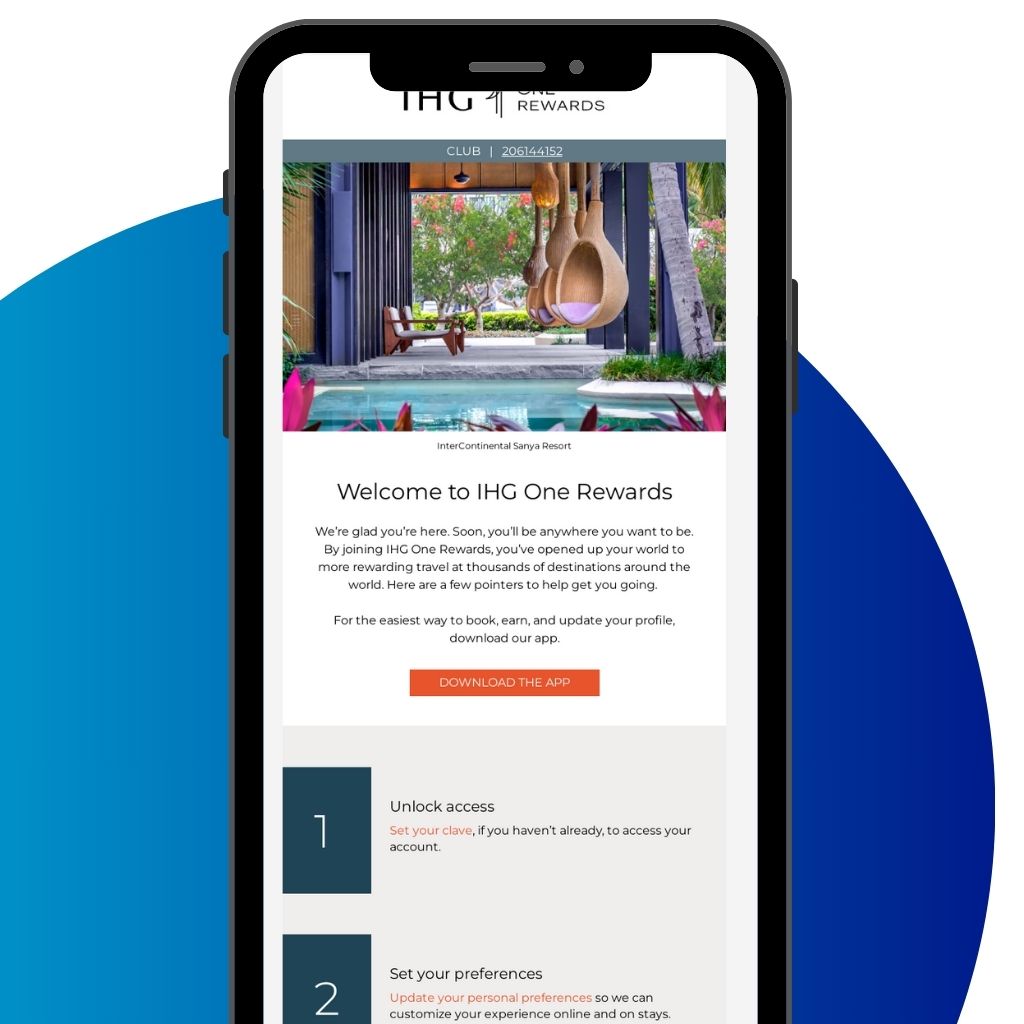
Automate post-trip feedback requests, analyze customer experiences, and collect valuable insights to inform improvements in your offerings and services. Positive reviews also make great marketing collateral so the importance of this program must not be underestimated.
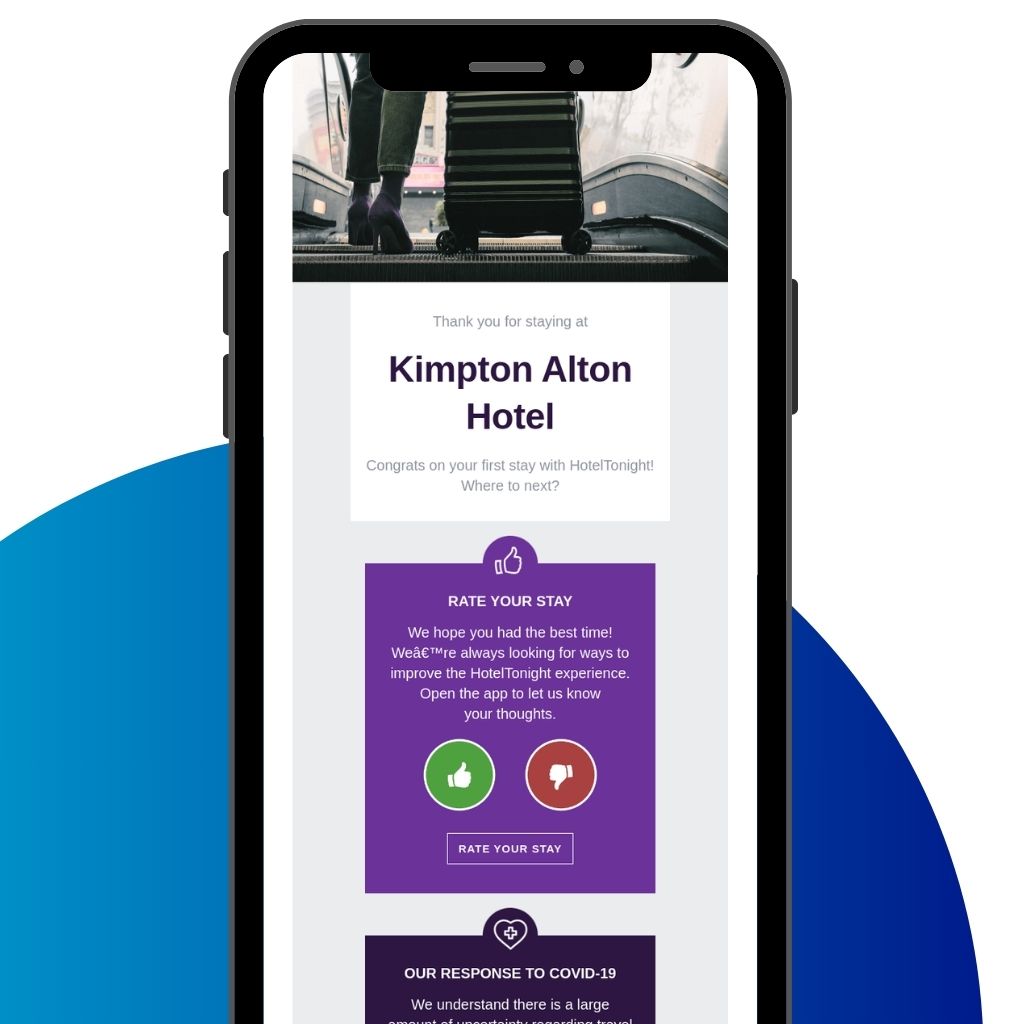
Schedule automated campaigns centered around holidays, seasonal offers, or special events, targeting customers with relevant deals and packages. Use customer insights to see when customers are most engaged or typically looking at your website to identify essential times to launch annual offers.
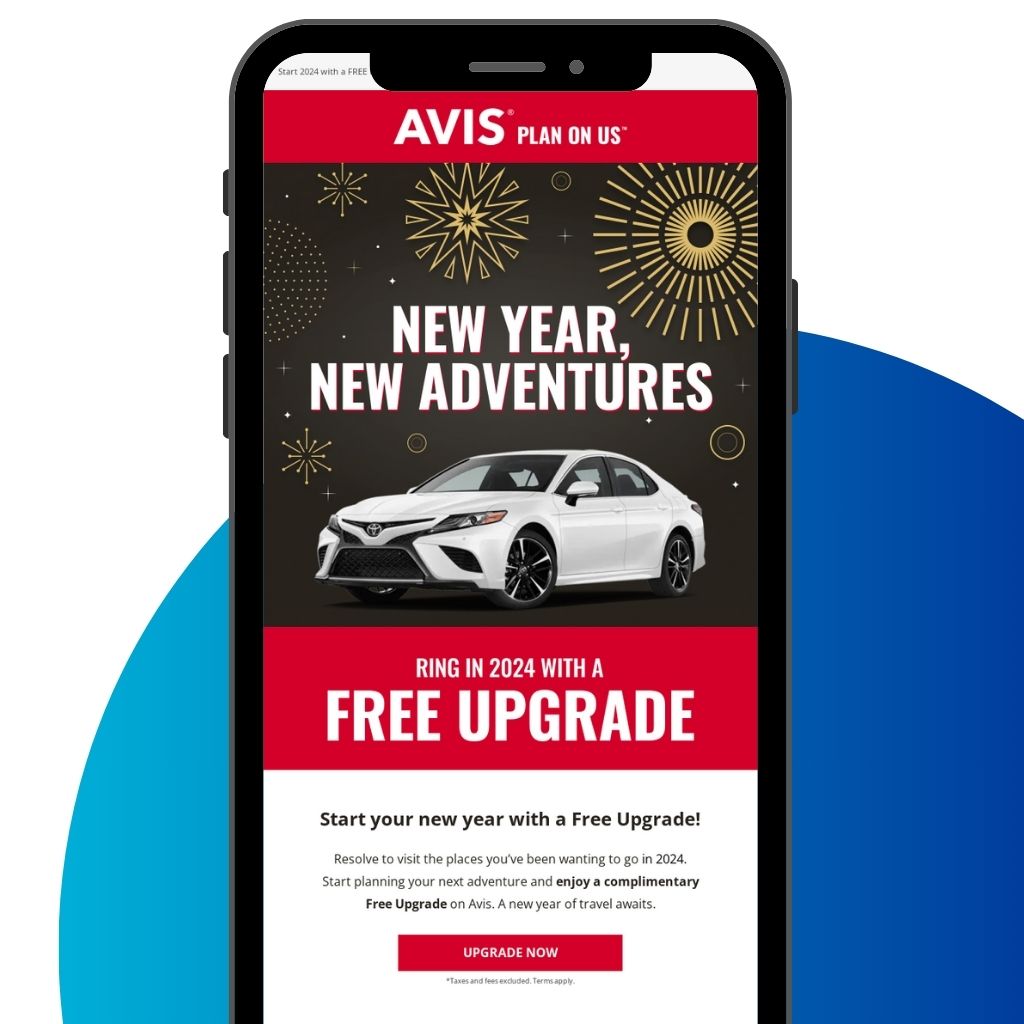
By understanding the benefits of marketing automation and implementing these recommended automation programs, you can streamline your marketing efforts, engage customers across multiple touchpoints, and enhance the overall customer experience while driving revenue and brand loyalty.
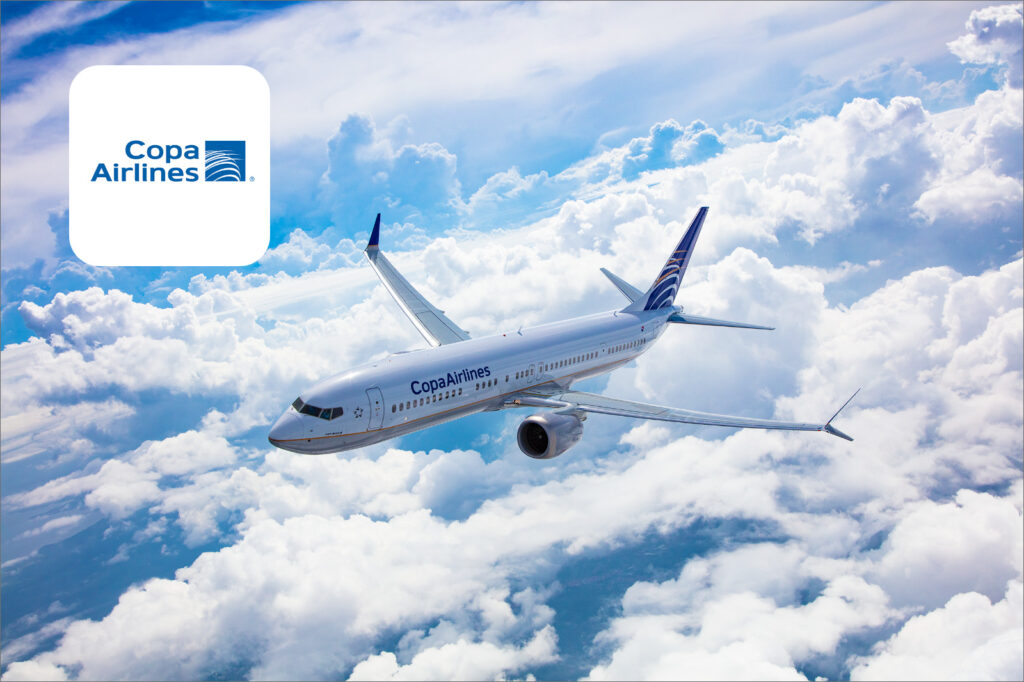
Marketing automation in action
Discover how international flight operator, Copa Airlines used Dotdigital to streamline its automated marketing communications to deliver a significant increase in revenue.
Web personalization for travel marketing teams
Web personalization involves tailoring website content to individual visitors based on their preferences, behavior, and demographic data.
In the travel industry, web personalization offers significant benefits and opportunities for enhancing customer engagement and boosting conversion rates. In this section, we’ll discuss the advantages of web personalization for travel marketers and provide strategies to create personalized online experiences.
Benefits of web personalization for travel marketers
1. enhanced customer engagement.
Personalized content and offers on your website can capture users’ attention and create a positive, engaging experience, increasing the likelihood of bookings and purchases.
2. Improved relevance
By addressing customers’ preferences and needs, web personalization ensures that your website’s content remains relevant and tailored to each user, making your brand more appealing to potential customers.
3. Increased conversion rates
Personalized content, offers, and recommendations can lead to an increase in customers taking action, whether booking a trip, subscribing to newsletters, or requesting more information.
4. Reduced bounce rates
An engaging and personalized website encourages visitors to spend more time exploring your offerings, reducing bounce rates and increasing the chances of customer conversions.
5. Improved ROI
By delivering personalized content and experiences to specific segments, web personalization can result in better use of marketing resources and a higher return on investment.
Strategies for personalizing web experiences
Show customers recommended travel destinations, offers, or services based on their current location, accounting for local events or geographic preferences.
Leverage customer behavior, such as browsing habits, pages visited, or previous booking history, to deliver personalized content, deals, or recommendations.
Divide your website visitors into specific segments based on demographics, interests, or travel preferences, and tailor website content to cater to these segments.
Implement exit intent pop-overs with tailored, last-minute offers or incentives that persuade visitors to book, subscribe, or engage further with your brand before leaving the website.
Use dynamic content that adapts based on user interactions, website behavior, or previous travel bookings, recommending related destinations, accommodations, or activities.
Employ remarketing campaigns that display personalized ads to users who have previously visited your website, featuring customized offers, messages, or promotions.
Integrate AI-driven recommendations into your website, providing visitors with personalized travel options across your homepage, product, and service pages.
Create dedicated, personalized landing pages for various promotions or travel offers based on customer segments, increasing the chances of conversions and bookings.
Push notification marketing for travel brands
Push notification marketing is a powerful tool for brands operating in the travel industry. It allows you to engage with customers directly through real-time, targeted, moments-based messages delivered directly to users’ mobile devices or web browsers.
Benefits of using push notifications in your travel marketing
1. increased engagement.
Push notifications give you new opportunities to re-engage customers by sending personalized promotions, announcements, and reminders. Ultimately, this enhances customer interactions and brand connection.
Timely and relevant notifications help you to communicate instantly with users, facilitating real-time updates on special deals, flight status, itinerary changes, or exclusive offers.
3. Higher conversion rates
By delivering tailored offers and targeted content, push notifications can increase conversion rates, driving bookings and encouraging customers to take action.
4. Improved user experience
Push notifications can enhance the user experience by offering personalized recommendations, location-based offers, and immediate assistance, fostering a stronger bond between customers and your brand.
5. Trackable performance metrics
Push notifications offer valuable performance insights, such as open rates, click-through rates, and conversion rates, helping you optimize campaigns and improve future marketing efforts.
Reporting and analytics for travel marketers
For marketers in the travel industry, maximizing efficiency and leveraging your budget and resources effectively is crucial. Utilizing advanced reporting and analytic tools can streamline and optimize your digital marketing efforts.
Advanced analytics and reporting tools
Email reporting and analytics.
Email reporting and analytics provide insights into the performance of your email marketing campaigns. This information helps you to:
- Identify trends in your email marketing campaigns
- Ensure your campaigns are meeting their objectives
- Pinpoint areas that need optimization to enhance campaign performance
Email dashboards
Email dashboards provide you with an overview of all your email marketing campaigns, while email reports focus on a single campaign, outlining key performance metrics. By getting a bird’s eye look at your email marketing campaigns, you can discover:
- Statistics about your delivered, bounced, and skipped emails.
- Data about opens, unique opens, non-opens, and social shares.
- A heat map showing the areas of the world where your email campaign was most opened.
- The most popular links in your campaign, clicks, unique clicks, and click-to-open rates.
- Details about your winning and losing split tests.
SMS reporting
SMS campaign reports monitor channel performance, enabling you to continuously improve your marketing results. These reports showcase:
Helps track the frequency of SMS campaigns and analyze performance metrics over time.
Measures the effectiveness of your campaign, comparing the number of clicks to successfully delivered messages, which can inform improvements in content or targeting.
Indicates the percentage of recipients who completed a desired action, such as booking a trip or signing up for a newsletter, helping to evaluate the success of promotional efforts.
Evaluates the total revenue generated by a specific SMS campaign, determining ROI and guiding budgeting decisions.
Provides insight into the revenue generated from bookings or purchases influenced by an SMS campaign, even if completed through different channels.
Informs segmentation strategy by showing the number of segment groups targeted in the campaign, helping you assess the depth and breadth of your reach.
Indicates engagement with SMS content by revealing the number of clicks on embedded links, allowing you to better analyze which messages resonate best with your target audience.
Measures the reach of an SMS campaign by tallying messages successfully received, helping to gauge overall marketing effectiveness.
Provides an overview of SMS campaign volume, enabling evaluation of the relationship between quantity and campaign success.
Program analytics
Dotdigital’s program analytics tools offer several benefits to travel marketers, especially by helping you optimize your marketing automation programs and maximize campaign impact. Key benefits include:
Program analytics provide a comprehensive and data-driven overview of your marketing automation programs, allowing you to make informed decisions about marketing strategies and tactics.
The visual representation of the different nodes in your marketing automation workflow enables you to gain a deeper understanding of your programs and quickly identify areas that require optimization.
Dotdigital’s program analytics tools allow you to monitor the performance of your marketing automation programs in real-time, enabling you to quickly adapt to changing trends and make necessary adjustments.
The detailed view feature allows you to choose between different chart views (trend and cumulative) to get a granular analysis of key program metrics, providing insights tailored to your specific needs.
By evaluating the performance of start nodes, decision nodes, and action nodes, you can better understand customer interactions and optimize your marketing automation programs to increase effectiveness.
Program analytics tools can help you identify the success of different segments and decision paths in your automation workflows. This allows you to refine your targeting strategies and drive better results.
The ability to analyze the detailed data and insights provided by program analytics tools enables you to streamline your efforts, eliminate inefficiencies, and allocate resources more effectively.
By providing in-depth data and insights on marketing automation programs’ performance, program analytics tools can help you optimize campaigns to maximize ROI. Through continuous improvement, marketers can generate better results and higher revenue, ultimately improving the overall ROI of their marketing efforts.
Advanced revenue attribution
Advanced revenue attribution is a method used to calculate the revenue generated by email and SMS marketing campaigns, based on clicks that lead to a purchase within a specified conversion window. Unlike direct tracking, which attributes revenue to clicks within a single window, advanced revenue attribution provides a more accurate and comprehensive assessment of how a campaign may have influenced the customer’s purchasing decision.
The benefits of using advanced revenue attribution include:
By tracing revenue to specific email and SMS campaigns, you can better assess the true influence of your marketing efforts on customers’ purchases, even if the purchase occurs outside the one-hour window of direct tracking.
Advanced revenue attribution offers a more complete picture of how different touchpoints contribute to your customer’s decision-making process, enabling you to optimize your campaigns for higher engagement and conversion rates.
Visibility into campaign performance through revenue attribution helps you to allocate budget and resources more effectively, focusing on campaigns that deliver the most significant ROI.
You can analyze the performance of email and SMS campaigns side by side, determining which channel is more effective at driving revenue and adjusting your marketing strategies accordingly.
By understanding which campaigns generate higher revenue, you can refine your targeting and segmentation strategies to engage the right audience with relevant and persuasive messaging, resulting in higher conversion rates.
Advanced revenue attribution can reveal patterns in customers’ behavior over extended periods, helping you identify crucial touchpoints for nurturing long-term relationships and customer loyalty.
WinstonAI™️ marketing intelligence engine
Designing a successful marketing campaign is far from easy. Especially in the ever-evolving travel sector, you must stay ahead of your competition. Embracing artificial intelligence (AI) at this early stage and leveraging it in your day-to-day marketing will improve the efficiency and effectiveness of your marketing efforts.
Benefits of early AI adoption
1. perfect personalization.
AI ensures you offer highly tailored experiences to your customers. By analyzing a vast amount of customer data, AI can identify patterns and preferences that are crucial for the creation of personalized marketing campaigns. As a result, your customers are more likely to be engaged and satisfied with their overall experience.
2. Data-driven decision making
AI-driven analytics provides you with actionable insights and data that help you make informed decisions. Early AI adopters can use powerful tools that analyze customer behavior, identify trends, and provide valuable recommendations. This ensures that your marketing resources are optimally allocated and drives higher ROI.
3. Time and cost efficiency
Adopting AI early on helps to streamline and automate your routine tasks. As AI can process a vast amount of data quickly, it saves time, increases productivity, and greatly reduces human errors. This frees up your time to focus on higher-value strategic and creative tasks.
4. Real-time optimization
AI provides real-time performance tracking and optimization opportunities for your marketing campaigns. By continually monitoring and adjusting, you can optimize your outreach methods, ultimately enhancing customer engagement, conversions, and revenue.
5. Competitive edge
Early AI adopters in the travel marketing sector will stay ahead of the competition by leveraging technologies that many competitors may not even be aware of. This provides a unique opportunity to gain market share and establish a brand reputation as a forward-thinking, innovative business.
WinstonAI capabilities
WinstonAI is Dotdigital’s industry-leading marketing intelligence engine, designed to simplify your daily marketing activity. Its ever-growing capabilities help you save time, money, and effort, further streamlining your market teams’ outputs.
Effortlessly create compelling content with WinstonAI’s innovative features, which include:
- Subject line assistant: WinstonAI helps elevate your subject lines by analyzing past engagement rates and generating inspiring suggestions for your next travel campaign.
- Email campaign assistant: WinstonAI not only offers alternative subject lines but also provides valuable feedback to refine your content. Get insights on tone evaluation and creative suggestions for your upcoming email campaigns.
- Grammar and spell check assistant: Eliminate time-consuming manual proofreading by using WinstonAI’s grammar check for emails, SMS, landing pages, and forms.
- One-click email to SMS generator: Save time by repurposing valuable email content into SMS messages for subscribers who prefer text messages. WinstonAI achieves this with just one click.
Transform your data into insightful actions with WinstonAI’s powerful analytics capabilities:
- Predictive analytics: Anticipate your customers’ behavior and adapt your marketing strategies accordingly, ensuring continuous engagement throughout their journey.
- eRFM segments and opportunities: Develop a deeper understanding of your customer base by integrating engagement scores with RFM (recency, frequency, monetary) ratings to create distinct personas.
- SCV and lookalike segments: Engage deeply with individual customer profiles using single customer view and generate segments with similar traits to your ideal customers.
Maximize your outreach potential and ensure your messages land at just the right moment with WinstonAI:
- Send time optimization: Enhance engagement levels by utilizing AI-driven send time optimization (STO) to deliver emails at the most opportune moment for the recipients.
- Automated reputation manager: Improve campaign performance and sender reputation by employing top-quality data that WinstonAI continuously monitors and evaluates.
- Watchdog data importer: WinstonAI’s data watchdog acts as a vigilant guardian of your sender reputation by safeguarding your delivery rates and thoroughly analyzing incoming email addresses.
- Non-human interaction (NHI) filtering: WinstonAI filters out activity from security tools or bots that can skew marketing results, providing you with a more accurate assessment of your campaigns’ performance.
Integrations and data management for travel marketers
From your booking systems and CRM to ticketing and customer service software, tech stacks for travel brands are vast and spiraling. The only solution is to have a customer experience and data platform that connects and unifies all your systems into a single source of truth. This will help you provide seamless and personalized customer experiences, streamline operations, and enable relevant and timely marketing activity.
Key integration and agency partners
CRM systems allow you to manage and analyze interactions with potential and existing customers. This helps to maintain and improve customer retention, satisfaction, and revenue generation. Integrating your CRM and marketing channel providers ensures you have all the data you need to provide data-driven marketing campaigns.
Integrations with booking platforms and reservation systems are crucial for streamlining traveler information management, allowing you to personalize offers and communications based on booking history and preferences.
Ticketing systems are vital for travel brands as they help manage and streamline customer support inquiries, leading to enhanced customer experiences. Integrating these into your marketing platform empowers cross-team collaboration, ensures timely communication, and improves customer retention as every interaction is accessible for marketers and customer service teams alike.
Loyalty programs play a significant role in retaining customers and enhancing brand loyalty for travel brands. Integrating these systems into your marketing platform helps you tailor rewards and offers to customers based on their preferences, purchase history, loyalty points, and other relevant data. Personalized rewards lead to higher customer satisfaction and engagement, strengthening brand loyalty.
Integrations with review platforms such as TripAdvisor, Feefo, and Trustpilot enable you to monitor customer feedback, identify areas for improvement, and showcase highlighted reviews to increase credibility and trust.

Integrations that deliver results
Discover how the Australian tourism board, Visit Victoria used Dotdigital’s Zapier integration to segment, personalize, and automate tailored cross-channel re-targeting campaigns.
Travel businesses need to understand the different types of marketing channels and tactics available to them to effectively promote their products, services, and experiences. By utilizing innovative strategies, personalized promotions, and data-driven insights, travel businesses can stand out from the competition, attract new customers, and retain existing ones.
The travel industry is constantly evolving, and you need to keep up with the latest trends and technologies to succeed in the highly competitive market. With the right marketing strategy in place, travel businesses can capitalize on the current post-COVID travel boom and take advantage of the many opportunities available in the industry.

Important notice: Beware of fraudulent recruiter messages on WhatsApp! More details on our LinkedIn profile
- Case Studies
- Partnership
8 Digital Marketing Strategies for Travel and Tour Agencies

If you own a travel agency or business based on tours and travel industry , you need to have a solid marketing plan to thrive. The modern travel industry is extremely competitive, so without a thorough strategy you may fall behind the competition. In this article, we uncover some of the basics of how to market your travel agency and use digital marketing for travel industry businesses. We will share a wealth of marketing ideas for travel-based businesses and help you benefit from travel agency promotion ideas.
Here are some tips for digital marketing strategy for travel agency businesses:
Content Marketing

All content you create for your business should add value to the reader. Offer advice, ideas, or inspire users and make them read more and come back to your page. A good content strategy should not only offer information but create a bond with your audience. Any written/video/podcast content you create should resonate with consumer needs of your readers.
Here is a bunch of ideas on how to find out what you can write about:
- Conducting user surveys will help you understand your audience and their immediate travel needs.
- Analyzing your most frequently asked questions is a good starting point in creating blog posts that will keep users staying on your site longer and coming back.
- Using keyword research tools will show you the most frequently browsed queries connected to your business. Using those keywords will help potential customers find you more easily.
SEO (Search Engine Optimization)
SEO is the core digital marketing strategy for travel agencies. It optimizes your website and content with the right keywords so your travel brand shows up prominently in local search results. This is a win-win approach while it boosts your website's visibility and attracts more visitors and your potential customers who are actively browsing for travel services and tours like yours. By consistently ranking high in search results, you establish your agency as a trustworthy source for travelers and upgrade the brand’s online visibility and credibility.

Looking for assistance in discovering the most effective keywords for your SEO strategy? Explore this article .
Search Engine Marketing (SEM)
Search Engine Marketing (SEM) is slightly different from SEO because it is about paying for top positions in search engine result pages (SERPs). Platforms like Bing, Google, and Yahoo provide various options to create paid advertising campaigns tailored to travel business. If you're seeking highly targeted results and want to avoid the lengthy process of organic SEO, SEM is your best bet. The SEM alternative will quickly boost your visibility by ranking higher for new keywords and giving your business a brand-new start. With SEM, you pay for each click your link gets, which is quite fair in terms of marketing budget optimization .
72% of individuals who initiate a local search end up visiting a physical store or location as a direct outcome of that search.
Overall, SEO is about focusing on a worldwide audience to achieve top search engine results. In its turn, local SEO helps you optimize your page to reach a hyper-specific and local audience. This marketing strategy for travel agency businesses is a great solution if you have a brick-and-mortar outlet and want to attract more local customers to visit your physical office. The strategy assumes using local keywords and placing data from your region on your webpage to target users who are seeking a travel agency in their area. You’ll also make your travel business far more visible on Google Maps.
Paid ads are an online marketing for travel agency business strategy that works like SEM. PPC advertising is displayed on other pages in your niche by Google or through social media. You can set up PPC campaigns for your travel agency with a persuasive sales copy to direct prospective customers back to your page and hook them to order in the tours they’ve been looking for. Paid ads come as a scalable strategy that depletes your budget whenever someone clicks on your link. The strategy l involves a permanent monitoring to ensure you are targeting the right users and pursuing an effective sales funnel consistent with your strategic marketing goals.
To learn more, read our article about the benefits of paid ads for travel companies.
Email Marketing
Email marketing works like a content marketing campaign. The strategy heavily relies on building an email list of your current clients and prospective clients . Here, you will need to create promotions to gather emails from users online and send out useful email content to a mass list as part of your travel agency promotion ideas. Creating a successful email list can take some time, though once you have a list of clients and prospective clients interested in your valuable travel tips or promotions on new tours, you’ll get rewarded with a high degree of converted sales and visits to your website from your email links.
We offer some ideas for your email marketing strategy in this article .
Review Management
All travel companies depend on reviews and your travel agency is no different. Asking each of your clients to leave a review on your service with a website like Yelp or Google Business reviews will come as a huge help in establishing trust with your prospects. A large number of your prospective clients will look for reviews or testimonials from your past clients and this is an organic and authentic form of marketing that has a significant impact on your business. That’s why it’s important to pay close attention to search engine reputation management .
Video Marketing

Creating high-converting video content is an excellent way to reach out to prospective clients on platforms like YouTube, TikTok, and Instagram. Digital marketing for the travel sector is changing and posting a video from your tour or hotels featured by your company can have a huge impact on someone who is scrolling through videos or is looking forward to spending a vacation. Video marketing can take work and coordination with the travel companies you work for, but it's a huge help with visual representation of what your customers can get. This is also about reaching out to prospective customers on new platforms.
If you have trouble with establishing a quality marketing strategy for your travel agency, working with a digital marketing agency will give you a boost over the competition. Working with professional marketers will ensure you have high-converting advertising and the best digital marketing strategies to skyrocket your business.

Content Marketing Manager at Promodo
Immersing myself fully in any topic I explore and my appreciation for simplicity are the driving forces behind my work.
You may also like
Check our similar articles
Choose quality and trusted services to improve the presence of your company on the Internet, and feel free to contact our UK team if you have any questions.

The demand for mental health services is higher than ever, creating a unique opportunity for therapists to grow their practices.

The core challenge faced by the overwhelming majority of addiction treatment centers is a lack of marketing effort.

Want to attract more potential customers to your therapy clinic with online advertising? Promod healthcare marketers are sharing the best strategic approaches.
Boost your effectiveness
We at Promodo are ready to help you improve your performance across all digital marketing channels.

Let us look at your business challenge from a different angle and share our ideas.
By clicking on “Send message” button, you agree to our Privacy Policy , and allow Promodo to use this information for marketing purposes.

- Creative Production
Scale your marketing efforts with ease using AI-powered creative automation
- Creative Operations
Run all your creative work in one place that follows your brand rules.
- Creative Analytics
Use powerful insights to boost the impact of your creatives.
Would you like a demo?
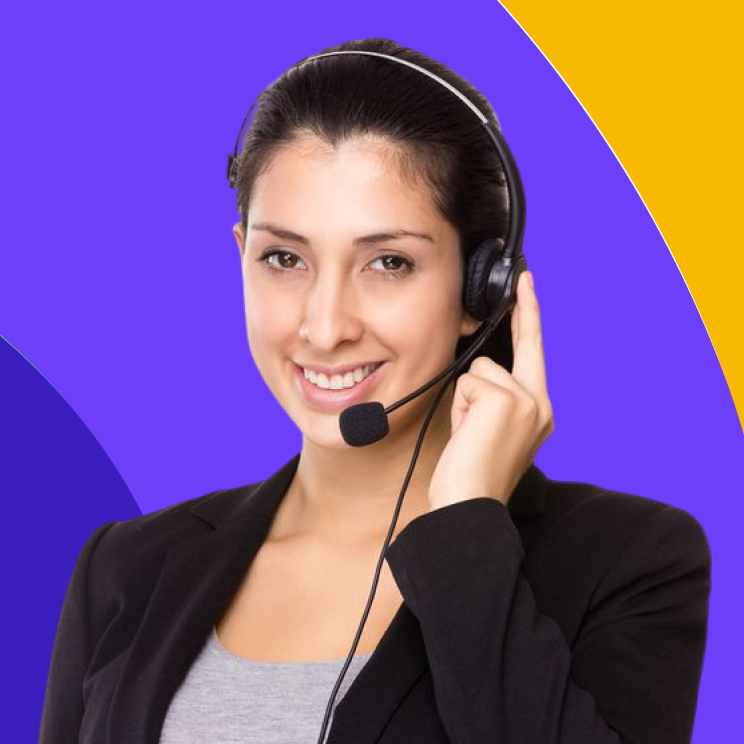
Arrange a meeting with us to assess if Rocketium is the optimal solution for your business needs.
- E-commerce Marketplaces
Supercharge visuals with agile CreativeOps for speed and scale.
- Retail Omnichannel Brands
Ensure consistent omnichannel presence.
- Large Enterprises
Empower teams to create visual content at scale.
By Use-cases
- Performance Marketing
Launch target campaigns faster
- Personalization
- Brand Compliance
Merchandizing
- Monetization
- Talent Branding
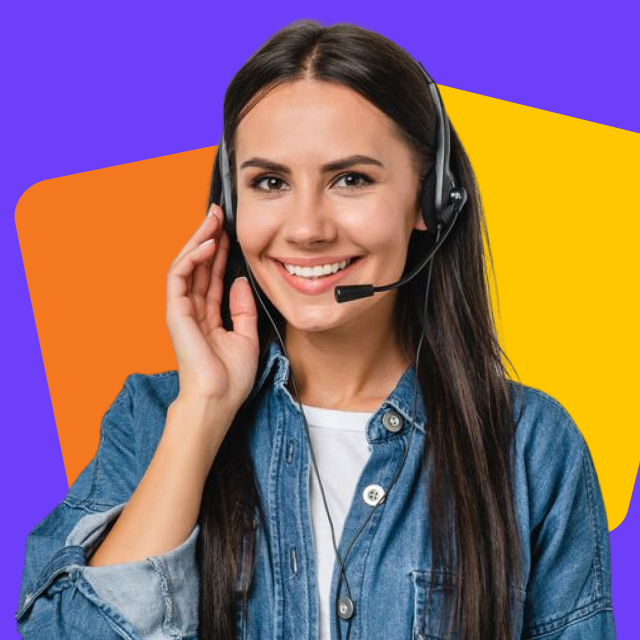
- Case Studies
Product guide
Featured blogs.
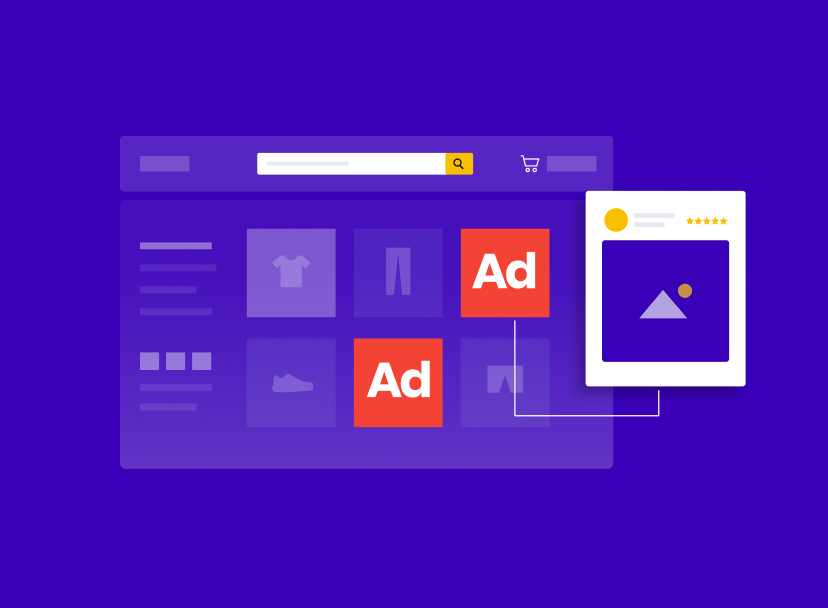
Agile CreativeOps: The Future of Retail Communication
Scale Creation with Creative Automation
Automate the creative production process with templatized creation, feed-based scale, and multi-point integration.
- 07 Sep 2021
Top 10 Travel Industry Marketing Strategies
The tide is finally turning for the $247 billion Indian travel and tourism industry after more than a year – and the excitement is palpable. With travel bans easing in many parts of the world, domestic and international traffic is rising. Nearly every business vertical – from hospitality and airlines to online travel agencies – has its hopes pinned on 2022 for a full recovery from the after-effects of the pandemic. The stage for revival is already set.
The hospitality sector has witnessed a wave of consolidation in mergers, acquisitions, and strategic partnerships over the last year. It will allow many small hotel chains to deliver complementary services while driving down operating costs. On the other hand, investor interest in the civil aviation vertical has soared, with as many as 90 new airlines expected to start operations around the globe by December 2021.
As a business enabler for other travel verticals, online travel agencies (OTA) will have a crucial role in facilitating the industry’s return to growth.
However, the high churn rate among price-conscious customers remains a challenge. In India, a waiting period for weeks, if not months, to book the right airfares is par for the course. Some bargain hunters are known to compare as many as 38 different portals at a time ! In the post-pandemic scenario, a poor lead to conversion ratio (or ‘look to book’ in industry parlance) can impact OTA margins, making discounts and offers unviable.
Moreover, the controversy over refunding canceled flight tickets that erupted at the pandemic’s peak just refuses to die down. For OTAs, this has underscored the importance of transparency and improving user experience across the customer lifecycle.
The good news is that brands have learned the lessons. Travel brands are adopting technology to interpret customer behavior and come up with customized travel industry marketing strategies.
10 Digital Marketing Strategies for Travel Agencies to Grow Post-Pandemic
In the new normal, travel agency campaigns will need to focus on the right messaging and target the right channels to drive engagement and growth. Asking the right questions will be critical to uncovering the best-performing travel industry marketing strategies.
Here are some real-life travel agency campaigns to get you started on the right track:
1. Pickyourtrail Adopts RFM Analysis to Drive User Engagement
In the new normal, retargeting ‘deal hunters’ who book and abandon bookings midway has been a priority for travel brands. Studies show that OTAs typically lose around 80% of all bookings due to the penchant for price comparison. For Pickyourtrail, a leading travel platform, the situation was no different.
A root cause analysis showed a gap in its customer segmentation strategy, which can turn buying intent into sales if appropriately optimized. The lack of automation meant that Pickyourtrail could not scale its messaging to target different cohorts rapidly.
After testing a few alternative approaches, the brand decided to segment users based on how often they visited their site, the time elapsed since their last visit, and average transaction value- also called RFM or Recency, Frequency, and Monetary Analysis.
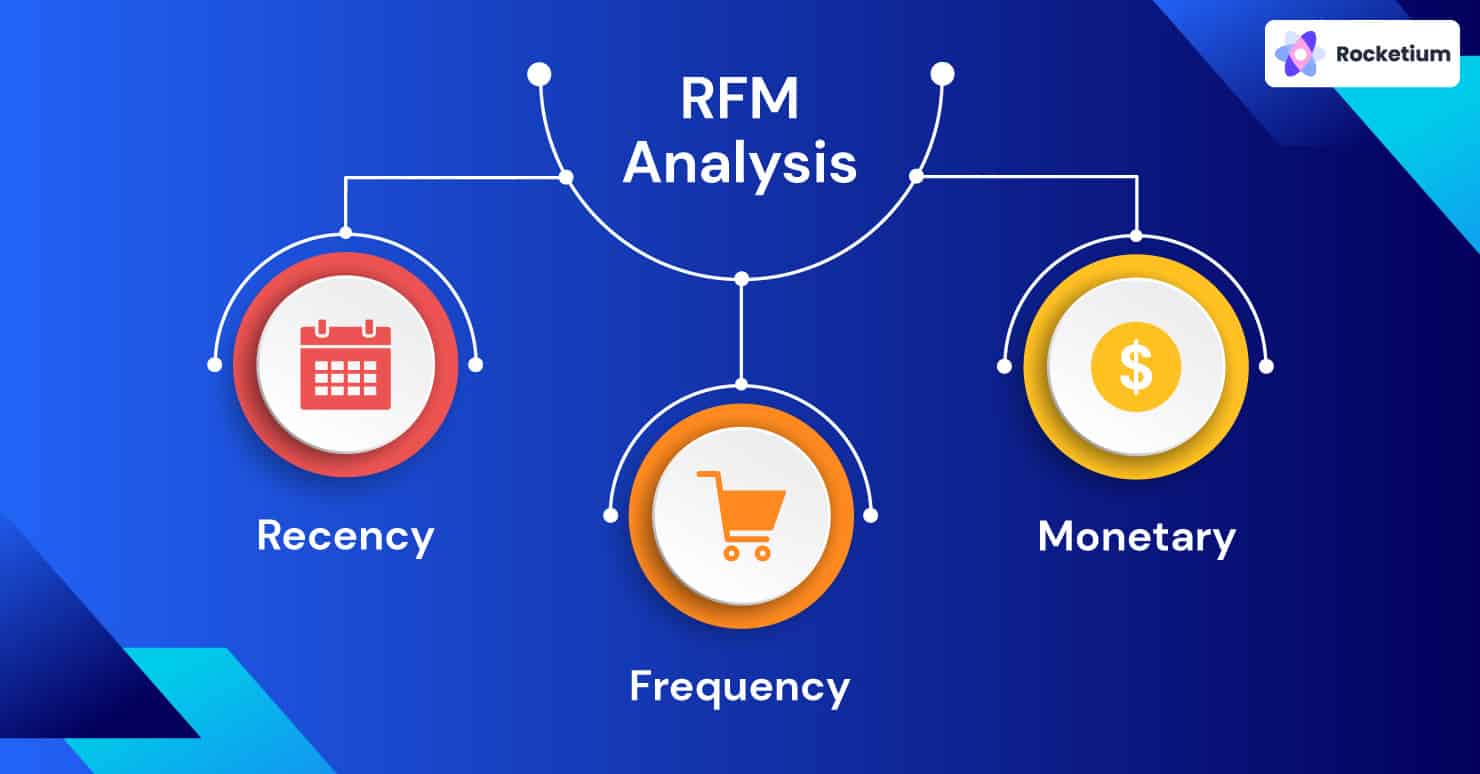
This ‘event-based’ segmentation strategy along with automated traveler engagement workflows allowed PickYourTail to re-engage deal hunters with hyper-personalized offers via email and SMS.
With 60% of online shoppers reporting that discounts became more important during COVID-19, catering to deal hunters has become an even more effective strategy.
Result : Email engagement registered a 50% increase while the team saved 60%+ man-hours that would have been otherwise wasted in manual tracking.
2. Headout witnesses ⬆️ in Conversion for First-time Visitors through Contextual Email Campaigns and drives 🔁 bookings through Personalized Audio Guides
Headout is an experiential travel marketplace that matches travelers to a variety of local experiences at an affordable price. Via a network of service partners, the company serves more than 3 billion travelers worldwide. However, Headout’s biggest challenge was a high bounce rate which meant that the company missed out on invaluable lead data.
In turn, this made it impossible for it to implement a viable retargeting strategy. The Headout team responded by rolling out onsite surveys to specific user segments such as desktop users.
The goal is to drive email sign-ups to the company blog, engage cart abandoners, and enhance the post-purchase experience. The company mapped its email funnel to the three customer journeys and ran contextual email campaigns to engage cart abandoners based on language and product category attributes.
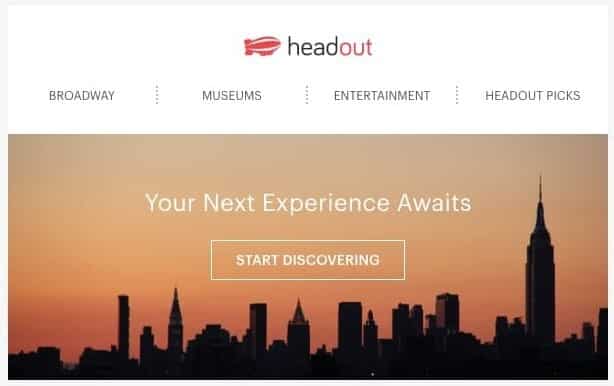
3. MakeMyTrip Leverages AI to Create Compelling In-App Content
As an early adopter of in-app content, MakeMyTrip has many firsts to its credit- curated destination videos, chatbot providing information on flight cancellations, and more. However, given its low monthly active user (MAU) frequency (typical for travel apps), the brand decided to leverage AI to stitch user data together and develop compelling creative for cross-sell and up-sell campaigns.
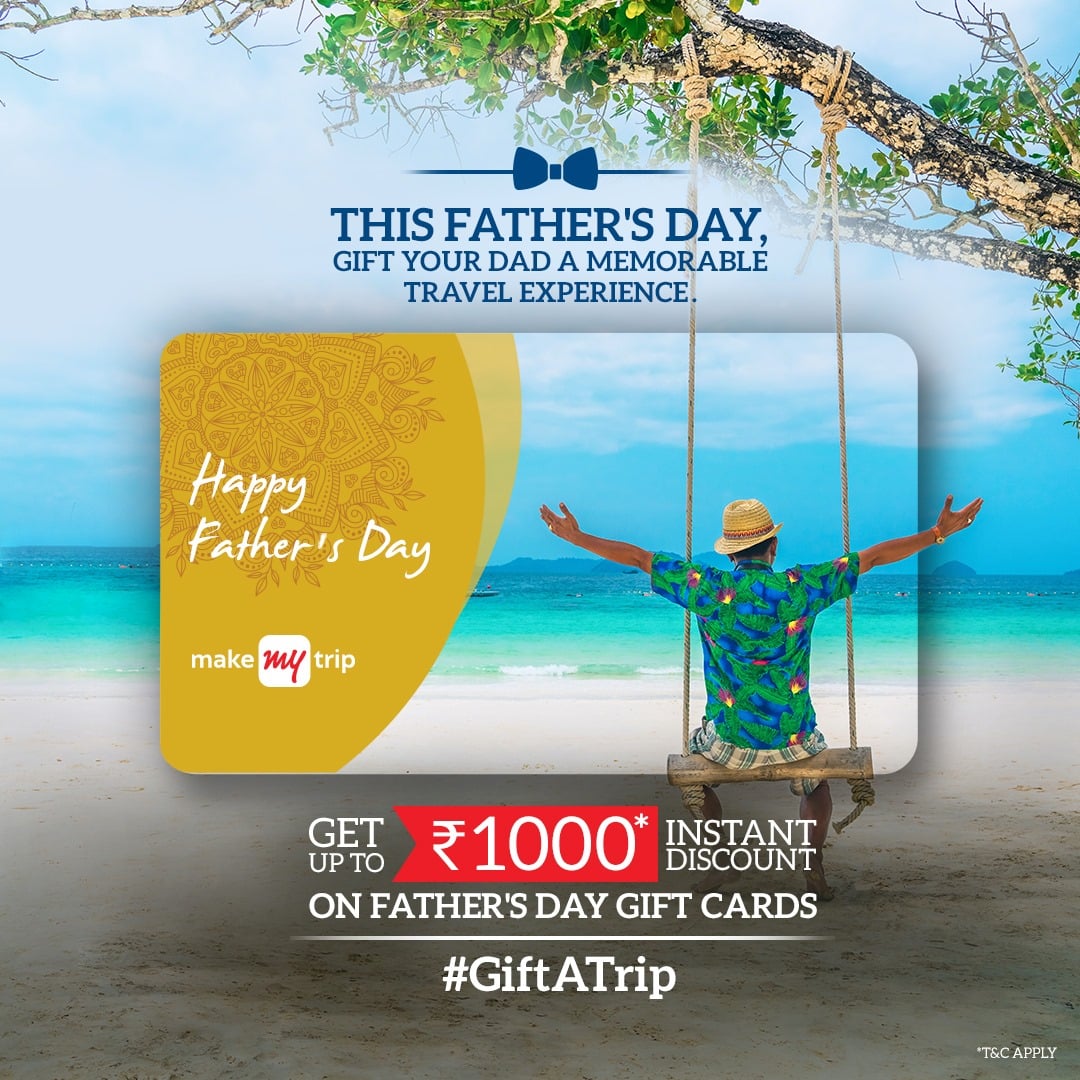
Relevant in-app banners on the storefront or homepage are particularly crucial to driving conversion. Secondly, seamless user stories that link one touchpoint, such as the initial display ad, to the other (checkout page, for example) has been a key element in the MakeMyTrip marketing strategy.
To drive repeat bookings, Headout introduced personalized audio guides in multiple regional languages. The audio guides featured tips and recommendations on popular tourist destinations with blended marketing content. The company has since witnessed 27% growth in conversion for first-time visitors, 90% faster campaign implementation, and a 10% reduction in cart abandonment.
4. Travel Triangle ⬆️ Conversion among Booking Cancellation Cohort and Returning User Cohort by adopting a Lead Scoring System
Since its inception in 2011, Travel Triangle has emerged as one of India’s leading OTAs, operating in over 60 countries. However, apart from a high drop-off rate at the top of the funnel, the company also struggled with booking cancellations at the post-purchase stage.
This affected not just the cost of customer acquisition but also customer lifetime value. As part of a long-term strategy, the company adopted lead scoring to prioritize high intent buyers based on website heat maps and email/SMS CTR.
This helped them understand the reasons for drop-off and build a pipeline of ‘hot’ leads, which could then be nurtured via personalized SMS and push notifications. With the help of analytics, Travel Triangle also optimized its travel industry marketing strategies for converting returning users. It began focussing on not just the messaging but also the channels most preferred by travelers.
These measures have paid off quite well for the brand, with conversion among the booking cancellation cohort increasing 10% and that for the returning users cohort by 20%, respectively.
5. Treebo Leverages On-Site Messaging to Drive Conversion
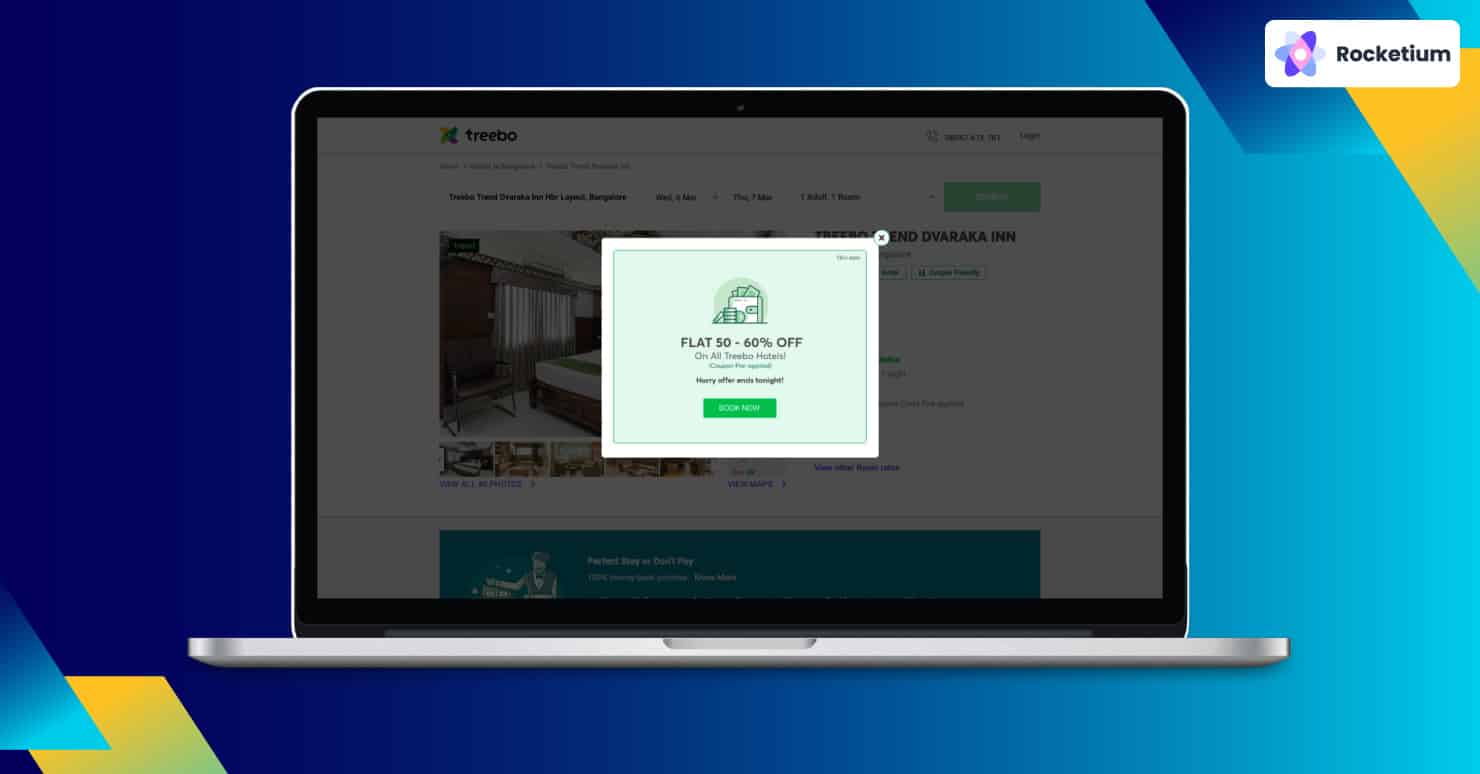
Differentiation in a saturated market can be a formidable challenge, especially for hotel startups. While Treebo ranks right up there with the likes of OYO and FabHotels in the budget hotel segment, it still faced problems building brand recall and attracting returning users – especially on digital channels like its website and app.
A series of User Experience (UX) studies later, the company realized that it needed to streamline its booking interface.
The company experimented with personalized on-site messaging to drive conversion across multiple cohorts. This included timer-based sticky banners that replaced SMS/email notifications. In addition, Treebo also used exit-intent pop-ups to curb the price comparison instinct and close bookings faster.
The results of the travel agency campaign have more than met the company’s expectations – a 15% increase in web conversions.
Also Read: 5 Proven Steps of Conversion Optimization from a Growth Expert
6. fabhotels overcomes spam blockers to increase email open rates:.
The team at FabHotels knew it had a challenge on its hands when its email marketing campaigns were flagged as spam by most email providers. Unfortunately, the problem persisted for two years before the company finally identified the cause- a drop in domain reputation. In other words, after a certain volume was reached, its travel agency campaign emails were being automatically marked as spam.
The company started to test for the exact volume and any underlying factors that triggered the drop. They introduced a 3-step action plan to counter the problem – a micro-segmentation strategy to improve inbox placement, staggering the email send times, and limiting the number of emails to one per customer per day.
The company also revised the layout and copy of its emails, reducing the number of images and hyperlinks.
The results were dramatic. With a 90% increase in email delivery rates, FabHotels also saw a matching 90% increase in open rates. This has allowed it to scale its campaigns threefold.Learn how to optimize your content to improve email deliverability
7. Shuttl Speeds Referral Conversion with Trigger Campaigns
Bus-aggregator Shuttl had been eyeing referral marketing as an organic customer acquisition channel to augment its paid campaigns. In terms of cost-effectiveness, referral marketing has few parallels; however, finding the right users and nurturing new leads was a challenge for the company.
In addition, tracking the right conversion metrics was equally important to deliver the right messaging.
The team at Shuttl experimented with two distinct but interdependent trigger campaigns – a 1+1 offer that enabled a traveler to gift a ride to another person. This travel agency marketing strategy made it possible for Shuttl to quickly identify customers who are most likely to refer.
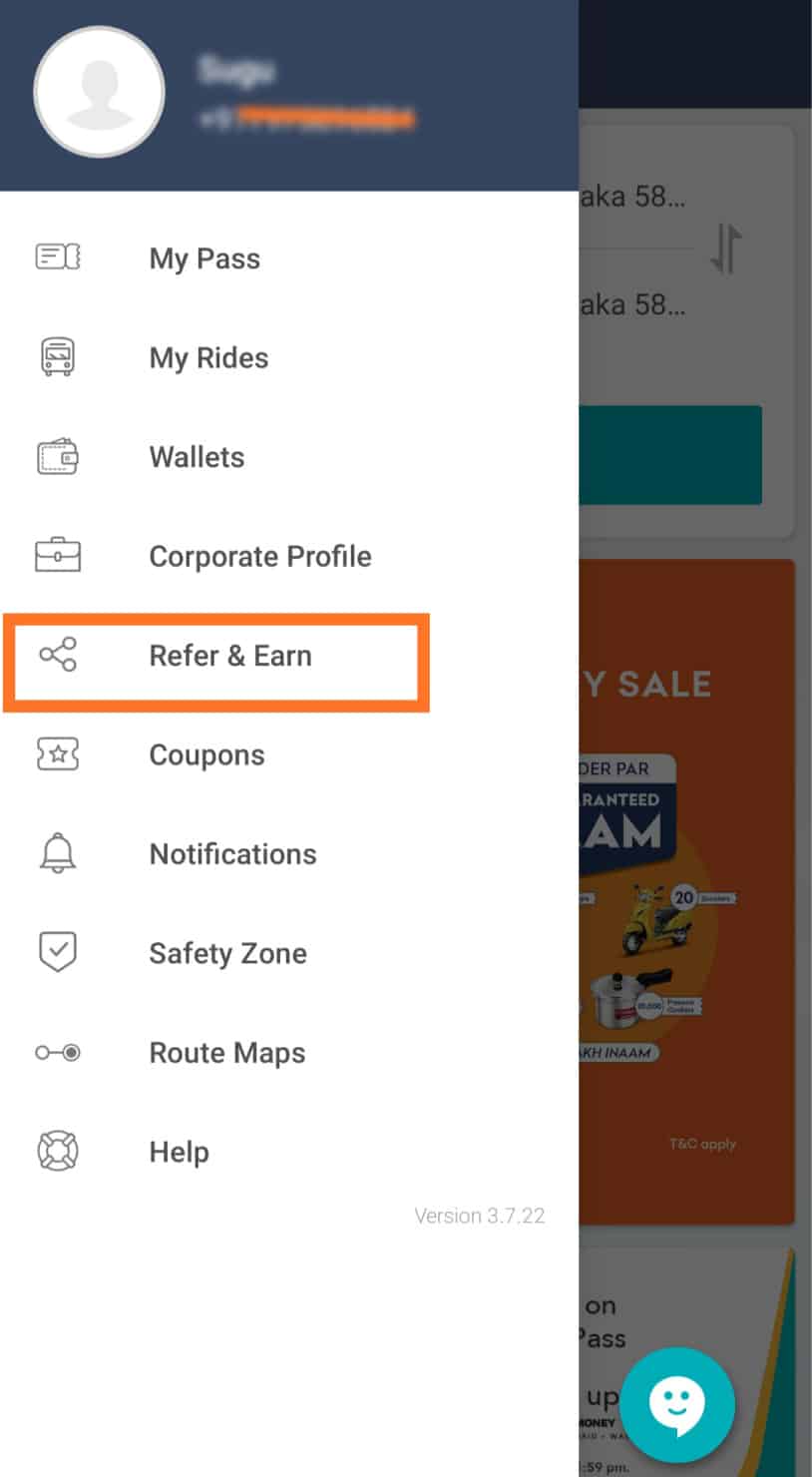
As soon as the original traveler submits the phone number for the referred person, the second campaign is activated. It triggers a series of emails to drive the newly-referred user to install the Shuttl app and book new rides.
In a span of two months, the campaigns accounted for an 11.2% increase in total referrals, while the subscription rate for new users jumped 3.6% .
8. Yatra Optimizes Web Notification Campaign Rules to Boost Conversion
For Yatra, India’s second-largest OTA, traveler drop-off on the booking review page was a persistent problem. The company realized it needed a new workflow to help them overcome last-minute hesitation and drive conversion. Given the high uninstall rate of mobile apps, Yatra decided to leverage web push notifications to do the job.
Abandoners were sent four reminder notifications every 48 hours until they converted. The company’s data showed this to be the optimum frequency for engagement, beyond which it could be considered spamming. In addition, they optimized campaign rules to automatically terminate the workflow once the user took the desired action.
The idea proved successful, with gross booking growing by 3.2% and the company discovering a new channel in the process – mobile web.
9. Go-MMT Adopts Dynamic Segmentation to Create Cross Channel Campaigns
As India’s top OTA platform, Go-MMT derives its competitive edge from the user experience of its hotel partners just as much as end-customers. So the company wanted to enable new hotel partners to list themselves faster on its platform, improve mobile app and web engagement, and drive conversion. This meant consolidating listing data in a single location, tracking partner performance in real-time, and leveraging native demand to increase partner loyalty.
The existing processes at Go-MMT were inefficient and inflexible. Manual segmentation of hotel partners, manual mapping of listing history, and marketing communications being sent to international partners as per Indian Standard Time (IST).
In time, Go-MMT implemented a solution that resulted in a 20% increase in partner engagement, thanks to the consolidation of listing data and dynamic segmentation based on the country of origin and type of property.
This allowed the brand to build cross-channel journeys for running travel agency campaigns as per partner time zones.
10. OYO’s Drives 8X Growth in Omnichannel User Engagement with Personalized Offers
Market leader OYO encountered challenges with user engagement even as it started moving to a franchise model from the aggregator model. The brand’s growing user base was highly fragmented and relied on multiple channels to search for, compare and book reservations.
Its priority was to scale its travel agency campaign while unifying the customer experience to drive conversions and revenue growth.
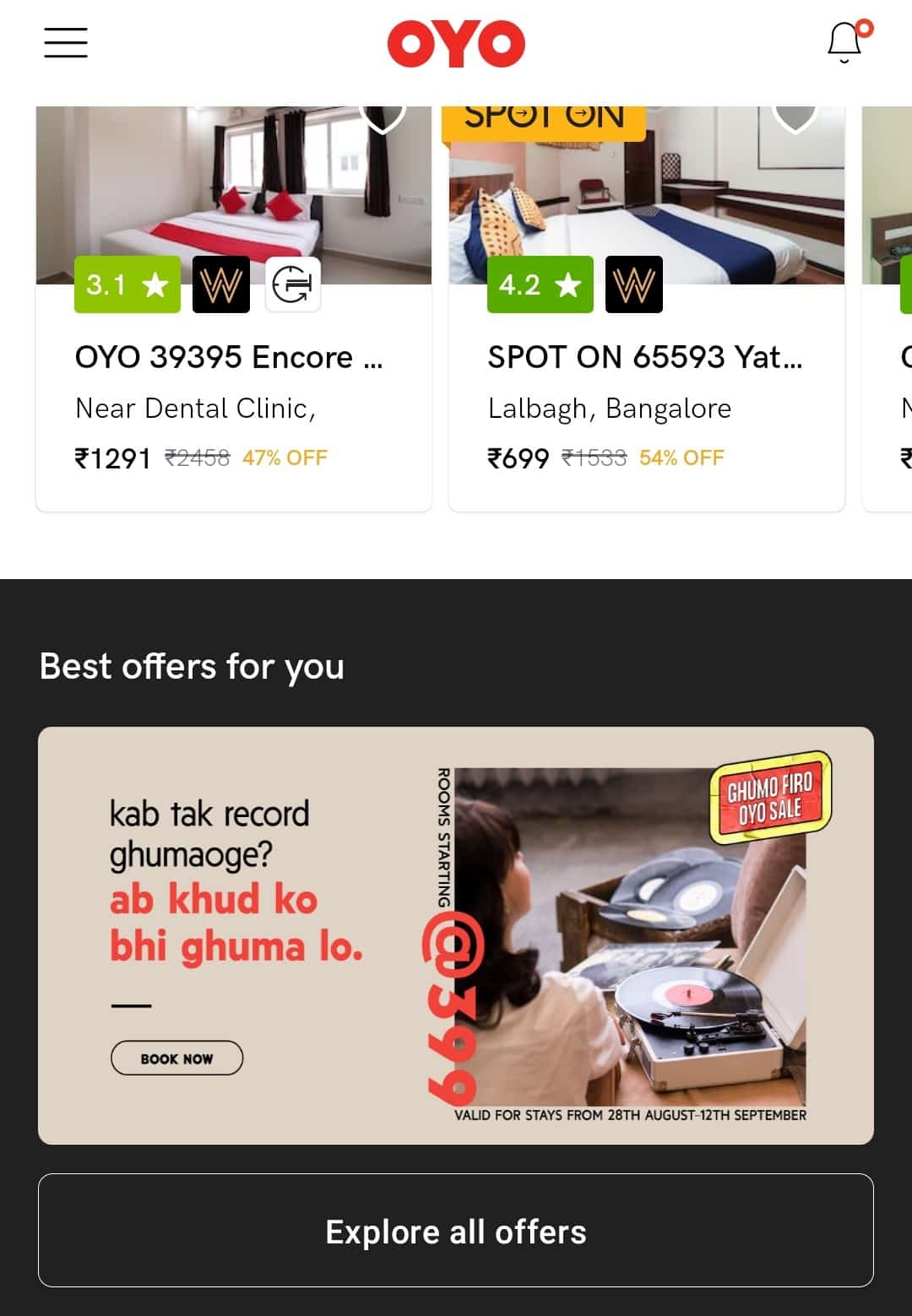
The company decided to target the deal hunter cohort by creating personalized offers based on browsing history. It also ramped up retargeting efforts via social media and in-app content.
How To Create: Hyper-Personalized In-App Content at Scale
The payoff has been substantial, with an 8X increase in engagement campaigns and 5X growth in CTR.
Final Thoughts
Rocketium helps businesses deliver hyper-personalized digital campaigns at scale for a fraction of the time and resources that would have otherwise been required. Our suite of world-class products empowers teams to focus more on the creative strategy. As a result, marketers can devise a more innovative and effective digital marketing strategy for travel agencies.

Rethin Vipinraj
Leave a reply cancel reply.
Your email address will not be published. Required fields are marked *
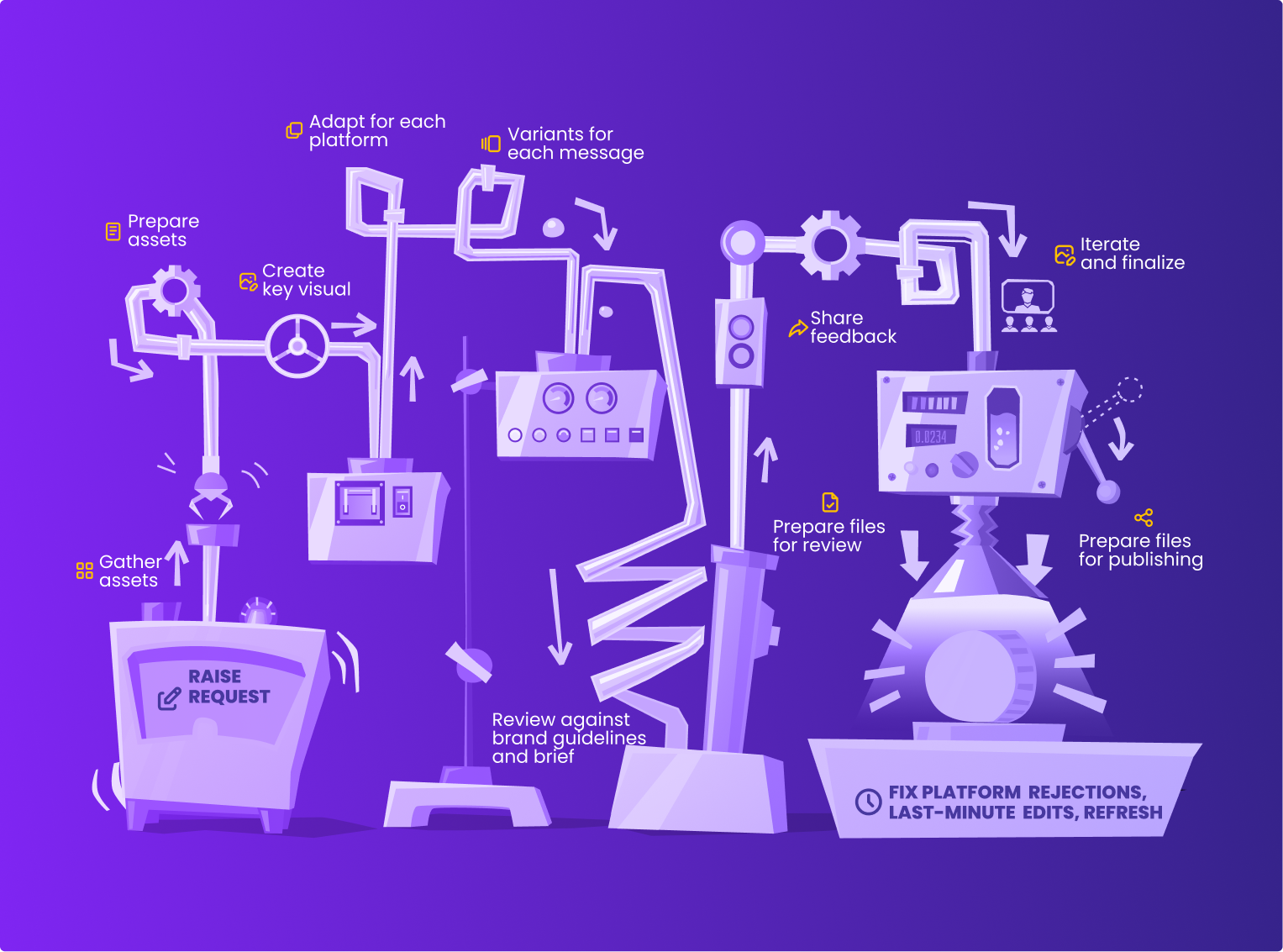
The new creative operations journey: Untangling the Rube Goldberg of enterprise communication

How Automating Ad Creation Aids Creative Marketing
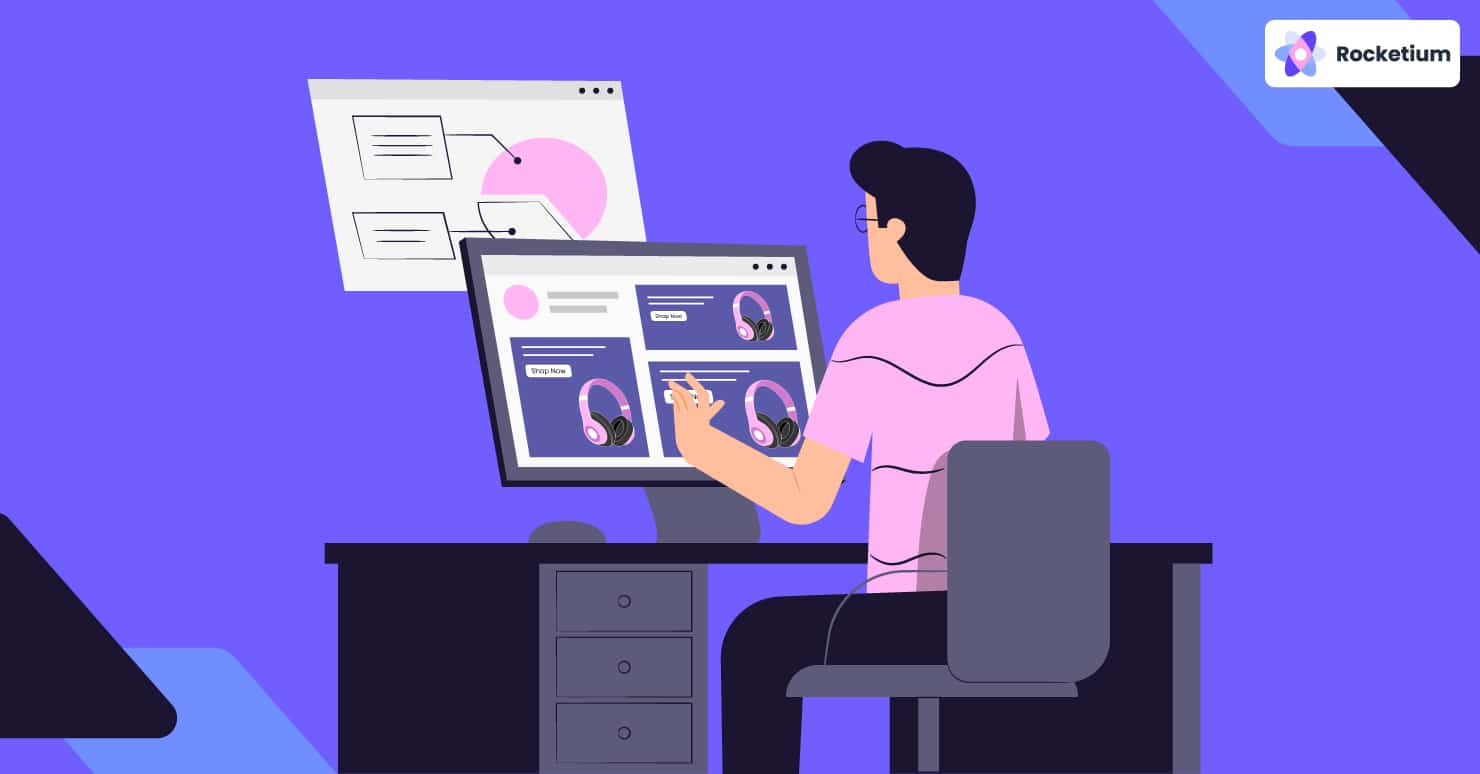
Why Marketing Design Software Represents a Generational Leap for Online Advertising Success
Subscribe to our newsletter.
Recieve such insightful content on Design & Marketing every month!
Get Your Monthly CreativeOps Recap
Thank you for subscribing.
Everything you need to know about CreativeOps for marketing and design teams, brought to you in minutes.

Company Type
- Merchandising
- Product Guide
- Cookie Policy
- Privacy Policy
- Terms Of Use
- GDPR Compliance
- Terms & conditions
- Privacy policy
Effortless booking
Maximize online conversions with the most intuitive checkout online.
Expand revenue with our powerful Automated E-commerce tools.
Upgrade your website to industry’s best. Fresh websites. Fresh revenue.
Amplify visibility and expand earnings with integrated OTAs and local partners.
Streamline check-ins, limit risk, and amplify customer data with built-in digital waivers.
Transform data into insights. X-ray reporting gives you customer and business intelligence.
Manage high-volume walk-up customers effortlessly with POS, ticketing, and gated entry.
Automate management of staff schedules, assignments, and staff communications
Control your business precisely the way you want with endless yet easy configurability.
Allocate equipment used in various products. Prevent overbookings and maximize profits.
Grow with Xola in our constantly expanding universe of integrations and apps.
Harness customer data to drive marketing campaigns and generate repeat business.
Transform your guests into passionate brand advocates. Perfect your products & services.
Manage your business with the most powerful mobile suite in the industry.
Perfect the guest experience by giving your staff the industry’s most intuitive software.
Efficiently manage guest flow, minimize wait times, and ensure maximum satisfaction.
Ticketing & Entry
Revolutionize your guest experience: Effortless check-ins, interactive displays, secure payments.
Boost revenue with automated rave reviews, actionable insights, and loyal customer engagement.
Efficient ticketing, digital waivers, and fast check-ins enhance on-site operations and guest satisfaction.
Explore Xola Universe: 80+ apps, limitless integrations, endless growth opportunities.
Simplify check-in and boost your marketing efforts with our integrated automated digital waivers.
With SOC 2 Type II and CCPA compliance Xola exceeds industry security standards and insures your data protection.
Access real-time insights for business growth with our powerful reporting.
Remarkable and hassle-free guest experiences with waitlist and virtual queuing.

AI dynamic pricing use cases for tours and attractions
- Xola University
Digital marketing travel trends for tour and activity operators

The digitization of the travel industry is nothing new. So it should come as no surprise that when a pandemic put a halt on travel, tour operators turned to virtual experiences and social media to keep customers engaged.
Travel companies from airlines to small activity operators doubled down on their travel digital marketing initiatives to stay relevant in 2020, even when bookings were nonexistent.
For many, that meant adapting to new online marketing trends to capture an audience that’s spending more time on the internet than ever before. Despite the limits on travel, there’s never been a better time for tour operators to connect with customers in new and engaging ways.
In this post, we’re breaking down the key online marketing trends that tour and activity operators should focus on in 2021.
Why is digital marketing important for travel and tourism businesses?
The pandemic has changed the way people shop, communicate and work online. The average U.S. adult now spends a total of 16 hours a day on digital media, up from an already high 12 hours a day before the pandemic.
With so much time spent at home, people are also using social media more than ever . Travelers especially are increasingly using visual platforms like Pinterest and Instagram to dream about and plan for future trips.
As a tour operator, you can use the latest travel digital marketing trends to stay relevant in your niche. Whether it’s through blogging, video content, or posting on social media, it’s important to engage with your prospective customers on the platforms they’re using on a daily basis.
How digital marketing has changed the travel and tourism industry
Today, guests can and do book everything from hotels to local attractions with just a few clicks online.
And guests are increasingly researching what to do in a destination online, too. In the three months leading up to a trip, a study found that there are three times more online searches for experiences and activities than hotel searches. When guests arrive at their destination, they do most of that research on their phones.
That’s why the tourism industry is increasingly turning to social media, search engines and email marketing to reach customers. And tour operators are following suit.
You can use these same outlets to target your guests where they’re already hanging out. Even if you’re not generating tons of bookings right off the bat due to the current state of the travel market, you can build brand awareness and stay top of mind by focusing on top digital marketing trends.
6 top travel digital marketing trends in 2021
The pandemic may have grounded travel, but tour and activity operators found ways to remain relevant.
As bookings disappeared and people were forced to stay home, companies doubled down on online marketing. From appealing to staycationers and virtual experiences to video marketing, here are six online travel marketing trends that can drive more bookings in 2021.
Virtual tours and experiences
Virtual experiences were launched around the world to keep customers engaged during lockdowns last year.
These experiences ranged from cooking classes to walking tours, all done online. Even Amazon jumped on the trend with Amazon Explore, a platform that offers virtual tours and experiences led by experts around the world.
Virtual tours became an exciting new way to “travel from home,” a catchphrase that became increasingly popular over the course of 2020. It became a way for people to safely escape their mundane work-from-home routines.
And some tours were certainly successful: More than 40,000 people expressed interest on Facebook for a virtual walking tour of Reykjavík over the holidays last December.
While some operators say online experiences didn’t help generate much revenue, it looks like they’re here to stay . At the very least, operators agree that offering virtual experiences during the pandemic helped generate awareness for their brands.
Instagram stories & reels
Instagram’s latest feature called Reels — where people share short-form video content soundtracked to trending songs — is a great opportunity to reach a new audience.
The app is favoring accounts that are using the new feature regularly, meaning it’ll show your videos to a larger audience if you’re consistently posting.
The content you post on your Instagram feed is typically only seen by the people already following you, but your Reels have a greater chance of reaching a new section of the “Explore” page.
This is where people that don’t follow you can find and engage with your content and hopefully follow you if they like what they see.
Not sure what to post on Reels? Here are a few tips to get you started:
- Many Reels revolve around popular trends, such as a funny dance or a viral song. Keep an eye on trends and brainstorm ways you can adapt them to your niche.
- A great way to gain exposure through Reels is to work with influencers who are seen as authority figures in your region. You can invite local influencers on your tours and have them share Reels about their experience.
- Use Reels as a way to tell your brand’s story and engage with your audience on a more personal level.
- Add value to your audience by teaching them a new skill.
- Look at how other brands in travel and tourism – like the Official Miami Beaches Instagram account – are successfully using Reels.
TikTok marketing
TikTok is another video-based marketing channel that grew wildly popular over the past year. The video-sharing app was one of the world’s most downloaded non-gaming apps in 2019. By 2020, it was No. 1.
During the pandemic especially, many people took to the app to share about past travel experiences and the things they missed about normal life. It became quite easy for videos to go viral, with thousands of views trickling in by the hour.
Brands quickly caught on and began sharing videos establishing themselves as authorities in their niches.
As a tour operator, you can experiment with short-form videos about your tours and destination at little to no cost. Your videos have the potential to reach thousands of new viewers, which can convert to future customers once it’s safe to book activities again.
Tip: You can cross-share your TikTok videos on Instagram Reels and vice-versa.
Data-driven marketing & business intelligence
Every successful online marketing strategy is backed by data and analytics.
If you use booking software, you likely have access to all types of indicators such as revenue metrics, customer demographic breakdowns, and the types of products your guests are purchasing.
These metrics allow you to tailor your marketing campaigns to your existing customers.
Xola offers a variety of revenue-based reports , for example, that show how much revenue you’re bringing in, your most popular listings and which marketing campaigns are leading to the most bookings.
When you know what’s working best for you, you can model future campaigns after it.
Google Analytics is another pot of gold for marketing metrics. You can use Google Analytics to differentiate between the revenue generated by your activity offerings, add-ons, or gifts.
In other words, you’ll get a better understanding of where your guests are spending the most money.
It can also tell you which channels are bringing in the most revenue, so you know exactly where to focus your energy.
SEO stands for search engine optimization, which refers to the process of creating a website that ranks well on Google.
Why is ranking on Google important? When your website ranks among the first 10 results for any keyword on Google, your traffic increases. Your website is your most powerful booking tool, so the more people on your site, the better.
The easiest way to increase your web traffic is to blog about topics relevant to your audience. If you offer destination-specific tours and activities, you can use your blog to establish yourself as an expert in your destination.
Overall, your blog content,as well as your tour and activity descriptions, should focus on the keywords your customers are likely searching for on Google.
The people who land on your site are more likely to convert since they are specifically searching for those topics. Blogs are also a great way to increase the time people spend on your site, which can also lead to more bookings.
Pro Tip: Your blogs should target long-tail keywords like “top things to do in ‘YOUR CITY.’”
Instilling consumer confidence
The final digital marketing travel trend we’re highlighting is consumer confidence.
Safety will be top of mind for guests as they begin venturing away from home. Making your guests feel safe and confident enough to partake in any sort of social activity will be incredibly important moving forward.
Airlines, hotels, car rental companies, and tour operators are already marketing safety measures like social distancing and extra sanitization as a selling point.
An easy way to do this is to work with your booking software to ensure your company is following all the proper safety guidelines. Xola, for instance, offers social distancing software to accommodate these changes.
When you ensure your customers you’re doing everything to keep them safe, you’ll give them the confidence to book with your company.
In sum, these are the key online travel marketing trends that’ll help you drive more bookings in 2021. As travel ramps back up, adopting these trends into your own marketing strategy will ensure your company stays relevant in a post-pandemic world.
Writer Carla Vianna
Related Articles
As tours and attractions seek ways to stay competitive through their experiences, they must also consider innovative ways to maximize

The 3 Factors That Will Increase Your Ranking on Tripadvisor
Improving your ranking on TripAdvisor isn’t as simple as “more reviews, higher rankings”. The truth is much more nuanced. Tour and activity operators who understand TripAdvisor’s Popularity Ranking Algorithm will have more success on the platform, getting higher rankings and more bookings.

Top experiential marketing news sites to stay ahead of the curve
Whether you’re seeking inspiration for your next campaign or eager to learn from successful experiential marketing initiatives, knowing where to
Get the latest news and resources.
For tours and attractions delivered straight to your inbox each week.
Transform your business now.

Expedia Group Media Solutions

The world’s leading travel media network
Our advertising solutions help you inspire, engage, and convert hundreds of millions of travelers — everywhere in the world.
Sign up for our Travel Marketing Insider Newsletter to stay up to date on the latest travel industry trends
Unmatched global inventory that travelers access every day
We connect thousands of advertisers around the globe with the most highly valued travelers. Every day, travelers visit our websites to dream about, search for, and book their trips. The advertising solutions and targeting capabilities we offer help you engage with those travelers and deliver the results you want.
average daily visitors across our sites and apps*
trips booked through Expedia Group*
booking sites in more than 75 markets and 40 languages*
Look and book with our immersive travel tech
As travel evolves, so does our technology. That’s why we built the industry’s first streaming platform that delivers a wholly unique experience for travelers.
This innovative approach to travel advertising gives travelers a firsthand view of what it’s like to be a tourist at various destinations. The videos our Media Studio team creates brings these locations to life, from road trips through the California desert to kayaking the Potomac or sitting down with filmmaker Spike Lee to talk about Brooklyn, New York. This immersive experience lets travelers shop for and book travel as they’re watching the content, putting a whole new spin on tourism marketing as entertainment.
Explore unexpected places with the GoUSA TV series

Travel advertising that delivers results
We’ve got decades of experience helping advertisers bring travelers to their destination, book hotels and flights, and more. We get you to the right traveler at the right time and through the right channel. You need someone who understands the travel business better than anyone else, and that’s Expedia Group Media Solutions.
Flexible advertising solutions
Solutions that work for any business — and any budget.
Find your ideal traveler
Actionable data insights and targeting capabilities to put you in front of the right people.
Real-time data
Robust reporting to monitor and optimize your campaigns.
Why you should partner with Expedia Group
Our unique capabilities and custom digital media solutions meet your needs and bring your brand to travelers.
TravelAds Sponsored Listings
In the competitive hotel market, it’s essential to stand out from the crowd. TravelAds is a simple, proven solution with a pay-per-click approach designed to increase your hotel’s visibility with travelers. Use TravelAds to:
- Boost room bookings.
- Drive incremental revenue and profitability.
- Reach the right travelers.
- Control your cost-per-click and daily spend.
- Create customized copy and images.
Accelerator
Like TravelAds, Accelerator, our cost-per-stay solution, is a budget-friendly and effective way to gain visibility with travelers. Use Accelerator to:
- Boost your visibility in search results.
- Scale up or down as needed with an easy-to-use platform in Partner Central.
- Cost-effective: You only pay when you receive a booking.
Co-op campaigns
Make an impact with a collective and cost-effective advertising solution that will extend and amplify your marketing spend. Co-op advertising allows you to:
- Connect with other destinations, hotels, airlines, and more to jointly engage with travelers and drive demand.
- Easy and simple: We secure similar strategic partners for you.
- Stretch your marketing budget.
Media Studio
Get access to our award-winning in-house creative agency to create immersive and compelling interactive experiences that engage travelers. With Media Studio you can:
- Create videos that tell your brand’s story in a unique and unforgettable way.
- Use emerging technology to stand out.
- Build engaging social media campaigns and work with influencers.
Display advertising
Build a full-funnel experience that inspires, influences, and converts travelers. With display advertising you can:
- Reach the millions of travelers who visit our 200+ websites every day as they dream, plan, and book travel.
- Design ads that seamlessly integrate across all our sites.
- Choose from a range of media options that work for advertisers of any size, budget, and business goal.
- Create branded ads for mobile or email.
- Become a sponsor — use homepage takeovers or promotional sponsorships to capture travelers’ imaginations.

Work with the biggest brands in the business
Advertise with Expedia Group, where you’ll get the strength, experience, and reach of globally recognized travel brands to help you succeed. Our brands offer the largest expanse of travel channels for you to connect with travelers across the globe.
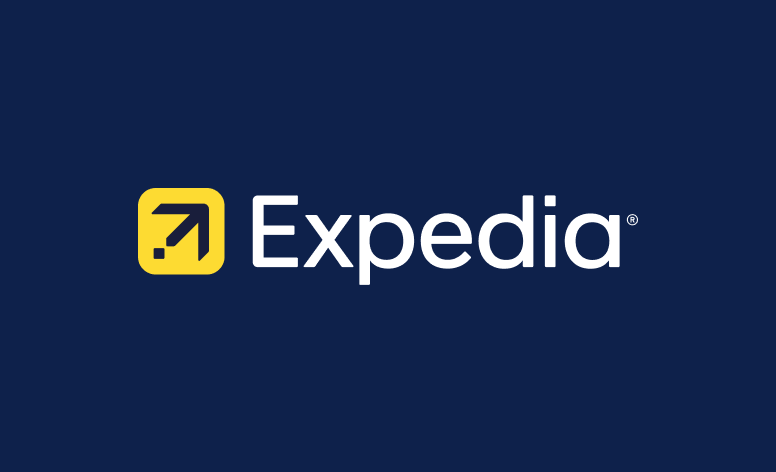
Exclusive and actionable traveler insights
We have billions of data points from travelers using our 200+ travel websites. The benefit of this exclusive first-party data is unrivaled traveler insights, and, in a cookieless world, you’ll always be able to reach your target audiences with specific ads that align with their interests.
Explore our customer stories
Find out how we help advertisers meet their needs, from airlines and hotels to destinations.

The largest airline in Canada, has been a long-time partner with Expedia Group Media Solutions. With Black Friday and Cyber Monday approaching, Air Canada wanted to stay top of mind with travelers looking for deals during some of the most important sales events of the year.

During the early days of the COVID-19, the Hyatt Regency Chicago realized that there was going to be limited customer demand. They decided to use TravelAds to differentiate themselves from other hotels in Chicago to drive bookings.

Looking to rebuild and renew, VisitScotland embarked on a tourism marketing campaign to highlight the unique experiences it offers travelers.

In a competitive market, visibility is key to filling room nights and Blinkup wanted to help Place of Charme connect with more travelers. To reach travelers worldwide, the marketing consultancy partnered with Media Solutions to showcase Place of Charme’s six properties on Expedia Group sites.
Recommended for you

The Path to Purchase
New research to help you understand how travelers search, plan, and book travel.
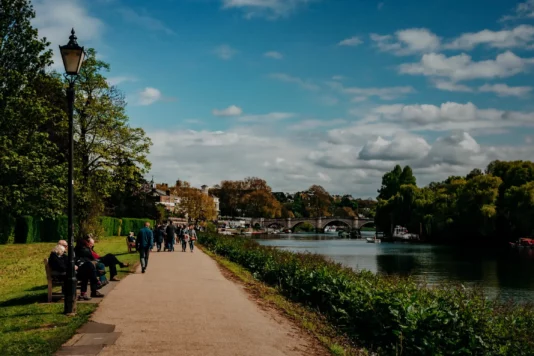
Travel Insights report
Our exclusive first-party data and research provides you with actionable insights.

TravelAds guide
Find out how to reach the right travelers and maximize results with TravelAds targeting and bidding tools.

Are you ready to advertise?
Get in touch with one of our digital advertising experts today to find out how our first-party data insights and full-funnel suite of solutions can work for you.
*Expedia Group internal data, 2023, identified and anonymous visitors.

- Privacy Policy
The Digital Travel Expert Blog
Human-centric Digital Strategies and Tips for the Travel and Hospitality Industry Businesses and Content Creators
Digital Travel Marketing Resources .

Digital Marketing for Travel Businesses Success (5+ Niches)

25 Tested Advanced Digital Travel Marketing Strategies

A Serene Traveler Journey Perspective: The Tourism Heartbeat

Effective Travel Post Call to Action(50 Unique CTAs Bonus)
Why does digital marketing matter for travel pros ..
Welcome to Digital Travel Expert Blog, where we embark on a journey through the fascinating realm of travel digital marketing with a conscientious compass guiding our way.
At Digital Travel Expert, we believe that digital marketing strategies in the travel and hospitality industry should be more than just enticing travelers to explore new destinations—it should be an ethical endeavor that uplifts both businesses and travelers alike. With this ethos at our core, we’ve curated a treasure trove of insights, strategies, and tips designed to empower businesses to market their offerings authentically, responsibly, and sustainably.
Our humble abode is a sanctuary for digital marketing enthusiasts, industry professionals, and wanderlust-stricken minds seeking to navigate the ever-evolving landscape of travel marketing with integrity and compassion. Whether you’re a seasoned marketer or a budding entrepreneur, we invite you to join us on this odyssey as we delve into the nuances of ethical marketing practices tailored specifically for the travel and hospitality sector.
But what truly sets us apart is not just our strategic digital marketing tips, but our unwavering commitment to humility. We understand that the journey to mastering digital marketing in the travel industry is an ongoing expedition—one that requires humility, curiosity, and a willingness to learn from both successes and failures. Here, we don’t claim to have all the answers; instead, we humbly offer our knowledge, experiences, and reflections, knowing that true growth comes from embracing the collective wisdom of our community.
So, whether you’re a digital marketing manager or travel business owner seeking guidance on leveraging social media to showcase your eco-friendly initiatives, crafting compelling storytelling campaigns that resonate with conscious travelers, or navigating the ethical implications of data-driven marketing, Digital Travel Expert Blog is your trusted companion on this transformative voyage.
Join us as we chart a course towards a future where travel marketing isn’t just about selling destinations—it’s about fostering meaningful connections, preserving cultural heritage, and stewarding our planet for generations to come. Welcome aboard, fellow traveler. Together, let’s navigate the digital seas with humility, integrity, and a spirit of adventure.
Contribute .
- Skip to primary navigation
- Skip to main content
- Skip to primary sidebar
- Skip to footer
Inflow: eCommerce Marketing Agency
Home > eCommerce Strategy
7 Digital Marketing Strategies for Travel & Tourism eCommerce Businesses
Almost no industry has been more thoroughly disrupted by COVID-19 — and continues to feel the pandemic’s secondary effects — than travel and tourism .
Even though many people today are eager to travel, with ongoing economic uncertainty, it can be hard to get customers to spend their precious savings on travel experiences.
While travel always has been — and will always be — an industry subject to great uncertainty, one thing remains certain:
A strong digital marketing strategy can help you weather downturns and maximize returns during upswings, so your travel brand can maintain long-term profitability.
At Inflow, we’ve helped many travel and tourism companies navigate the challenges of the industry to not only make it through recent disruptions, but to also profit during them — and come out stronger on the other side.
In today’s guide, we’re sharing seven key tourism marketing strategies you can employ to do the same.
The Current State of the Travel & Tourism Industry
Although the travel and tourism industry took a pounding during the pandemic, recent years have helped it make up for the decline.
Overall, global leisure travel in March 2023 was up 31% from the same period in 2019 , thanks in part to a 25% increase from 2022 to 2023.
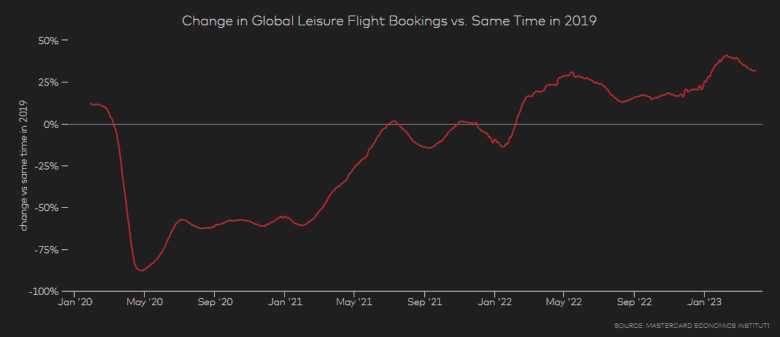
But don’t count on this as a sign of full recovery quite yet.
Travelers increasingly cite concerns about crowding and delays as reasons not to travel. When they do travel, they are demanding more for their money. With reserves of extra cash (and empathy) depleted, more people are looking for bargains when it comes to travel plans.
Spending patterns are also changing. From 2019 to 2023, spending on things associated with travel only increased by 12%, but spending on experiences increased by 65% — demonstrating where today’s shoppers are finding value in tourism- and travel-related purchases.
7 Travel & Tourism Digital Marketing Strategies to Boost Online Revenue
At Inflow, we have helped many travel and tourism brands find long-term success through digital marketing. Typically, this is done through customized strategies reflecting each brand’s strengths, limitations, and goals.
However, many strategies apply equally well across travel and tourism niches, which is why we’re sharing them in detail below.
Today, we’ll lean on examples from our successful travel brand client, Shore Excursions Group . Operating within the hard-hit cruise industry, their team’s experience accurately reflects the rollercoaster ride many in the travel industry experienced during the COVID-19 pandemic and after.
Our work with them shows that, with the right travel marketing strategies, a business can remain profitable despite even the most unexpected challenges.
1. Be inventive and experimental.
2019 may have only been four years ago, but it’s an entirely different era for the tourism sector.
What worked for you back then likely won’t work for you now. In other words, you’re sailing in uncharted waters.
Advertising costs are up. Click-through rates are down. Algorithms are always changing. The social media landscape has gone through a major upheaval. AI’s fingerprints are all over marketing, from automation to content creation .
To make it through these choppy seas, you’ve got to read the winds and roll with the breakers.
Here’s an example:
When the pandemic destroyed demand, Shore Excursions Group paused their pay-per-click (PPC) marketing campaigns. And, when it came time to restart their efforts a few years later, that meant coming to grips with an entirely changed situation.
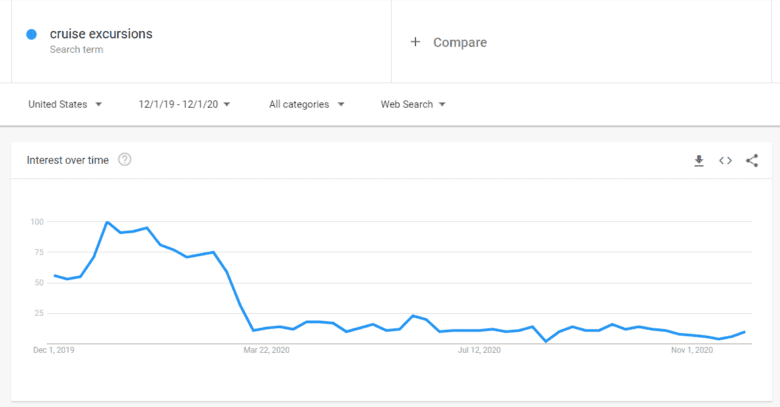
Keeping their historical data in mind (but adding a new grain of salt), we restructured their PPC spending literally port by port, all while integrating Google’s new automation tools, including Performance Max .
The approach paid off , increasing Shore Excursions Group’s profit margin by over 1,300% while simultaneously achieving a return on ad spend (ROAS) of nearly 19x — results we never could have achieved with our pre-pandemic strategy.
The moral of the story: Don’t get stuck on traditional marketing trends and strategies of old. Quickly (and intelligently) incorporate current developments into your approach, and don’t be afraid to take a completely unexpected plan of attack when necessary.
If you, like many travel companies, are finding it hard to make headway in the current market, it may be time to bring in an expert. Contact Inflow’s strategists today to learn how our digital marketing services can help your travel or tourism business.
2. Be seasonally smart with your marketing investments.
The travel industry is seasonal. Your marketing should be, too.
But that doesn’t mean your marketing should stop completely during slow seasons (or unanticipated stoppages like the COVID-19 pandemic)!
Just as a seasonal resort might try to do as much maintenance and as many upgrades as possible during the off-season, your travel business should be investing in long-term marketing strategies that will pay off when customers resume shopping.
Some types of marketing, especially PPC, are designed for rapid returns. You should pause these campaigns during slow seasons; they’re typically expensive and don’t justify the cost if they’re not bringing in typical returns.
Other types of online marketing, though, need time to work — and they offer value even if it doesn’t immediately register in the form of sales. This includes organic social media campaigns and search engine optimization (SEO) .
In this client’s case, Shore Excursions took advantage of the pandemic slowdown to upgrade their website while working on SEO.
Their efforts helped to improve their search rankings, allowing them to capture a greater share of search traffic as people began looking for travel opportunities a year later.
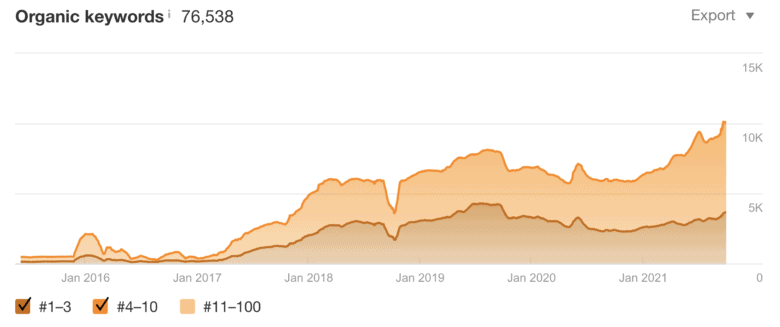
3. Lean into user-generated content and influencers.
Even avid travelers spend more time dreaming than traveling. Beautiful images and amazing stories fuel these dreams.
To make sure these images and stories are yours, invest heavily in beautiful content marketing .
While you should invest in professional imagery related to your brand, the best content marketing for the travel industry will always be reviews and pictures from your customers’ user-generated content (UGC).
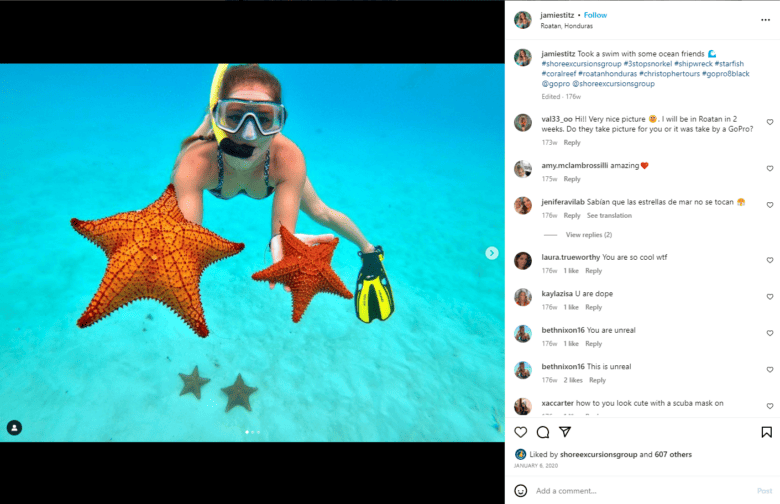
UGC may not be professional-caliber images, but they often capture a spontaneous essence of travel that can be hard to replicate with professional images. When people choose the images most meaningful to them, it’s likely to strike a chord in the hearts and minds of other travelers.
UGC also offers social proof. It’s not just you talking up your brand; it’s other people vouching for you, using their words and images to support your value.
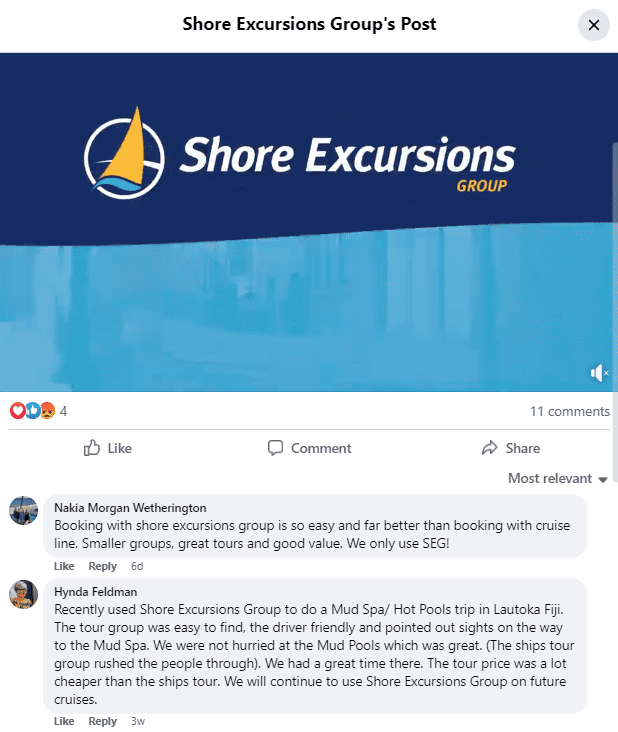
People love making social media posts about their travel experiences. It’s just a matter of getting them to share it in a way that you can use.
Consider setting up a brand hashtag. If customers don’t pick it up, host a photo contest. The prize doesn’t have to be big; gift cards, discounts, and swag all work great in motivating UGC.
Use what people give you, and always remember to give proper credit.
Check out our complete guide to UGC for more tips and strategies.
Influencers are a special category of their own, existing somewhere between professional content and UGC. With their knack for making appealing images and stories, as well as their outsized followings, they can be a major help for your social media marketing efforts.
However, it can take a few tries to make influencer marketing work for you. Consider partnering with an agency that specializes in influencer marketing to find the right content creator for your audience demographics and chosen social networks.
4. Get specific with audience targeting.
Marketing to people who aren’t interested in your product or service isn’t just a waste of time. It’s also an expensive way to buy bad will.
Audience targeting can help you avoid pestering people who will never convert (and might report you, bumping up your overall ad costs) and focus instead on only those who are potential customers.
Modern marketing tools give you more than basic demographics to work with. You can build extensive profiles on your target audience to focus on prospective customers likely to use your service. For example, if you’re marketing an off-roading excursion, target people who have expressed an interest in off-roading.
Use industry research as well as your own historical data for travel destinations to identify where travelers are coming from, and then use geotargeting to focus ads in these places. Carefully evaluate your efforts, and update your targeting to build on success and minimize waste.
For Shore Excursions Group, this meant narrowing down our location targeting with our relaunched Google Ads campaigns. Instead of widely targeting all Alaska ports, we started by looking at individual cities and ports that had performed well in the past — and continued to build upon those that worked well in 2022 and beyond.
5. Invest in your branded online presence.
Another critical investment you should make during the slow seasons is in your travel brand.
We’ve talked multiple times about the wariness of travelers in the market right now. Trust is the antidote to wariness, which makes building a trustworthy brand an investment that will pay for itself many times over.
Brand awareness is the first step in brand trust. If you’re not well known, try spreading the word with typical PR strategies. Sponsor relevant causes. Host giveaways and contests. Be active (and interactive) on social media platforms.

Next, work on establishing verification that your business is what you say it is. Invest in local SEO and build a robust Google My Business page. Make sure you’re listed in relevant third-party directories.
Of course, you should always be encouraging reviews from customers, but also consider reaching out to industry authorities to get reviews, features, and even endorsements. Always balance the value of these listings against the cost in time, money, and product.
6. Build great email campaigns.
We’ve mentioned before how it’s important to make sure that potential customers get their dream fuel from you. Email marketing is a great tool for doing this.
Even more people have email than have social media accounts, and 99% of users check their email every day (with some people checking it as much as 20 times a day)!
This makes email a great strategy for reaching potential customers. It’s also extremely cost-effective with a high rate of return (some marketers report an average ROI of $36 per $1 spent ).
There are a few keys to making a successful email campaign:
Give value to your potential customers that justifies their opening the email. Discounts, of course, are a great choice, but sometimes valuable content can work even better. Try a mix of evergreen content and trending topics to find the right balance for your list.
Remember to always be visual in your emails. This is dream fuel: People want to see beautiful travel images. That might be the main reason people open the email.
In light of that, be concise, too. Don’t waste words, but make sure you have multiple CTAs in your email so people get the message.
As with any of these strategies, keep an eye on the performance. A good open rate for emails in the travel industry is 20% to 40% , with a click-through rate (CTR) between 2% and 3%. If you’re not seeing that level of engagement, reevaluate your campaign.
7. Keep an eye on your competitors.
With an industry as competitive as travel, it’s important to keep a close watch on your competitors. If they’re outpacing you, you can learn a lot from the trim of their sails.
Competitor research isn’t as simple as a quick Google search. However, there are many tools that help you understand what your competitors are doing with their Google Ads , as well as identify your main competitors in organic SEO .
You can download our SEO Competitor Analysis Template as a place to start. We use this template (as well as ongoing competitor paid search campaigns) to monitor movements and strategies by Shore Excursion Group’s competitors, including other third-party tour providers, operators, and travel agencies.

Investigating your competitors will teach you some of their tricks, so you can add them to your own. This research will also help your brand stay on top of industry trends — and quickly pivot (even anticipate) major changes that will impact your business in the future.
Building a Foolproof Digital Marketing Strategy for the Travel Industry
If you’re still afloat in the travel industry, you’ve already weathered some major storms. There’s no guarantee it will be smooth sailing ahead, but with smart investments in long-term travel and tourism marketing strategies, you should be able to maximize the benefits of digital marketing to outpace your competitors and improve your profitability.
Creativity and flexibility are especially important in this competitive and unpredictable industry. But even more important? Your business team’s expertise.
Knowing the potential (and limitations) of modern marketing techniques and technologies can save you critical time and resources as you build and execute your brand’s strategy.
Don’t have that expertise on hand — or want another industry expert to evaluate your approach for you?
Our tourism and travel marketing experts are happy to review your brand’s current approach, identify opportunities for improvement, and implement a custom marketing plan to drive sales and revenue for your online business.
Request a free proposal anytime to get started.
I appreciate the emphasis on user-generated content and influencers. Encouraging customers to share their experiences not only builds a community but also creates authentic connections. The practical advice on leveraging UGC effectively and finding the right influencers resonates well with today’s content-driven market.
Leave a Reply Cancel reply
Your email address will not be published. Required fields are marked *
This site uses Akismet to reduce spam. Learn how your comment data is processed .
Related Posts

About The Author
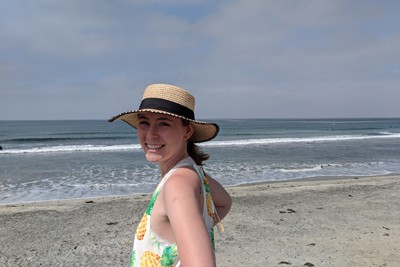
Kate Miller
Kate has loved words since the moment she learned to read. She’s the first to pick up a pen or break out a laptop to write down her next big idea, and she’s thrilled to be the content marketing manager at Inflow.
Request a Proposal
Let us build a personalized strategy with the best eCommerce marketing services for your needs. Contact us below to get started.
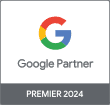

Marketing for Travel Agencies: Understanding and Surviving in the Online Travel Industry
- 16 min read
- Business , Travel
- Published: 23 Dec, 2019
- No comments Share
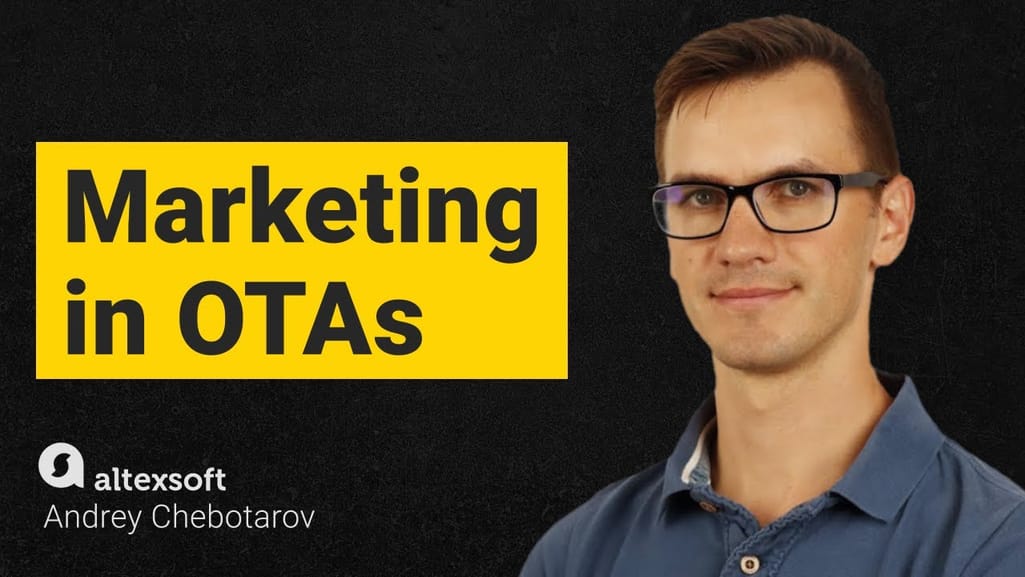
Understanding the travel agency market
- Leading players holding the market. Booking Holdings with its 41 percent share and Expedia with about 32 percent are dominating the online travel agencies market. And their shares keep growing. So, for travel agencies, it’s difficult to stay afloat without a specific niche.
- Distrust. People tend to be skeptical and even suspicious in arranging their trips. They would rather follow word of mouth, go to their old, time-tested local travel agent, or stick to larger players, even if they are not totally satisfied. So, new travel agencies have to work hard to break through the wall of mistrust.
- Invisibility. Unless a travel provider puts a lot of effort and resources into promotion, it risks staying unnoticed. Here, the choice of distribution channel plays a decisive role.

This ad, published in National Geographic by Econo-Travel hotels, dates back to 1978
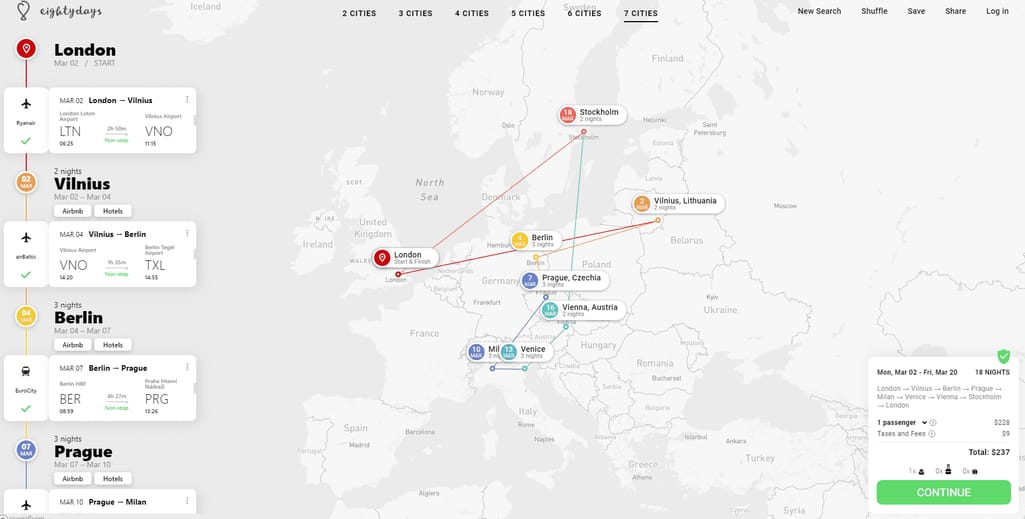
It will take days for a regular traveler to create such a complex itinerary, Eightydays cuts this to minutes
Investigate and define your market and target audience
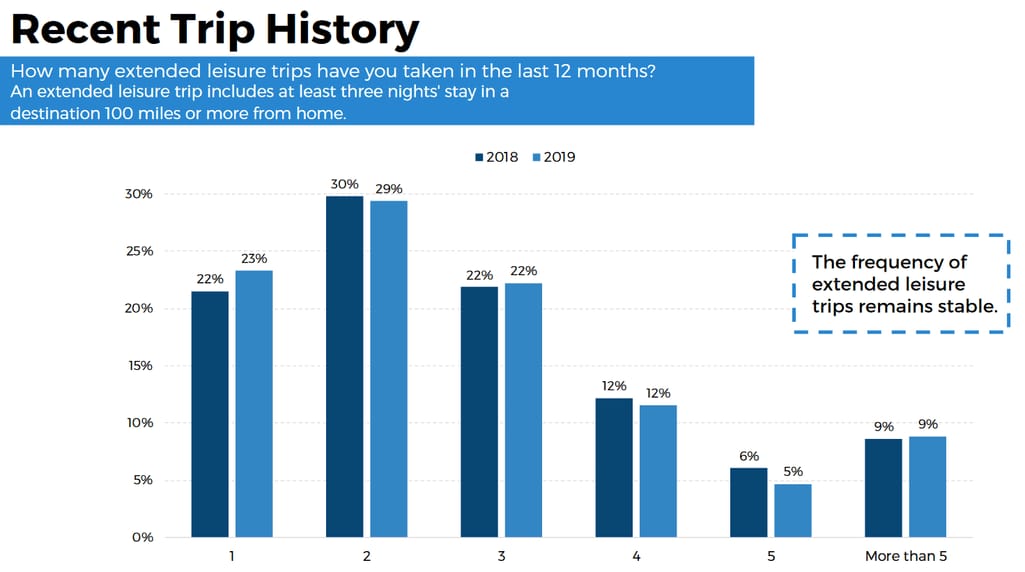
Skift, Experiential Traveler Survey , 2019

Analyze your competitors
Establish your partnerships with service providers, define your pricing strategy, determine the right distribution and promotion channels, metasearch engine.
- You can manually check prices and manually change markups.
- You can use automated dashboards to track your performance and then manually change markups.
- The most advanced scenario is to create an automated commission engine that will keep all your markup rules and will be adjusting your margin on the go, reacting to competitor results.

Prestigia, a small OTA with about 200 thousand monthly visitors, wins on Kayak with this hotel deal as it targets boutique accommodation
Search engine

Orbitz has dedicated landing pages for hundreds of their deals and packs them with all useful information that a traveler may need: a booking widget, selected fares, basic information, and even short copy describing the trip
- Internal activities to meet technical standards of search engines. These usually include installing tools like Google Console and Google Analytics, working with meta tags, reviewing a website for the right page redirection, code errors, and others.
- External activities usually include working with keywords, texts in general, and acquiring backlinks from other websites.
Email marketing

One of the great examples of submitting discounts was Kimpton Hotels and Restaurants. The discounts promoted the unpopular post-Christmas holiday season

As you can see, there are both wallet-friendly and luxurious destinations and tour packages
Web adverts
Video blogging and other social media, final recommendations.

Travel Digital Marketing
Tell tourists about your services
With our digital marketing services specifically designed for the tourism industry, you can reach new customers and introduce your products and services to individual business and leisure travellers, as well as groups., fine tune your online marketing mix and find new clients online, online travel agencies (ota), holiday apartment rental sites, destination marketing organisations (dmo), convention and visitors bureaus, travel technology companies and tour guides: esario offers numerous ways to promote your services to tourists on any digital channel., online travel agencies, services for tourists, tourism offices.
Whether you sell hotel rooms, apartments or packages deals that include travel, our digital marketing services for travel agencies will help you find new traffic through various means, including: Google AdWords campaigns, social media, meta search, display advertising and blog presence.
Esario can also analyse your site for potential conversion problems due to your online booking system.
Services for tourists are diverse. The main services are related to travel and accommodation, but this sector also includes all entertainment and activities, such as wine tours, car hire, registration to sport activities and events.
Our digital marketing work within the tourism industry promotes your services on the most suitable channels. It may require work on your website in order to ensure adequate SEO of your webpages, as well as work on other channels ,such as social media, meta search engines, blogs and online magazines.
In the touristic sector, public organisations play a key role in promoting their destination and in monitoring its online reputation to provide better services and structures to tourists.
Just like in other sectors, you will need to implement best practices to ensure that you have good presence in search engines. It is also expected that you are active on social media to promote local attractions and events. Allowing other local establishments, such as hotels, to integrate custom maps or share information about upcoming events is also an important step.
Your message
- Travel Resources
- Destination Inspiration
- Tips & Advice
- Did You Know?
- Conservation

Exploring the Digital Frontier: Effective Marketing Strategies for the Tourism Industry
- June 14, 2024
In today’s fast-paced world, where decisions are made with the click of a button, the tourism sector requires innovative and impactful digital marketing strategies to captivate and engage potential travelers. From breathtaking visuals to interactive content, let’s delve into how you can elevate your game in marketing for tourism .
Understanding Today’s Traveler
The first step in crafting an effective marketing strategy is to understand who your travelers are and what they seek. Today’s travelers are looking for authentic, memorable experiences. They prefer personalized travel packages and value convenience and speed in booking. Recognizing these preferences is key to tailoring your marketing efforts.
Building a Captivating Online Presence
For any travel business, an appealing and functional online presence is critical. This presence starts with your website. Specialized travel agency websites not only need to look good but also offer seamless user experiences. They should provide easy navigation, detailed information, and secure booking options to convert visits into bookings efficiently.
Utilizing SEO to Reach Global Audiences
SEO is a powerful tool to enhance visibility in a crowded market. Optimizing your content to appear in top search results can significantly increase your website’s visibility, attracting more potential travelers to your site. Use targeted keywords related to popular destinations, travel tips, and seasonal offers to capture the interest of those planning their next vacation.
Leveraging Social Media for Engagement
Social media platforms are perfect for storytelling. Use vivid images, engaging videos, and interactive content to share stories of destinations, showcase customer testimonials, and highlight unique experiences. Platforms like Instagram, Facebook, and TikTok allow you to reach a diverse audience and engage with them in real-time, building relationships and encouraging them to explore more.
Capitalizing on Video Marketing
Video marketing has emerged as a powerful tool in the travel industry, capable of capturing the essence of destinations in a way that static images and text cannot. By creating immersive and captivating videos, you can showcase the unique experiences your travel packages offer. These videos can be used effectively on your website, social media platforms, and even in email campaigns. They allow potential travelers to visualize themselves in the destination, enhancing their desire to experience it firsthand. This visual engagement not only boosts interest but can significantly increase booking rates as viewers are transformed into motivated travelers.
Effective Email Marketing Campaigns
Email marketing remains one of the most effective strategies for direct communication. Segment your audience to send personalized travel suggestions, special deals, and updates about new destinations. Well-crafted emails can remind your customers of the wonderful experiences awaiting them, prompting them to book their next trip.
Creating Content That Inspires
Content marketing can be a game changer in the tourism industry. Create content that inspires and informs potential travelers. Blogs about “Top 10 destinations” or “Must-have experiences in [Destination]” can generate excitement and prompt bookings. Include high-quality photos and videos to make your content more appealing and shareable.
Harnessing the Power of Reviews and Testimonials
In the travel industry, trust is paramount. Showcasing positive reviews and testimonials from past travelers can significantly boost your credibility. Encourage your customers to share their experiences on your website and social media. Positive stories and word-of-mouth recommendations can lead to increased bookings and enhanced brand loyalty.
Integrating Advanced Booking Technologies
Incorporate the latest in booking technology to make it easier for travelers to secure their vacations. Features like real-time availability checks, virtual tours of accommodations, and mobile-friendly booking processes can enhance the user experience and increase conversion rates.
The tourism industry’s landscape is constantly evolving, driven by technological advancements and changing consumer expectations. By embracing these digital marketing strategies, you can ensure that your travel business not only survives but thrives. Engaging websites, strategic SEO, interactive social media campaigns, and personalized email outreach are all part of the toolkit to attract today’s tech-savvy travelers. Get ready to take your travel business to new heights with these cutting-edge marketing techniques.
Now, let’s look at some FAQs to help clarify any remaining questions:
FAQ 1: How important is SEO for tourism marketing? SEO is crucial as it helps potential travelers find your services when they search for travel options online, increasing your visibility and booking chances.
FAQ 2: What benefits does a well-designed travel website provide? A well-designed website not only attracts visitors but also provides them with the necessary tools and information to book their travels, enhancing user experience and satisfaction.
FAQ 3: Can social media really influence travel decisions? Absolutely! Social media has the power to influence travel decisions by showcasing compelling content and real experiences from other travelers.
FAQ 4: How effective is email marketing in the travel industry? Email marketing is highly effective in keeping past and potential travelers engaged with personalized offers and updates, increasing the likelihood of repeat bookings.
FAQ 5: Why is it important to feature customer reviews on travel platforms? Customer reviews build trust and provide social proof, which can influence other potential customers’ decisions in favor of booking with your service.
Photo by allPhoto Bangkok on Unsplash
Related Topics
- tourism marketing strategies
- travel marketing plans
Journey Without Limits: Mattias Klum’s Top Gear Recommendation for Global Explorers

- Great Holiday Destinations
Anantara Dragon Seseh Bali Resort: Specific Options
You may also like.

The Future of Travel and Tourism in the Digital Age
- June 17, 2024

Best 4 Chiang Rai Night Markets You Must Visit for a Thailand Tour

Travel Smart: Packing Essentials for Every Type of Trip

- June 3, 2024

Simplified Summer Travel: Vacation Plans with Best Tour Operators in India
- May 29, 2024

- Planes, Trains & Automobiles: Tips & Advice
The ultimate car guide for your upcoming road trip
- May 14, 2024

5 Tips for Staying in Touch While Journeying Overseas
- April 29, 2024
Input your search keywords and press Enter.

21 Travel Companies Getting Their Digital Marketing Right (That You Can Copy in 2023!)
Knowing where to focus your marketing time and budget has always been a challenge, and in 2023 it’s as crucial as ever that you focus your efforts in the most effective places.
To help guide you on where that should be, we’ve pulled together a variety of travel companies who excelled in different areas of their marketing in the past few years, which you can learn from (and copy!) in 2023. Some of these are big brands with massive budgets, others are small independent companies that have used small budgets in a very effective way.
The idea with this isn’t to provide an exhaustive analysis of each site, rather give you a lot of different ideas for how you can improve your digital marketing for a travel agency this year with some concrete examples of sites doing it well. Even with the brands carrying out big-budget campaigns, there are ideas and lessons at the heart of them that can be executed even at smaller budget levels to bring you strong performance improvements.
We hope you find it useful!
Snaptrip have done a fantastic job of using infographics to gain coverage and links on top-tier websites that has rocketed their SEO progress forwards.
Clever research projects like their piece around UK filming locations has led to coverage on Lonely Planet and the Manchester Evening News , whilst their interactive map of Michelin star restaurants gained coverage in lots of regional publications .
Coupled with a clever approach to getting links on university websites through alumni links, this has led to some fantastic growth in both traffic and the site’s link profile.

Areas for Improvement:
SnapTrip is a huge site and they have a lot of pages that are very thin on content like this and this , and the only content that is on there is duplicated testimonials. These pages may bring some visits into the site, but as part of the wider picture it is likely the volume of them will be harming the overall site’s performance and rankings for phrases with more search volume.
THE SAVVY BACKPACKER
The Savvy Backpacker redesigned their travel blog cum advice site in 2017 and have seen fantastic growth since they did so. They clearly did a good job of getting the technical factors right, such as moving to https and getting good page load speed times.
They’ve also improved their link profile significantly, gaining links from top sites like The Culture Trip , Insider and Cheat Sheet . Many of these links look to have come as a result of having great resource content that already ranks well rather than TSB actively pursuing them (I assume), highlighting the value in spending time creating great informational content on your site.
There are some small things that will help TSB make some incremental gains, such as improving indexation so stray pages like this duplicate homepage don’t exist, category pages like this aren’t indexed, as well as media pages like this . That, combined with more great content, will help the site continue to flourish!
LOVE HOLIDAYS
Love Holidays were ranked the second fastest growing company in the UK last year so it’s no surprise they have their digital marketing ducks in a row.
Much of their growth seems to have come from better awareness of the brand, with 16% of search visits coming from branded phrases. This will have come through PPC advertising, as well as other offline activity they have run. The Google Trends graph for Love Holidays shows the increase clearly below when comparing year-on-year:

This has also fuelled a growth in websites linking to them, which has a cumulative effect of driving forward the site’s SEO performance.
Another interesting addition is that the monarch.co.uk website is now redirecting to Love Holidays after they went bust last year, which will have transferred a lot of SEO value and no doubt was a costly acquisition. If done right this approach in digital marketing for travel agents can work well, but you need to ensure all the technical elements are handled correctly.
At the moment the Love Holidays site is in pretty good shape, which is no surprise given their significant growth, so more of the same is the message for them. If they want to keep progressing and compete with the biggest high street names then more links through a variety of approaches will help do that, alongside well researched, tactical content production.
FLIGHT NETWORK
Flight Network have focused on creating epic content that they can use to attract links. They’ve clearly followed the content marketing formula we’ve written about and created something excellent and newsworthy, then reached out to the right people to feature it.
Their 50 Best Beaches project has been featured on CN Traveller and the Metro amongst others, and their top festivals piece has gained lots of links from the festivals featured that has clearly come from good outreach.
Flight Network need to work on their reputation management, as the second result in Google after their own site for a branded search is an extremely negative review which will undoubtedly impact conversions.
They also have some indexation issues, with low quality pages in Google’s index and some thin pages that are probably doing more harm than good.
SCOTT’S CHEAP FLIGHTS
In the digital marketing world, there is a saying ‘the money is in the list’. No-one shows this off more than Scott’s Cheap Flights which has more than 500,000 subscribers to their list of cheap flight deals.

The secret here is as simple as giving away something people find valuable in return for their email address, and then delivering on that promise once people have signed up (not just spamming them with your deals and company updates).
With so much money being spent on Google Adwords and Facebook Ads in particular now, ensuring you have some form of email marketing process in place to capture people’s details is more important than ever. If you can engage with users over a longer period then your advertising pennies will go a hell of a lot further.
They seem pretty comfortable managing their email marketing and have done a great job of building the brand, but there is potential for the site to develop their subscriber generation through better SEO and developing the content on the site. However, if you’re making more than $300,000 per month then maybe you’re not too fussed…
Thanks to Gaps.com for highlighting this example originally.
Hoppa have been using infographics successfully for many years, but it is their Cheap vs Expensive Cities project that has been most successful, gaining coverage on hundreds of sites since it began, including places like the Telegraph for the 2017 version.
It shows that it’s worth taking the time to bring lots of research together as if you create something good enough, it can deliver returns for you year after year (proof for Area Vibes above!).
Fix some technical issues, like redirecting this page which has 9 linking sites but goes to a 404 page. I would also recommend they make their destination pages more comprehensive ‘hub’ pages, linking through to relevant blog posts in particular to help push those pages forward.
THE BLONDE ABROAD
Kierstan Rich has got social media down to a tee, as well as the content that goes down well on that channel. Of course, it helps that she has an established following, but if you’re searching for examples of the kind of content that people love on platforms like Facebook and Pinterest, look no further.
Kierstan has a wide variety of posts that have been shared more than 1,000 times, including “17 Unforgettable Trips to Take in 2017” and “20 Photos to Inspire You to Visit The Seychelles”. Great imagery is undoubtedly a massive factor in the shareability of the posts, but the content is also always great when you arrive and share buttons are very prominent on the site making it super easy to share.

Kiersten has some good hub pages for locations like this , but there isn’t much unique text and the targeting of the page isn’t great (in particular the title tag). If these pages had a chunky section of text with more information on visiting Panama for example, and the title was updated to target something like ‘Panama Travel Guide’ or ‘Panama Travel Tips’ then these pages would bring in much more traffic in addition to individual blog posts.
Area Vibes have taken a different approach to their content marketing, focusing on people’s enjoyment of negativity and writing lots of articles with a negative angle to gain notoriety and attract links.
Some of their pages like the Worst Places to Live in America have been shared more then 30,000 times, and they have created infographics that have attracted links from sites like Cosmopolitan and Elle with titles like the Most Hated Celebrities on Instagram .
If you’re prepared to run the risk of some negative sentiment in your content then there is a lot of benefit to be had from it!
Some of the old articles they have created could be updated with a more recent version, like this one on the Cities with the Lowest Crime which hasn’t been updated since 2015. If you create content like this, releasing a version each year is a fairly straightforward way of giving yourself more outreach opportunities.
H/T to Glen at Detailed for highlighting this one originally.
Villa Plus have seen excellent growth over the last year, continuing their growth from 2016. A big part of this has been the growth in their link profile which has come from a variety of approaches that are clearly working well when combined.

One of these is more traditional PR activity which has gained them coverage in top tier publications like the Daily Star from working with celebrities, and the Mirror from doing a study to give them an angle for promotion.
They’ve also run competitions to get coverage on a variety of strong sites and partnered with charities that have also yielded quality links.
In addition to this they’ve also been working with bloggers to get links into their key commercial pages, as well as running campaigns like their Eat Like a Local one which has gained them links on a variety of cookery blogs .
They are an excellent example of how to build a good link profile through a variety of approaches, and the improvement they’ve seen over the last year speaks for itself.
The destination pages on the site need their content improving as, even though they rank well at present, I wouldn’t expect this performance to be maintained with the amount of content they currently have. They also have pages like this with usability issues that over the longer term will frustrate users and lead to a drop in performance.
SILVER SWAN RECRUITMENT
We started work with Silver Swan at the end of 2016, charged with improving their SEO performance. They were in desperate need of a new website to improve usability as well as addressing a wide range of SEO issues.
According to SEMRush the site’s traffic has more than doubled since then and they are being found through 4 times as many keywords. Some of the key issues that have been fixed include better indexation (lots of thin pages removed), better on-page targeting and introduction of new content to target a wider set of phrases for people at all stages of the buying funnel.

We’re also in the early stages of some content marketing work for them, with the first infographic project already yielding links on big sites like Startup Donut and HR Daily Advisor.
We need to continue developing the content on the site to target a wider set of phrases, as well as carrying out more content marketing activity to attract more links from high-quality publications.
Wanderlust launched a newly designed website towards the end of 2017 and it has reaped some early rewards with a significant spike in traffic in January, ahead of the normal trend of improvement you would expect in travel at that time.
The content on the site has always been excellent, but it’s now presented in a much nicer way and is much easier on the eye.
They also have nice hub pages for locations which feed people into relevant articles and make for a good internal linking structure and improving the site’s topical relevance.
It’s not too long since the new site launched, so these may be things Wanderlust are already working on, but there are some easy wins available to them which will help them build on their already strong presence:
- Improve title tags on important pages like this
- https://www.wanderlust.co.uk/travel/discoverbahiabrazil/
- https://www.wanderlust.co.uk/guides/brazil/discoverbahiabrazil/
- https://www.wanderlust.co.uk/discoverbahiabrazil/
- The site’s Page Speed scores are currently very poor and need improving before this becomes a ranking factor in July.
MAKE MY TRIP
Make My Trip approach their blog content very cleverly, with great titles and topics that really resonate with people on social media.
One such angle is highlighting people in their content so they have a ready-made platform for promotion – who doesn’t like sharing content they were featured in? This post on Indian women who travel solo amassed more than 13k Likes on Facebook. This one focused on Indian actor Shah Rukh Khan and has nearly 5k shares.
When writing your content make sure you have promotional angles in mind before you start so you know you have a way of getting the things you create in front of enough people. This is one angle, but there are lots of other ways to garner attention.
The content on the site needs major improvement, as pages like this are never going to set the world alight. They also have some strange issues with duplicate pages like these two hotel pages:
https://www.makemytrip.com/hotels
https://www.makemytrip.com/hotels//
Fixing these kind of technical and content related issues, which are all very much in their control, will have a major effect for a site with such a strong link profile.
Expedia are in a privileged position of having lots of fantastic data to work with to create interesting content pieces. But they do a lot with that data, and consistently create content that attracts links from the strongest sites on the web.
Their Discover Mythical Creatures project attracted links from more than 50 domains, whilst their Stay Off Social tool attracted links from places like Travel and Leisure and Time Out .

If you’re looking for content marketing inspiration, Expedia are a great example. Whilst many of their implementations will be too costly for small companies, their angles and ideas can be replicated to get great results on a much smaller budget as we’ve shown before .
Expedia have had well-publicised issues with their technical SEO on multiple occasions, and this is clearly somewhere that still causes problems. However, if they can stay on top of those gremlins, they will always perform well given the power of the brand.
SANTORINI DAVE
If you’re looking for an example of how to set up a site with great content and strong internal linking look no further.
Santorini Dave has thrown design out of the window and stripped things back to deliver a minimalist look packed with great content.
His hub pages are brim-full of content, as well as providing a gateway to all the other more specific content he has written about each location (of which there is lots).
This is an independent advice site, but commercial travel sites and tour operators could learn a lot about how to structure their destination content from Dave.
If I were Dave I’d be working on building out his content even more, continuing to create fantastic in-depth resources for well-targeted search phrases. If he does that, and continues to get referenced on more top-tier publications then the site will continue to soar.
HOSTELWORLD
Hostelworld have got their content marketing down to a fine art. With a mix of excellent content built to attract links and separate content to attract traffic, they have a match made in heaven to make progress.
Their Hoscars series constantly delivers (more than 200 linking to this page alone), and once again shows the value in coming up with an idea that has longevity and scope for annual updates.
When combined with the links from this kind of content, their in-depth blog posts also excel, with posts like the Best Nightclubs in the World ranking for more than 300 phrases and bringing a significant amount of traffic to the site.
With a combo like this, it’s no surprise their traffic is flourishing…

Despite the Hoscars being one of their most successful projects, the HostelWorld folks have somehow managed to forget to redirect the old versions of it which have a large amount of links pointing to them:
https://www.hostelworld.com/hoscars-2014
https://www.hostelworld.com/hoscars-2015
https://www.hostelworld.com/hoscars-2012
You’ll struggle to find an easier win…
TravelBird is excelling in their content marketing activity, with a variety of projects that have gained coverage on top tier publications.
Their Most Instagrammable Tourist Attractions page has attracted nearly 150 linking domains (and now one more!), whilst their Most Welcoming Cities project has been on more than 130 sites. These are links from the strongest sites on the web, including Lonely Planet, the Guardian and the LA Times.
With coverage like this, it’s no surprise their traffic has exploded:
Some investigation is needed into the indexed pages on the site, in particular the English version of the site which is hard to navigate to and has mostly blanks pages. If this isn’t being used it should be noindexed .
TUI have carried out a significant change by moving their domain name from thomson.co.uk to tui.co.uk which is riddled with risk from an SEO perspective.
However, it seems their team have carried it out well and the TUI site is now flourishing and attracted more traffic in January 2018 than the Thomson site in January 2017.
They have also done a great job of structuring the site in a way that is earning a lot of ‘rich snippets’ in the search results, and catapulting the site to the top even if they don’t rank there in normal terms.

Some of the deals pages on the site don’t feature much unique content, which would help improve their positioning and ability to attract traffic from more phrases. At present some rank very well, but this is likely down to the strength of the domain and is at risk if Google switches the ranking focus slightly towards content.
Page speed could also be improved which I’m sure is something the TUI team is working on ahead of the update in July.
The first mention of OffPeak on archive.org is in August 2017. Since then it has attracted links from more than 100 sites, including Lonely Planet, Travel & Leisure and Lifehacker. Not bad for 6 months and a pretty solid example of how to approach things if you’re launching a new site.
This obviously isn’t the same kind of site that every travel company has, but it is an example of how effective side projects can be if you come up with an effective idea. This was something highlighted by Viperchill back in 2016, and remains an excellent way of gaining visibility for your brand through a secondary site. I won’t go into depth on this how to do this here, but you can read a thorough insight on Viperchill if it’s a route you’re interested in pursuing (and it should be).
Now the site has some great links pointing to it, the destination pages need more content adding to them to compete with the best sites out there for ‘best time to visit…’ phrases.
Sunshine.co.uk have seen significant improvement over the past year, primarily down to their link building efforts with double the amount of domains linking to them according to Ahrefs.
This increase has come from a combination of working with bloggers to get links to their commercial pages along with more traditional PR activity promoting the deals they have.
However, they have also redirected the familyholidays.co.uk into their main domain during this period which has added more than 300 linking domains in one feel swoop. You need to take care with this kind of approach, but if done in a natural way it can reap significant benefits.
Sunshine’s URL structure could undoubtedly be improved, though this would likely be part of a wider restructure with the site. They also don’t have a blog, which would be an obvious addition to get more content on the site that would allow them to rank for more phrases and benefit further from the link building successes they’ve had.
ADVENTURE ALTERNATIVE
We have worked with Adventure Alternative for 6 months and seen fantastic improvements in rankings and traffic during that time, based primarily on technical improvements we’ve made on the site combined with content improvement and gaining some good quality links.
When we started work the site had serious indexation problems, with lots of low quality pages in the index, as well as a host of duplicate and thin content because of how the site was built.
In addition to that, we’ve tweaked the content on key pages and acquired links on quality sites like universities and well-followed travel blogs. They’re a great example of how resolving technical SEO issues can result in fantastic improvement.

There are still technical issues waiting to be addressed and there is a lot of scope to further develop the content on the site to capture traffic through a wider variety of phrases. We’re also working with AA to develop the link profile further and get coverage on top-tier websites.
As I said at the start of this post, the goal of this post is not to provide an in-depth analysis of anyone featured. It is a collection of examples that I have come across through our work as a digital marketing agency for travel in the industry where we’ve seen people performing particularly well in specific areas.
Hopefully, it has given you some food for thought and ideas for things you can implement to help your own performance in 2023. As I always say when writing posts, emails and sharing on social, if you don’t implement something off the back of tips you read it was pointless reading it!
If you know of any other great examples that would be a good addition to the list please do let me know on Twitter or by email , and if you’ve found the post useful we’d be very grateful if you share it, even if it’s just with one person ;)

Popular Posts
- 100% Impact for 2023
Introducing The Travel Growth Accelerator
Workation Inflation: Hybrid And Remote Working Report and Statistics
100% Impact – 2022
Our 10 Favourite Travel PR Campaigns Created During 2022
About the author
Tom formed SEO Travel in 2011 when he saw the struggle agencies were having offering a quality service to companies in different industries. Having worked in SEO, PR and as a writer, as well as travelling extensively, he brought together all his skills to offer a specialised service for travel companies. The company has grown from there as we have continued to get great results for clients and steadily attracted new business.
Related Posts
- The Future of SEO: How Google SGE & Gemini Will Change Digital Marketing
- Take A Journey With… Tom Williams – Founder of Desert Island Survival
Take A Journey With… Duncan Grossart – Founder of Journeys With Purpose
Get In Touch
Become Our Next Case Study
- Join the Team
- Get a Proposal
- Privacy Policy
- The Travel Growth Accelerator
LATEST POSTS
+44 1943 603159
SEO Travel Platform Building, New Station Street, Leeds, LS1 4JB
SEO Travel is a trading name of Rombald Group Ltd, Registered in the UK, Company Number 8417732, VAT Number 173519302
Tips & Tricks
By checking this box, you agree to receive travel insight, marketing tips, and updates from SEO Travel. We take your privacy seriously.
Please leave this field empty.
ColorWhistle
Digital Web Design Agency India

Explore our Market-Fit Services
We ensure to establish websites with the latest trends as we believe that, products whose value satisfies the needs of the market and its potential customers can be efficiently successful.
Quick Links
- About Us – ColorWhistle
- Engagement Models
- Testimonials
- Case Studies
- Agency Services
- Web Development
- Web App Development
- Digital Marketing
- Travel Website Development Services Company
- Real Estate Website Development Services Company
- Education Website Development Services Company
- Healthcare Website Development Services Company
- Hotel and Restaurant Website Development Services
Travel Digital Marketing Services Company
ColorWhistle – Travel Digital Marketing Services helps in creating endless possibilities and an abundant array of solutions tailored to enhance your digital marketing service endeavors.
Travel and tourism is an incredibly dynamic industry that is experiencing rapid growth globally and with our innovative design approach and meticulous attention to detail, we’ll create a virtual masterpiece that perfectly represents your brand and resonates with your target market. Act smart and let’s conquer together the digital realm to make your mark.
We have a clear understanding of audience expectations and preferences in regions like the USA, UK, Canada, and Australia due to our experience working with clients from these areas.
- White Label Digital Agency & Online Marketing Services Partnerships
- Digital Marketing Services, Internet Marketing Services Technology Outsourcing
Our Expertise in Travel Digital Marketing Services
Seo for travel industry, travel web design, travel social media marketing, travel ad campaigns, travel content marketing, beyond borders: unveiling custom travel digital marketing services for uncharted growth.
Join forces with a premier team boasting over a decade of expertise in crafting highly responsive online marketing strategies.
- Are you currently stuck in an online marketing slump?
- Are you facing challenges with diminishing lead generation and business inquiries?
- Are you unsure about how to kick-start your internet marketing endeavors?
- Not achieving the desired results with your current agency’s marketing strategies?
If you answered yes to any of these questions, then it’s high time to enlist the support of our expert digital marketers at ColorWhistle. We, the travel digital marketing company, are here to provide you with the assistance you need to overcome these hurdles and unlock the true potential of your online presence. Let us guide you toward a path of remarkable success in the digital realm.
Elevate Your Journey by Unleashing Extraordinary Destinations –
Travel digital marketing services, are you an agency looking for a b2b outsourcing partnership .
Reach new heights of success and elevate your travel business to unprecedented levels with our expert travel digital marketing services. Our team of skilled marketers will deftly handle every aspect of your website needs, allowing you to focus on your core competencies. By entrusting us with your travel website marketing you open the door to limitless possibilities for growth and success. Partner with us and let us take your online presence to new heights of achievement.
Are You Looking to Partner with a White-Label Travel Digital Marketing Service?
Unlock the full potential of your travel business and ascend to new heights with our white-label travel website digital marketing services. We offer comprehensive solutions that include PPC, social media marketing, content marketing and more, eliminating the limitations of in-house resources. Partner with us and elevate your online presence to a new stratosphere.
Do You Need a Complete Travel Website Development Solution?
You can benefit from our true blue team’s comprehensive and results-driven travel website development services, which will increase your exposure to the most pertinent organic search results. A one-stop shop for the design and development of your travel website.

Our Client Reviews in Clutch. co
“colorwhistle’s work has led to a steady and healthy increase in user engagement. seo results have similarly inched to positive grounds. the team facilitated a hands-on approach to project management. they were responsive and efficient throughout the partnership. their professionalism was impressive.”.
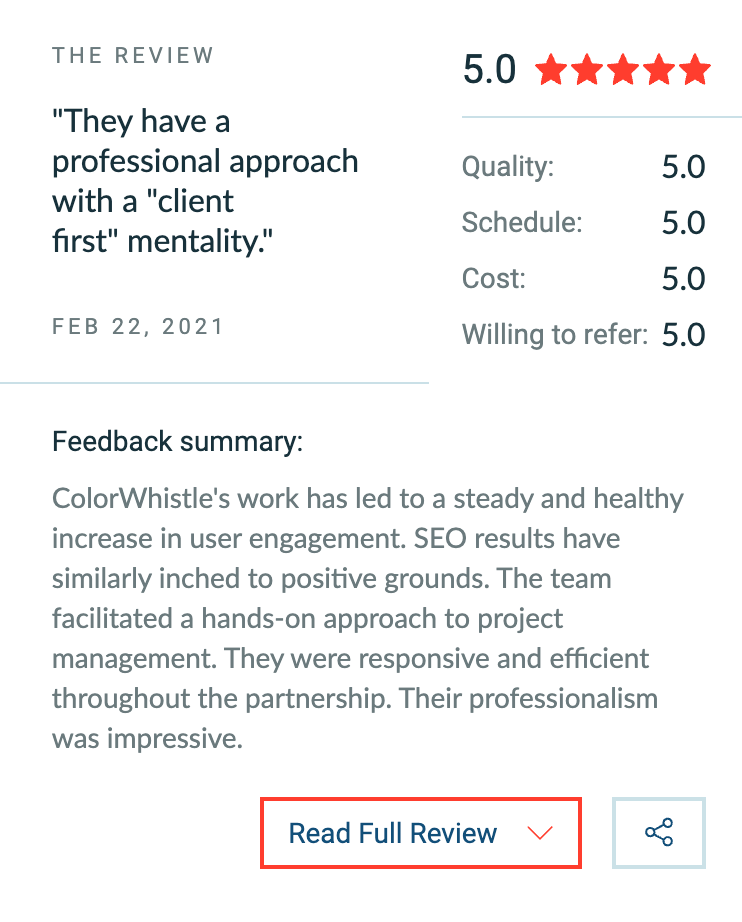
We take pride in the fact that our reviews from clients speak for themselves. Our ratings are always top-notch, and we’re happy to answer any questions you might have about them!
Get Access to Our Case Studies and Ebooks
Don’t just take our word for it – see yourself how our solutions have helped our clients,
Read casestudy
![travel company digital marketing Citizen Scientist Travel Website Development with WordPress & Rezdy API [Case Study] - ColorWhistle](https://colorwhistle.com/wp-content/uploads/2022/12/citizen-scientist-travel-website.jpg)
Citizen Scientist Travel Website – with WordPress & Rezdy API

Bhutan Travel & Tourism Website Design and Development Using WordPress
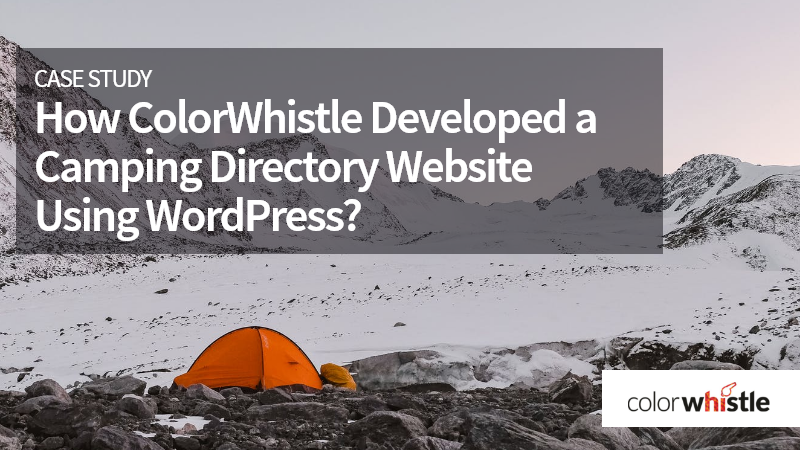
Camping Directory Website Development Using WordPress CMS and User Pro

Travel Booking Portal Development Using Rezdy API Case Study
Frequently asked questions about our travel digital marketing services, what are the services included in your travel digital marketing packages.
When it comes to digital marketing, the services you choose should align with your business goals and budget. We offer a comprehensive range of solutions tailored to your needs. Our complete package includes the following – Search Marketing, SEO, Social media marketing, PPC, content marketing, Ad campaigns, web design and development.
Why do I require a digital marketing service for my business?
In today’s digital age, digital marketing services are essential for businesses to thrive and stay competitive. It helps increase online visibility, reach a wider audience, drive targeted traffic, generate leads, build brand reputation, engage with customers, and ultimately, achieve business growth and success.
Do you offer measurable results for the travel marketing services you provide?
Yes, we prioritize providing measurable results for the travel marketing services we offer. We understand the importance of tracking and analyzing the impact of our strategies and campaigns on your business. This enables us to make data-driven decisions, optimize campaigns, and demonstrate the tangible outcomes we have achieved for your business. Our goal is to deliver measurable results that align with your objectives, ensuring transparency and accountability throughout our partnership.
How much does your travel digital marketing service cost?
At ColorWhistle, our pricing is tailored to match the unique needs and demands of each project. Instead of providing a standard price that may not align with your project’s requirements, we offer a personalized quote after reviewing the scope and objectives of your project.
What digital marketing strategies have you implemented for your business?
Our strategy encompasses leveraging SEO to enhance website visibility and drive substantial traffic. We employ content marketing to educate and captivate our audience, establishing our brand as an industry authority. Social media marketing is utilized to expand brand awareness and actively engage with our target audience. Additionally, we employ email marketing to foster lead nurturing and sustain strong customer loyalty.
Do you provide service globally?
Yes, we offer our travel digital marketing services globally, and we have clients from the US, UK, Canada, and Australia as we clearly understand the audience’s expectations from these regions.
Get the Inside Scoop Here
In order to provide accurate quotes and relevant suggestions for technology, it is helpful for us to have a clear understanding of the specific services you are seeking. At ColorWhistle, we take pride in delivering accurate quotes in a timely manner.
To assist us in this process, do provide as many details as possible about your project in the ‘message’ section.
Discussion Schedule: Ready for a GMeet Call Discussion Today / Tomorrow Available on a Phone Call Discussion Today / Tomorrow Send me a Calendar to Book The Meeting

Related Services We Offer
Slide this section to view the services we offer that can help you take a decision.
Graphic Design Services
Creative Graphic Design Services that are
Our Design Services Starts From $195
Social Media Design Services
Creative Social Media Design Services that are
WooCommerce Website Development
Creative WooCommerce Website Development that are
- Multi Device Support
Our Development Services Starts From $340
Non Profit Website Development
Creative Non Profit Website Development that are
- Cross Browser Tested
PPC Services
Creative PPC Services That are
- Advanced Targeting
- Full Transparency
- Scalable Pricing
Our PPC Services Starts From $180
Ready to get started?
Let’s craft your next digital story

Sure thing, leave us your details and one of our representatives will be happy to call you back!
Eg: John Doe
Eg: United States
Eg: [email protected]
More the details, speeder the process :)
- Business Essentials
- Leadership & Management
Credential of Leadership, Impact, and Management in Business (CLIMB)
- Entrepreneurship & Innovation
- Digital Transformation
- Finance & Accounting
- Business in Society
- For Organizations
- Support Portal
- Media Coverage
- Founding Donors
- Leadership Team
- Harvard Business School →
- HBS Online →

Digital Marketing Strategy
Key concepts, who will benefit, marketing professionals, non-marketing professionals, entrepreneurs.

What You Earn
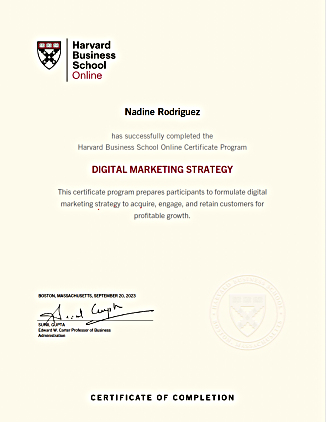
Certificate of Completion
Boost your resume with a Certificate of Completion from HBS Online
Earn by: completing this course
Marketing in the Digital Era

- DTC Brands: Fad or Disruption?
- DTC Brands: Innovations and Challenges, Part I
- DTC Brands: Innovations and Challenges, Part II
- Incumbent Responses
Featured Exercises
Crafting a digital marketing plan.

- Setting Objectives
- Defining Target Audience
- Determining Value Proposition
- Identifying Metrics
Acquiring Customers, Part 1: Paid Media

- The Challenges of Reaching and Acquiring Customers Online
- Search Advertising
- Display Advertising
- Utilizing Paid Media Channels
- Measuring Paid Media
Acquiring Customers, Part II: Owned and Earned Media

- Owned Media
- Earned Media
- Influencer Marketing
Engaging Customers

- Personalization
- From Storytelling to Story-Making
- Connecting Customers and Building Community
Allocating Budget and Measuring Success

- Budget Allocation
- Customer Lifetime Value
- Adobe Simulation
- The Future of Marketing
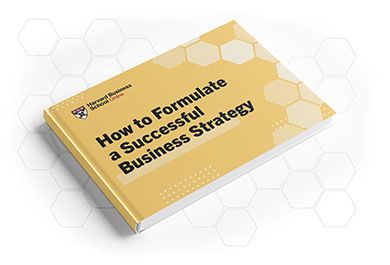
How to Formulate a Successful Business Strategy
Our difference, about the professor.

Sunil Gupta Digital Marketing Strategy
Dates & eligibility.
No current course offerings for this selection.
All applicants must be at least 18 years of age, proficient in English, and committed to learning and engaging with fellow participants throughout the course.
Learn about bringing this course to your organization .
Learner Stories

Digital Marketing Strategy FAQs
What are the learning requirements in order to successfully complete the course, and how are grades assigned.
Participants in Digital Marketing Strategy are eligible for a Certificate of Completion from Harvard Business School Online.
Participants are expected to fully complete all coursework in a thoughtful and timely manner. This will mean meeting each week’s course module deadlines and fully answering questions posed therein. This helps ensure your cohort proceeds through the course at a similar pace and can take full advantage of social learning opportunities. In addition to module and assignment completion, we expect participation in the social learning elements of the course by offering feedback on others’ reflections and contributing to conversations on the platform. Participants who fail to complete the course requirements will not receive a certificate and will not be eligible to retake the course.
More detailed information on course requirements, including the Adobe Data Driven Operating Model Simulation (one of the assignments), will be communicated at the start of the course. No grades are assigned for Digital Marketing Strategy. Participants will either be evaluated as complete or not complete.
Can you tell me a little more about the budget allocation simulation?
The budget allocation simulation (Adobe Data Driven Operating Model Simulation) will be part of module 6 of the course. It is similar to a mini capstone experience, in that it encourages participants to draw on their knowledge from the rest of the course to make investment decisions in the simulation. It is the very same simulation included in the MBA program's required curriculum marketing course, and, while designed to be challenging, it is ungraded and assessed based on completion. We recommend budgeting approximately 1.5 hours to complete the simulation. Full instructions for how to complete the simulation will be provided to course registrants.
What materials will I have access to after completing Digital Marketing Strategy?
You will have access to the materials in every prior module as you progress through the program. Access to course materials and the course platform ends 60 days after the final deadline in the program.
How should I list my certificate on my resume?
Once you've earned your Certificate of Completion, list it on your resume along with the date of completion:
Harvard Business School Online Certificate in Digital Marketing Strategy [Cohort Start Month and Year]
List your certificate on your LinkedIn profile under "Education" with the language from the Credential Verification page:
School: Harvard Business School Online Dates Attended: [The year you participated in the program] Degree: Other; Certificate in Digital Marketing Strategy Field of Study: Leave blank Grade: "Complete" Activities and Societies: Leave blank
Description:
Digital Marketing Strategy is a 7-week, 35-40 hour online certificate program from Harvard Business School. Digital Marketing Strategy equips professionals with the tools, mindset, and trends to make decisions about digital marketing strategy and tactics, including how to position a product or service for success, acquire and engage customers, and measure both performance of near-term campaigns and longer-term customer value.
Related Program

CLIMB enables new and experienced leaders to ignite their careers with a combination of vital and forward-looking business skills, self-reflection, and an immersive cohort-based learning experience with a diverse global network.
The promise of travel in the age of AI
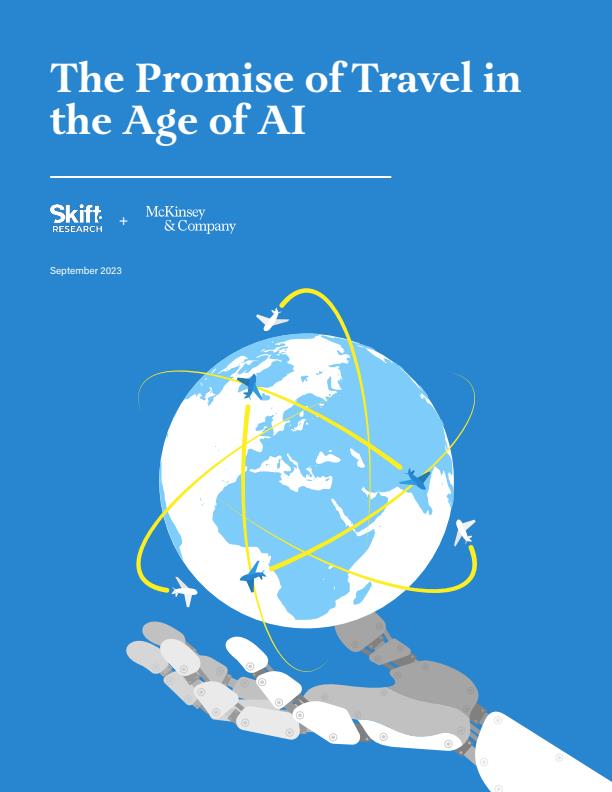
Every generation has its own “golden age” of travel, often defined by the widespread adoption of new technology—from the jet engine of the 1950s that drastically reduced travel times to the dot-com period of the 1990s that allowed customers to build their dream itineraries online. Today, a new era of digitally enabled travel is upon us. Advances in artificial intelligence (AI), including generative AI (gen AI), and machine learning (ML) are equipping the industry to reimagine what it means to plan, book, and experience travel. This surge of innovation sets the stage for travel companies to rethink how they interact with customers, develop products and services, and manage operations.
Advances in technology have also transformed consumers’ expectations. Since 2013, time spent on digital devices has grown by 70 percent, and this trend only accelerated during the COVID-19 pandemic as online interactions increasingly replaced in-person contact. 1 Based on data from U.S. Census Bureau and Statista. See State of travel 2023 , Skift Research, July 21, 2023. However, traditional travel is unique in that it is an inherently human-centric experience. The industry, therefore, has an opportunity—perhaps even a duty—to define what travel will look like in the digital age.
Most travel companies aim to provide exceptional service and deliver the perfect trip. But, instead of ease, excitement, and delight, travel operators too often fall short of meeting baseline expectations of timing and quality. In fact, nearly 80 percent of American travelers experienced at least one travel-related problem in the first half of 2023. 2 Lane Gillespie, “Survey: 77% of travelers plagued by travel problems amid booming season; more than half saw higher prices,” Bankrate, July 10, 2023.
In the 2021 report, Rebooting customer experience to bring back the magic of travel , McKinsey and Skift Research found that leisure travelers were eager to get back to the sky, water, and road—so much so, that they were often willing to overlook customer-service issues and inconveniences. Customer satisfaction ratings at the time were high, even in a period of intense disruption when negative sentiment was on the rise. 3 Rebooting customer experience to bring back the magic of travel , a joint report from McKinsey and Skift Research, September 2021.
Today, that window of acceptance may have passed. Customer expectations are rising, and tolerance is wearing thin. Despite this, people still aspire to travel and, according to McKinsey’s ConsumerWise Sentiment Survey, nearly a third of consumers intend to “splurge” on travel expenses in the next three months. 4 McKinsey ConsumerWise Global Sentiment Survey, August 2023, n=4,000. Through both established and new technologies, companies have the opportunity to keep the aspiration to travel alive by closing the persistent gap between the promise and reality of travel.
While larger companies may have more resources to develop in-house capabilities, a robust ecosystem of service providers makes new technologies accessible to companies of all sizes. According to McKinsey Digital estimates, companies that holistically address digital and analytics opportunities throughout their organizations have the potential to see a 15 to 25 percent earnings improvement.
A new report , The promise of travel in the age of AI , produced by McKinsey and Skift Research offers use cases and success stories that detail how technologies are being used, drawing from interviews with executives at 17 companies across five types of travel business. It explores how companies apply advanced data science to better understand and serve customers, delves into how digital and analytics tools can improve products and services, and examines how new technologies augment workforce capabilities and unlock operational capacity. This article highlights some key findings.
Know your customers like you know your friends
Over the past two decades, the variety and volume of customer data that travel companies can capture has increased dramatically; new tools and technologies such as AI-powered assistants are only accelerating this trend. However, this data is often difficult to process and does not always paint a full picture of the customer. Companies may turn to third-party sources to complete their understanding—combining and distilling commercial, operational, financial, and behavioral inputs. Robust marketing technologies can then help distinguish the “signal” from the “noise” in the data to better predict customer behavior.
Having gained a clear and comprehensive understanding, companies can create customer segments to guide how they interact with and serve different customers. Depending on the data available and the analytics capabilities at hand, segmentation can range from grouping customers into segments based on a single macro characteristic (e.g., business versus leisure) to individual “segments of one,” known as hyper-segmentation.

Drilling down to segments of one can enable hyper-personalization, which is broadly defined as the ability to uniquely tailor touchpoints to an individual customer’s needs, preferences, and behaviors. At its core, hyper-personalization is not only about increasing conversion rates, but about providing the customer with an end-to-end experience adapted to their specific context. Considering the level of personalization that is becoming the norm in many aspects of daily life, companies are adopting an ongoing test-and-learn approach to ensure their offers and actions resonate with customers’ rising expectations.
Hyper-personalization can also help companies rebuild trust if operations have gone wrong. Personalized communication reassures customers that they are at the forefront of the company’s mind and instills confidence that a thoughtful recovery plan is in place. For example, companies may share real-time status updates in moments of disruption and provide tailored solutions, or even proactive compensation, to ensure customers feel individually taken care of.
Design your products to surprise and delight
Recent advances are pushing the boundaries of what technology can accomplish. Nothing illustrates this better than the meteoric rise of AI platforms like ChatGPT which garnered one million users in only five days. 5 Steve Mollman, “ChatGPT gained 1 million users in under a week. Here’s why the AI chatbot is primed to disrupt search as we know it,” Yahoo News, December 9, 2022. While this pace of adoption may feel unsettling, it provides an impetus for companies to reimagine their product design and delivery using AI and digitization.
Historically, capabilities such as language, creativity, and aesthetic judgment—once considered uniquely human—could not be scaled through technology. AI, particularly gen AI, offers a new way to augment and scale these capabilities with the potential for enormous benefits: according to McKinsey research , generative AI has the potential to unlock between $2 trillion and $4 trillion in annual value across industries. 6 The economic potential of generative AI: The next productivity frontier , McKinsey, June 14, 2023. In the travel context, gen AI could take the form of a digital assistant that interacts with customers throughout the journey. It can provide personalized trip itineraries during discovery and booking, offer tailored recommendations based on preferences and real-time constraints during the trip, and help resolve unexpected disruptions.
However, AI is only part of the answer. Established digital technology also helps companies deliver on commitments made to customers. Many of these digital assets and tools rely on common systems and capabilities, making them widely attainable—freeing up staff to provide better face-to-face services and build relationships through the human touch. Several such applications can boost guest satisfaction and reduce points of friction in hotels, including guest apps, digital check-ins, digital room keys, and in-room tech. The magnitude of these individual tools is amplified when seamlessly integrated together, making it easier for customers to use digital applications throughout their hotel stay.
Empower your workforce to follow through on promises made
An engaged and productive workforce enables the delivery of experiences and products that satisfy customers. However, the travel industry faces structural labor hurdles and high turnover which makes attracting, training, and retaining top talent challenging. Fortunately, the industry can enhance and scale the capacity of its existing workforce by equipping the frontline with the right tools at the right time. This can free up employees to focus on the things they enjoy most and that make the travel industry tick: quality personal interactions with customers, in essence, the human touch.
Two promising opportunities to improve workforce and operational performance through technology stand out across the travel industry: augmenting frontline capacity and upskilling talent.
In the travel industry today, complex decisions still rely on human expertise and outdated technology such as greenscreen or rudimentary interfaces. This leads to a best-guess approach, the risk of negative outcomes, and a steep learning curve. Travel companies are developing new tools for the frontline to process complex inputs and help guide “day-of” decision making. For example, advanced simulation models such as digital twins allow companies to conduct rapid “what-if” analyses and provide real-time guidance to the frontline.
According to McKinsey research , new technology, including gen AI, is also shortening training times for new hires while rapidly upskilling the existing workforce. For instance, virtual and augmented reality are used to simulate real-life scenarios to prepare frontline employees to hit the ground running, and gen-AI-enabled "teaching assistants” provide personalized coaching based on individual performance. 7 “ The organization of the future: Enabled by gen AI, driven by people ,” McKinsey, September 19, 2023.
Travel is ripe for innovation
Checklist for the age of ai.
Some travel companies are already successfully deploying digital technology, AI, and ML to reshape how they interact with customers, develop and deliver products and services, and manage people and operations. They’ve taken the following actions—are you on track?
General considerations
- created a digital wish list—as if the company had infinite time and resources
- prioritized wish list based on potential short- and long-term benefits as well as the company’s strategic vision and available resources
- assessed the skills and talent necessary to execute against the prioritized wish list
- built the right team and identified roadmap to fill remaining gaps
- inventoried existing internal customer data
- determined which data variables drive customer behavior and predict customer buying decisions
- identified relevant third-party data and integrated with internal data to build a complete customer picture
- considered using a robust MarTech stack to continuously learn and evolve with customers
- defined a dynamic segmentation and personalization approach based on customer personas
- adopted test-and-learn mindset to continually implement and refine
- mapped the end-to-end customer journey and identified pain points
- used analytics to determine which pain points impact customers the most
- considered new technology (like AI) to enhance and reimagine the customer journey
- brainstormed improvements to current digital offerings that would minimize pain points (such as more timely communication)
- built a product roadmap based on timing and importance of features
- diagnosed top day-to-day employee pain points
- determined if digital tools can resolve top pain points (for example, automate repetitive tasks)
- provided workforce with real-time visibility into critical areas of daily operations
- used simulation models to plan for multiple future-state scenarios
- built decision-making tools (such as digital twins) to choose optimal solutions for complex problems
- defined opportunities to improve training (using tools such as simulation training, VR, AR) and provide feedback (using smart-AI tool)
We believe this is a moment of optimism for the industry. Between reclaiming its historical share of GDP, benefiting from the ongoing corporate travel recovery, and catering to consumer demand for unique experiences, the stage is set for travel’s accelerated growth. Looking ahead, travel is forecasted to grow at an average of 5.8 percent a year through 2032—more than double the expected growth rate of the overall economy (at 2.7 percent a year). 8 “Travel & Tourism sector expected to create nearly 126 million new jobs within the next decade,” World Travel & Tourism Council, April 21, 2023.
This does not mean that travel companies can simply sit back and reap the benefits. Existing and new technologies provide an avenue for companies to capture their share of the industry’s anticipated growth by resetting how they interact with customers, deliver products and services, and empower their workforce. Fortunately, there are a growing number of ways—build, buy, or partner—to help companies get started. The only wrong move is no move.
Susann Almasi is an associate partner in McKinsey’s Carolinas office, Alex Cosmas is a partner in the New York office, Sam Cowan is a consultant in the Minneapolis office, and Ben Ellencweig is a senior partner in the Stamford office.
The authors wish to thank Skift’s Pranavi Agarwal, Seth Borko, and Wouter Geerts as well as McKinsey’s Marisa Ancona, Danielle Bozarth, Vik Krishnan, Nina Lind, Elena Patel, Alessandra Powell, Jules Seeley, and Nirva Vassa, for their contributions to this article.
Explore a career with us
Related articles.

What every CEO should know about generative AI

Generative AI and the future of work in America

The future of tourism: Bridging the labor gap, enhancing customer experience
Subscribe to our Marketing and Sales E-Alert.

Marketing and Sales
/ article, creating a data advantage in marketing—with or without cookies.
By Eric Jesse , Karen Lellouche Tordjman , Derek Rodenhausen , Robert Derow , and Nathan Schoeffler
The end of third-party cookies was at hand until it wasn’t. In April, Google announced that it would push back the implementation of Tracking Protection, which aims to block third parties from gathering cookie data on its platform. This is the third time that Google has delayed the sweeping change, and with these delays, businesses are starting to feel cookie fatigue, left wondering what to do and when to do it.
The So What
Although it’s easy to fall into a “wait-and-see” posture, companies should not delay their cookie-less future preparation. Despite years of notice, most companies aren’t ready for cookies to go away. Nearly 80% of programmatic ad buys centered on these third-party data elements as late as the third quarter of 2023—and many businesses are increasing the amount they’re spending this year, according to data from eMarketer. 1 1 Daniel Konstantinovic, “Google Turns Off Cookies for 30 Million Chrome Users, and That’s Just 1%,” eMarketer, January 8, 2024; Sara Lebow, “Advertising Still Looking for Ingredient to Replace Cookies,” eMarketer, January 4, 2024. Notes: 1 Daniel Konstantinovic, “Google Turns Off Cookies for 30 Million Chrome Users, and That’s Just 1%,” eMarketer, January 8, 2024; Sara Lebow, “Advertising Still Looking for Ingredient to Replace Cookies,” eMarketer, January 4, 2024.
But other companies are revamping how they buy media, measure performance, and collect information from their customers. These leaders are leaning into interactions that give customers value in exchange for their information and creating rich direct-to-consumer experiences in the process. While legacy cookie-dependent tactics may have a longer shelf life than initially anticipated, advertisers should forge ahead with their roadmaps, which can drive substantial value in addition to being preparative.
Brands that have successfully adapted to the cookie-less future have seen their digital marketing performance improve by 10% in the case of mature enterprises and up to 100% for small and medium-sized businesses, based on BCG experience.
First-party data—the information companies collect from their own audiences and channels—isn’t simply a substitute for third-party sources, it’s a superior product. And for leaders that equip their organizations, it presents a massive opportunity. Here are the steps to take now.
Maximize the first-party data you have and create value exchanges to gather more. Marketers can use the first-party data they already have resident in their enterprise resource planning (ERP) systems to begin building segment profiles. Sites should be optimized for first- party data acquisition, with enabled sign-in capabilities, quality consent capture, and various opportunities for data enrichment to develop more robust customer profiles. Marketers can then create value exchanges to deepen their data insights—offering customers discounts, free samples, event invitations, or other incentives in return for sharing personally identifiable information. (See Exhibit 1.)

Copy Shareable Link
Develop independent marketing performance measures. With a changing digital ecosystem, marketers will need to reassess their current measurement tech stack and develop new solutions to compensate for the weakening fidelity of current cookie-dependent attribution methods. Matched market tests, cohort-based tests, and pre/post assessments are just a few examples of effective frameworks that can measure the incremental impact of marketing tactics across online and offline channels—without reliance on third-party cookies or outside mechanisms. (See Exhibit 2.)

Baseline marketing testing can help companies assess the strength of their media tactics and navigate the changing digital ecosystem with greater confidence. Platform-native measurement solutions cannot provide the baseline analysis needed, but matched market tests can. These statistical analyses measure the incremental impact of marketing tactics across online and offline channels. And because they rely on transaction data that your organization owns, the analysis is insulated from cookie-based measurement changes.
Upgrade to the latest capabilities within large tech platforms. Marketers should update their tech capabilities in channels that have reliable measurement solutions and require consumer sign in, such as Google, Meta, TikTok, and Amazon. The latest platform solutions such as Google Analytics 4 and Meta Conversions API come with robust privacy-centric attribution models that can link digital performance to media tactics. These solutions have multiple attribution specifications, and each marketer will need to understand the model that works best for their business.
Modernize your tech stack and customer data platform (CDP). Starting with the CDP, leaders can aggregate and govern first-party data, using a roadmap to lay out the vision and ensure key operating model changes are made. They can then expand their martech stack and use case library to build audiences, retarget prospects, and activate customers across owned channels. Audience management technology is critical for understanding customer journeys and optimizing touchpoints across platforms to drive better user experiences and performance outcomes.
Embed test-and-learn ways of working. Companies need to roll out pilots and monitor performance continually to avoid stagnation. Instead of a one-and-done mindset, businesses need to approach campaigns as an ongoing test-and-learn exercise, involving cross-functional inputs to ensure implementation and value. These practices use agile teams, sprint-based pilots, and dynamic optimization to manage the post-cookie checklist. (See Exhibit 3.)

If You Do Nothing Else
Take a hard look at your media campaigns. Client assessments often reveal wasted impressions, including substantial overexposure across audiences and bidding in geographies that are out of their target footprint. Map your first-party data capabilities and understand what data you have access to now, and how it can be segmented and overlaid with your current media approaches. In tandem, build a modern compliance program to address the more stringent regulatory requirements that come from using first-party data.

Managing Director & Senior Partner
Mexico City

Managing Director & Partner

Los Angeles

Lead Growth Architect
ABOUT BOSTON CONSULTING GROUP
Boston Consulting Group partners with leaders in business and society to tackle their most important challenges and capture their greatest opportunities. BCG was the pioneer in business strategy when it was founded in 1963. Today, we work closely with clients to embrace a transformational approach aimed at benefiting all stakeholders—empowering organizations to grow, build sustainable competitive advantage, and drive positive societal impact.
Our diverse, global teams bring deep industry and functional expertise and a range of perspectives that question the status quo and spark change. BCG delivers solutions through leading-edge management consulting, technology and design, and corporate and digital ventures. We work in a uniquely collaborative model across the firm and throughout all levels of the client organization, fueled by the goal of helping our clients thrive and enabling them to make the world a better place.
© Boston Consulting Group 2024. All rights reserved.
For information or permission to reprint, please contact BCG at [email protected] . To find the latest BCG content and register to receive e-alerts on this topic or others, please visit bcg.com . Follow Boston Consulting Group on Facebook and X (formerly Twitter) .

One Platform. Limitless Potential.
Clickbank e-commerce platform & affiliate marketplace.
Sign up for a free ClickBank account to access our industry-leading affiliate marketplace, ultra-reliable tracking, and unrivaled direct response expertise. Build, market, and scale your business with ClickBank!
Affiliates choose ClickBank because of our high-converting affiliate offers, reliable tracking, on-time payments, and industry-leading education. Get started on ClickBank for free!
ClickBank offers powerful ecommerce and affiliate management solutions for thousands of product owners, businesses, and brands looking to scale their products online.
5M+ people trust ClickBank

Monetize your traffic
Become an affiliate.
Over 100,000 affiliates worldwide choose ClickBank as their preferred marketplace, and for good reason: we’ve paid over $6.2 billion in commissions on time for more than 25 years!
Popular Affiliate Resources

Getting Started with ClickBank
Free beginner affiliate course to set up an account and start making sales on ClickBank!
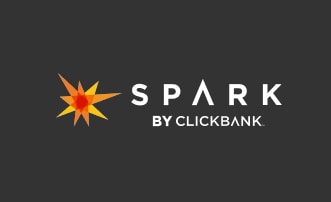
Spark by ClickBank
Spark is a trusted collection of courses, community, and tools to help you learn affiliate marketing.
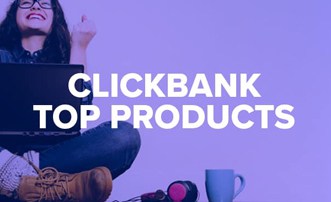
ClickBank Top Offers
View the tools, services, and software that integrate seamlessly with ClickBank’s platform.
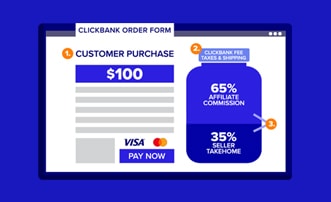
How ClickBank Works
Discover the nuts and bolts of the ClickBank experience.
Acquire new customers with affiliates
Sell your product.
Whether you’re an established brand or a new entrepreneur with a big goal, ClickBank will give you the tools and support you need to seamlessly scale online.
Popular Seller Resources
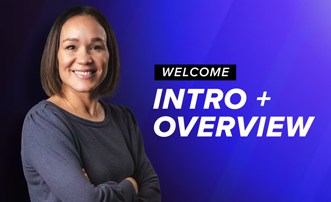
Ecom to DR Success Center
Find out how to transform your e-commerce product into an attractive direct response offer for performance affiliates to promote.

Seller Launch Checklist
Learn how to onboard your product to ClickBank with a step by step guided tutorial.

CPA Seller Guide
A ClickBank official guide on how to offer CPA in your affiliate program.
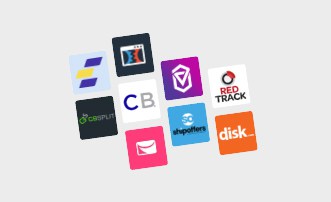
Integrations
Courses. community. tools., so, what is spark.
Spark is a trusted collection of courses, community, and tools to help you learn affiliate marketing, how to use ClickBank, and how to drive traffic in order to kick start your efforts to make money online.
Taught by the employees who run ClickBank and our most successful clients.
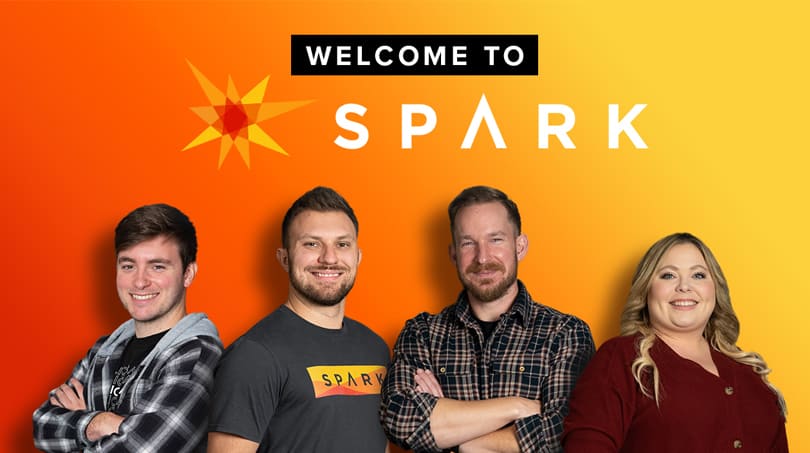
Popular Spark Resources
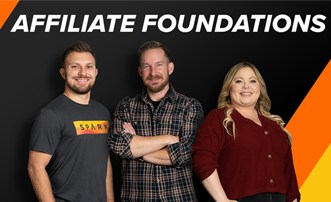
Affiliate Foundations
This program is designed with one simple goal in mind: Getting you that first paycheck as fast as possible and on your way to earning thousands of dollars in commissions.
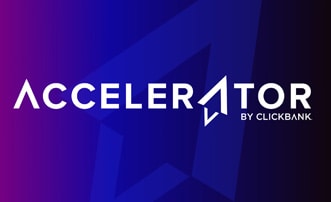
Landing Page Lesson
Our landing page lessons walks you through all the essential foundations of building a high-converting funnel and landing page.
Free Course
Get your ClickBank Affiliate journey started with our Free course!

Discord Community
A one-of-a-kind community set up for all our affiliates to be able to connect, brainstorm, troubleshoot, celebrate, and grow together!
Worldwide Leader in Affiliate Marketing & Ecommerce Growth
At ClickBank, your company is in good company. The ClickBank platform empowers entrepreneurs and brands across the globe to grow, scale, and reach customers like never before. We’ve paid out more than $6.2 billion over the last 25+ years, but we’re just getting started. Is your business our next success story?
What People Say About ClickBank
Michael Curtis
“Since joining Clickbank, I’ve experienced nothing but the best. My earnings are never late and products for sale have improved a lot over the years.”
Jonathan Mizel
“I have been using Clickbank as a buyer and seller since they launched, over 20 years at this point. Great service all around, love and trust them completely.”
“I sell a product via Clickbank (pianoforall.com) and I have had amazing success through their affiliate system – can’t fault it and would highly recommend them.”
Kevin Butters
“Great affiliate network, good vendor offers and regular payments make this the no1 choice for affiliate marketers.”
“Fantastic platform for selling your products. I’ve been doing it full time for the last 10 years. Payments are always on time & account managers are always very helpful. Keep it up!”
Dawn Sylvester
“Great tool for vendors and affiliate marketing. I have found ClickBank very easy to navigate as a vendor, AND have found it simple to use as an affiliate marketer.”
Surya Kumar
“Clickbank is the best affiliate marketing network. We work with a bunch of networks and Clickbank is always on the top of our list.”
Frequently Asked Questions (FAQ)
How do I get started as an affiliate on ClickBank?
First, you should sign up for a free ClickBank account here . Then, you can browse the ClickBank marketplace and find offers to promote in your chosen niche or vertical.
For more information, check out our ClickBank for Beginners guide or our free video affiliate course – these are both step-by-step resources for affiliates looking to get started .
How do I get started as a seller on ClickBank?
Building an affiliate program and becoming a seller on ClickBank starts with the type of product you sell. Get a full checklist and walkthrough for onboarding your product with our Seller Launch Checklist here .
How does ClickBank work?
ClickBank is an e-commerce platform and affiliate marketplace that serves as an intermediary between the end customer, product owner, and affiliate marketer. As the merchant of record, ClickBank processes each order and routes the funds from each transaction to the parties involved in a purchase.
Learn more about how ClickBank works here .
What’s new on ClickBank?
We’ve introduced a handful of exciting new features in just the last few years. These include an overhauled affiliate marketplace, improved order forms, CPA commissions, twice weekly payments, and powerful integrations, including with Shopify.
Does ClickBank offer CPA?
Yes, ClickBank offers both a revenue share ( RevShare ) and cost-per-action (CPA) commission structure! You can learn more about CPA on ClickBank here .
What tech integrations does ClickBank have?
ClickBank features robust native integrations with a wide range of popular software tools and services. These include Voluum , ClickFunnels , Everflow , Bluehost, AWeber , and ShipOffers . See the full list of integrations here .
Where can I learn more about affiliate marketing?
ClickBank offers plenty of free resources on the ClickBank blog and YouTube channel . If you want to take your learning to the next level, check out Spark by ClickBank , our official affiliate marketing education program with courses on copywriting, email marketing, paid ads, organic traffic, and more!
Ready to get started?
There’s never been a better time to promote or sell on ClickBank!
- Do Not Sell My Personal Info

- ⋅
Google Marketing Live 2024: The Ultimate Recap For Advertisers
After attending Google Marketing Live, SEJ contributor Brooke Osmundson shares the top product updates for Google Ads, covering creatives, media, and measurement.
- Google unveiled 30 product updates at Google Marketing Live, mostly focused on AI.
- Key updates include AI-powered image editing, animated image ads, and new ad placements.
- Advertisers should embrace video content and develop AI strategies to stay competitive.

After ten years of watching Google Marketing Live virtually from my computer, I had the opportunity to attend the event in person this year.
If you’re not familiar with it, Google Marketing Live is an annual event put on by Google that showcases its major product announcements for Google advertisers.
This year, Google unveiled 30 product updates for Google Ads! While not all of them were mentioned during the keynote, there was one core theme of the updates:
The majority of product updates can be categorized under these main components of Google Ads:
- Measurement.
Now that the event is over, I’ve had time to digest these platform announcements and really think about how to use them as an advertiser—or at the very least, what these updates can mean in the broader scope of marketing.
Below are my top product updates I’m most looking forward to in 2024.
AI Creative Announcements
As expected, Google announced multiple updates specifically around ad creatives and functionality for advertisers. These include:
- AI-powered image editing. Advertisers can edit images (including product feed). AI-generated images will appear in recommendations for Performance Max campaigns. Add and remove objects, extend backgrounds, and adjust image sizes to meet many sizes, orientations, and ratios.
- New brand standard guidelines. Advertisers can provide Google AI with brand guidelines, colors, and fonts. The option to upload example images as a reference point for the generative AI will also be available.
- Animated image ads for Demand Gen campaigns. If you have a Merchant Center account, you can serve animated image ads on YouTube Shorts and video ads. The animated images will be automatically generated from your product feed images.
- Integrations with creative platforms. Google now has partnerships with Canva, Smartly, and Pencil Pro to integrate into the Google Ads asset library. This means you can create assets on those platforms and export them to Google Ads.
As far as timing goes, not everything announced is available right away.
According to Google, the new brand standard guidelines will be rolled out in the later months.
Related: Google Ads: A Quick Guide To Every AI-Powered Ad Creative Feature (And What’s Coming Soon)
AI Media Announcements
During the live keynote, one of the most livening parts was Philipp Schindler’s demo with its generative AI technology.
It sparked imagination around non-traditional ways to search and interact to find new information.

With that comes some new ad space available for advertisers.
Some of the key media announcements within Google Ads include:
- Shopping ads to appear in Google Lens and Circle to Search. This is a new ad space and experience in the visual search results. Your shopping ad will showcase products when they’re relevant to the photos and screenshots users search with.
- Search and Shopping ads to appear in AI Overviews. Another new placement is unlocked – in the United States for now. Ads from existing AI-powered Search and Performance Max campaigns may be able to show in the AI Overview “Sponsored” section when they’re relevant to both the user search and the output from AI Overview.
- Conversational campaign creation. While this was announced last year, Google published more data showing that SMBs who use the conversational tool are 63% more likely to publish search campaigns with ‘Good’ or ‘Excellent’ ad strength.
- New loyalty promotions. Advertisers running Performance Max and Standard Shopping campaigns will have a way to tailor promotions like special pricing or member-only exclusive offers.
Similar to the creative announcements, not all these are live immediately.
Shopping ads and loyalty promotions will roll out over the next few months in visual search results.
By now, we’ve all likely heard some shocking outputs from AI Overviews. Google is starting this ad placement rollout as a small experiment in the United States and will take its learnings from all inputs to provide a better experience as it matures.
AI Measurement Announcements
While I thought there would be more hype around measurement improvements, there was only one brief callout about more in-depth reporting on Performance Max campaigns.
A more robust outline of measurement announcements included:
- Asset-level reporting in Performance Max. In the next few months, you’ll be able to see conversion metrics for each creative asset. This is a huge win for advertisers after years of being unable to report at this level of detail.
- Performance Insights in Merchant Center Next. More tailored recommendations and generated insights are coming to Merchant Center Next, along with conversational reporting requests, with more visual insights quicker.
- New audience signals in App campaigns. Another huge win for app advertisers! Advertisers can now link a wide range of audience lists, including first-party data audiences. Google AI will learn from the audience inputs to show ads to users more likely to convert.
- New Measurement Diagnostics hub. Advertisers can validate and troubleshoot any measurement setup within Google Ads. You’ll also see your measurement durability and readiness in this hub to build and activate first-party data audiences.
- Marketing Mix Models attribution. Google announced its newest open-source Marketing Mix Model (MMM), Meridian. It will help you measure the impact of your entire marketing strategy and make informed campaign decisions.
- Better iOS measurement with SKAdNetwork enhancements. New reporting updates are available across the Google Ads API and third-party app attribution partners, and a new beta is available to integrate your SKAdNetwork conversion value schema into Google Ads. This will help enhance any iOS app campaigns using tCPA or tROAS bidding strategies.
Summary: What This Means For Advertisers
In the short hour and 15-minute keynote, we were presented with a wide variety of new updates. As you can see below, these updates affect many different campaign types and are either available today or will be coming in the next few months.
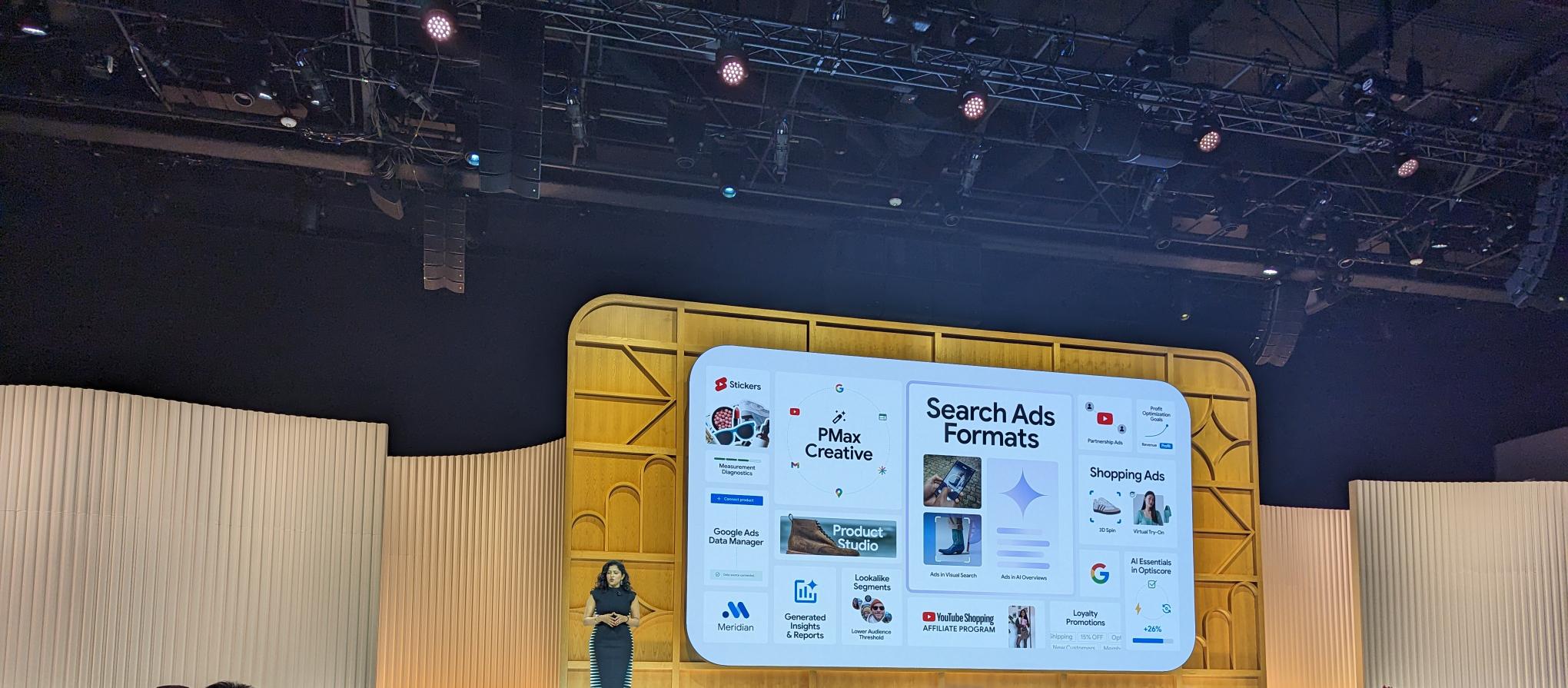
So, with these updates, is there a larger theme at play?
In the grand scheme of the Google Marketing Live updates, a few major themes stood out to me.
1. Video content is key.
A lot of updates from Google Marketing Live revolved around content creation, automation, and animation.
Essentially, Google seems “all-in” on video content—specifically YouTube Shorts.
If you don’t incorporate video content into your marketing strategy, you may fall behind your competitors and see lower engagement.
Some advertisers shy away from video content because it seems tedious, too complicated, or insufficient resources.
With Google’s updates, anyone can start with video content from their phone. Google’s tools can turn images into video content.
Incorporating video into your Google Ads strategy can help you connect better with your target audience.
2. AI strategies are a must-have.
During the keynote, Google said, “AI is not a marketer.”
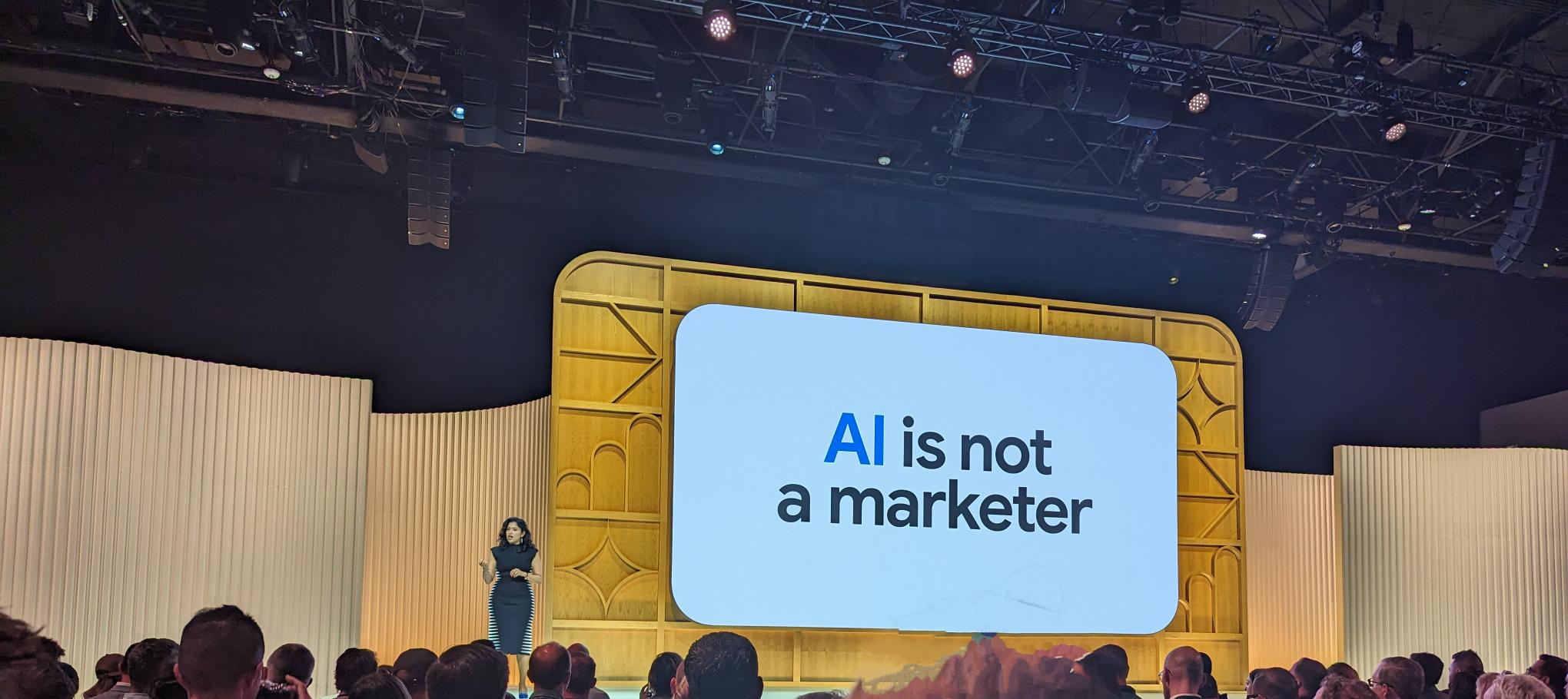
Basically, your jobs are safe right now, advertisers.
So, while AI is not a marketer, we marketers must have an AI strategy to keep up with these changes.
Trying to outsmart the Google Ads system or retaining too much control will prevent your campaigns from growing and scaling as they need to.
To have a successful AI strategy, think of a few of these main points:
- Always ensure the goal and measurement setup is correct.
- Set realistic bidding strategies so Google can learn from these inputs.
- Send appropriate signals to Google within your campaign setup.
AI outputs are typically only as good as the inputs it gets. That’s where you, the marketer, come in.
When used correctly and strategically, these new AI tools can help scale your workload, learn faster, and make more real-time decisions to optimize your campaigns.
You can find the full recap of Google Ads product announcements in the official article from Google.
Featured Image: Veroniksha/Shutterstock
Brooke serves as the Director of Growth Marketing at Smith Micro Software, with over 10 years of paid media experience. ...
Subscribe To Our Newsletter.
Conquer your day with daily search marketing news.
The Ultimate Marketing Plan Template For 2024 [FREE]
The Ultimate Guide to Creating a Marketing Plan. Get our marketing plan template for FREE + Budget plan + Calculators + best marketing toolkit for 2024.
Rakefet is the CMO at Mayple. She manages all things marketing and leads our community of experts through live events, workshops, and expert interviews. MBA, 1 dog + 2 cats, and has an extensive collection of Chinese teas.
Learn about our
Natalie is a content writer and manager who is passionate about using her craft to empower others. She thrives on team dynamic, great coffee, and excellent content. One of these days, she might even get to her own content ideas.
Updated May 1, 2024.
![travel company digital marketing The Ultimate Marketing Plan Template For {year} [FREE] main image](https://entail.mayple.com/en-assets/mayple/650088e0cb774e97df948465_2020plantemplate_62bf744fa2ed5695822ec7ef32e72f92_2000-1699777110763.png)
It takes time to build a marketing plan and it will change anyway, right? 100%. But creating your digital marketing plan is worth every minute of your time. If you build a business without a marketing plan, it’s like constructing a house without a blueprint. And you need a really good marketing plan template to get you on the right track.
Before we give out all the information and knowledge you need to create your winning marketing plan, let's start by giving you a FREE Digital Marketing Plan Template for 2024 . This is a great example of a great marketing plan that looks snazzy, too 😉.
Click on the image below, and make your own copy or download it to start using this template today.
Now that you have your marketing plan template, let's go over some basics before diving into more advanced aspects of marketing planning.
What is a marketing plan?
A marketing plan is a document that details how you're going to execute your strategy. It's written for a specific period of time and explains both your current situation and your future plans.
What’s the difference between a marketing plan and a business plan?
A marketing plan may be part of an overall business plan. A solid online marketing strategy is the foundation of a well-written marketing plan. While a marketing plan contains a list of actions, without a sound strategic foundation, it is of little use to a business. It has to have a set of concrete tasks and marketing tactics to follow.
Why do you need a marketing plan?
There are a ton of reasons why every brand and marketing team needs a good marketing plan.
Here are the top 3 reasons:
Create better goals
When you have specific goals to achieve you can plan your way to achieve them. Having too general goals like "growing my business" VS. measurable KPIs like "I want to grow my revenue by $600K, and to do that I need 1,000 new customers" is different.
Actual KPIs can help you plan exactly what will get you there. We recommend you set up some SMART goals - which stands for specific, measurable, achievable, relevant, and time-framed.
Improve your focus
Marketing without focus can be very messy and super ineffective. Have you ever tried to run a company meeting without an agenda? Just like meetings, marketing needs focus.
The best tip we can give you is to focus on specific activities and have them done well. A digital marketing plan will help you focus on exactly the tasks that will impact your success.
Of course, things will change and your plan will change as well. But as long as you are using a good marketing plan outline you will have your next month’s tasks written down and your work will become that much more effective.

Stay consistent
The purpose of a marketing plan is to ensure that marketing activities are relevant and timely to achieve the organization's business objectives. It's a plan defining a sustainable competitive position and defining the resources necessary to achieve it.
Now that you know what a marketing plan is and what’s used for let’s talk about the key components that it’s built out of.
How do you make a good marketing plan?
A good marketing plan should have the following parts -
- Executive Summary
- Mission statement
- Market Analysis (SWOT)
- Competitor Analysis
- Target market & buyer personas
- Marketing objectives and KPIs
- Pricing strategy
- Growth strategy
- Marketing channels
And as a bonus we’ve added two more sections:
11. BONUS: How to assemble the right marketing team 12. BONUS: Top tools for marketing plan creation & design
Each of these key elements is vital for the right execution of your marketing strategy and I promise you it’s not as difficult as it looks.
Let’s dive in.
1. Create an executive summary
This might seem a little too formal for some marketers out there but it’s essential and I’ll explain why.
Marketing plans tend to get really long so it’s better to create a quick summary and highlight some of the key points of every aspect of your plan right at the beginning. This becomes the foundation of your marketing plan.
There is no set length for an executive summary but it should cover all of the main elements of your marketing plan. It should also quickly tell your story and highlight what you are trying to achieve. Add your KPIs, marketing channels, market strategy, and budget.
A good executive summary should give a quick taste of the entire plan and entice the reader (investor, upper management, CEO, etc) to read the rest.
Here’s a great 2-minute video from Hubspot that shows how to write an executive summary from start to finish.
The next section of the marketing plan has to do with your “why”.
2. Create a mission statement
A good mission should have 3 critical components -
- An overall mission or vision of the company
- The company’s core values
- The goals and marketing objectives
The key is to keep it precise, short, and powerful. Don’t write a long essay, don’t just throw a bunch of jargon around, and do get some input from the employees at the company.
Employee feedback on this is critical because marketing and sales activities have to align with the mission of the company so all the various teams in the business have to be in agreement on the general mission.
The worst thing you can do is have a mission that has no direct correlation to the actual activities or tasks. Such a mission won’t help you grow your business .
What’s the difference between the company vision and its mission?
The vision is like the why, the overarching goal and foundation of the company. The company’s mission includes the vision and adds to it the actions and activities that the company will do to help advance its vision. Here’s a great video by Simon Sinek that explains this concept.
Now let’s talk about how you are going to go about achieving that mission.
The first step is to understand the market and your particular industry.
3. Market analysis
Have you ever seen the TV show Shark Tank?
The first part of any pitch is a personal story and a quick description of the founders’ “why”. This is where you can find the vision and mission of the company.
Next, they almost always mention the size of the market and they quantify the opportunity that they are presenting to the sharks.
This is exactly what a market analysis is.

A market analysis is a quantitative and qualitative assessment of a market. It looks at the size of the market in terms of the value ($) and volume (quantity of product sold) and often highlights some of the latest trends or environmental conditions that define the opportunity cost.
So how do we do this?
A great way to structure this is by using the SWOT analysis technique.
What is a SWOT analysis?
A common marketing framework that can help you create a good marketing analysis is called the SWOT framework . It stands for strengths, weaknesses, opportunities, and threats .
Strengths - what is your company really good at? what makes you unique? what unique advantages do you have over your competition? What is your value proposition? What are some of the key resources, processes, and capabilities that your company has?
Weaknesses - what are the weakest points of the business? What are some of the areas in which you could improve on? What is your company lacking compared to your competitors?
Opportunities - what are the biggest trends in the market that could give your company an edge or an advantage? These could be demographic patterns, lifestyle choices, population dynamics, or governmental regulatory policies.
Threats - what are some of the external factors in the market that could negatively impact your business? What are some environmental factors that you should be aware of? What are some possible changes that could threaten your business performance and success?

Pro tip: Want to do your own SWOT analysis? Get our Marketing SWOT Analysis Template .
4. Competitive analysis
The next vital step is to understand your competition and what the competitive landscape looks like in your industry or niche.
The main questions your competitive analysis should answer are:
- Who are the competitors?
- What marketing strategies are they employing?
- And how are they going about achieving their goals?
Here’s one of my favorite competitive analysis frameworks from the renowned Myk Pono:

Now that you’ve completed your competitive analysis it’s time to zero in on your ideal customer.
5. Define your target market and buyer personas
The best way to create target personas for any brand is by creating a customer journey map. A customer journey map is a visual representation of all the various touchpoints that your brand has with a prospective customer.
This is a critical part of creating your marketing strategy.
Google introduced the moment of truth concept and this really relates to our discussion of marketing channels but it’s important to mention here as well.
Shoppers can find and interact with your brand through hundreds of channels, both online and brick-and-mortar. The Zero Moment of Truth (ZMOT) concepts represents that stage of the buyer’s journey that leads them to find your product or solution for their problem.
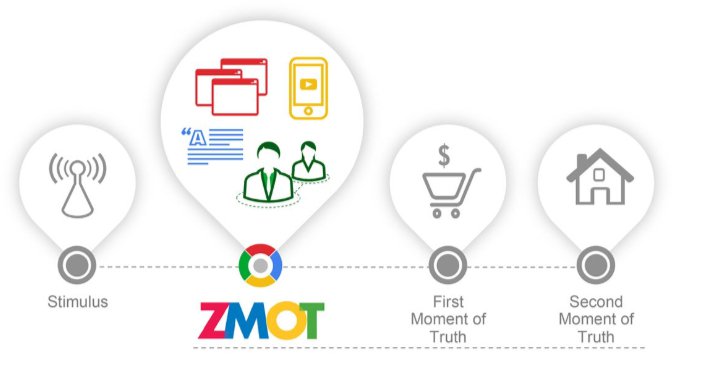
Identifying the specific problem that the customer is looking to solve is critical. This is how you define your persona and this is what ultimately affects the rest of your marketing decisions.

Here's a great buyer persona template from Hubspot to help you create better audience personas.
6. Define your goals and KPIs
The first step when building a marketing plan is to understand and define which business goals are the plan aiming to achieve. Business and marketing should always go hand-in-hand - remember that. Questions you should answer are:
- What are the business goals I need to achieve?
- What KPIs will get me to achieve my goals?
- What does my marketing funnel look like?
Pricing is often part of the market and competitive analysis sections but sometimes brands discuss it separately. It depends on how important price considerations are for your business and how competitive your market is. For example, if a major advantage in your business is that your product is priced significantly lower than your competition then a pricing strategy will play a key role in your marketing plan.
On the other hand, if you are a brand like Apple that is trading on the quality and its other features more than a price comparison, then your focus will be less on price.
There are 5 common pricing strategies:
1. Cost-based pricing
This is when the price is solely based on the costs of the products. The company simply takes the cost it takes to produce the product or service and adds a markup.
2. Value-based pricing
This strategy is based on the perceived value of your product. So a great example here is a company like Apple that prices its products significantly higher than its competitors because of the perceived value they provide.
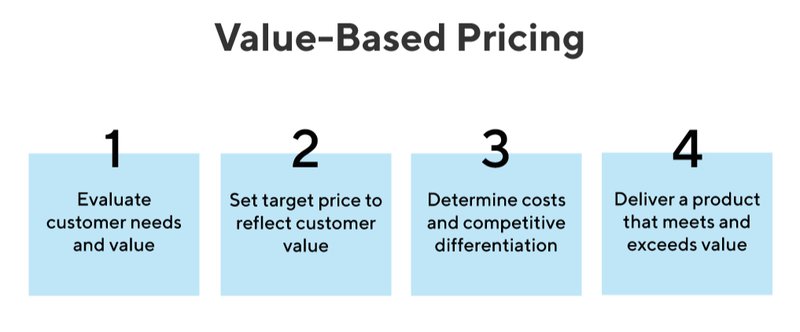
3. Competitive pricing
This is when a company sets a price based on what the competition is charging. A great example here is gas stations. Each gas station competes with the other stations on the block, trying to outbid the other.
4. Price skimming
This strategy involves setting a high price and then lowering it as the market evolves. A lot of tech products have a high price when they first launch in order to maximize profit and increased their perceived value.
5. Penetration pricing
Penetration pricing is the exact opposite of price skimming. It involves pricing a product really low at first in order to enter a competitive market, and then increasing the price slowly over time.
Fit your pricing strategy to your target customers
It's important to fit your pricing strategy to the specific customer segment that you are trying to reach. If you are markeing to the early adopters then price skimming will work. If you want to be adopted by the early or late majority then you may have to try penetration pricing.
You can always use customer feedback to get more data on this and make a better decision.
As you can see, there are a lot of different pricing strategies out there. Picking the right one for your business will depend on the previous steps in your marketing plan - the customer (or buyer) pain point, the market analysis, and the competitive analysis.
8. Define your marketing budget
Your marketing budget plan depends on your business stage
Much like marketing goals and KPIs, your budget planning depends on your business lifecycle stage (are you a startup or an established brand). Normally, startups invest more in gaining market share and acquiring new customers, whereas established brands would invest more in retention and reputation.
Your niche is also a factor
Each industry has a different marketing structure and consumer behavior, so your niche defines your marketing budget allocation as well. eCommerce in a competitive niche like fashion, for example, will need ways to lower its CAC (customer-acquisition-cost) and upsell.
Spending tipping point
You can't expect that if you invested $20,000 and got 1,000 leads to keep the same proportion at $200. Every channel should have a different amount allocated to it based on the return on investment (ROI) and your profit margins.
So make sure you invest enough into each channel to move the needle. You can benchmark with other businesses in your niche, or use a rule-of-thumb by which at least 20% of your expected revenue should be invested in marketing.
Lead generation and branding
Start planning your budget.
The first step when planning your marketing budget is to understand what are the growth channels that have worked for you so far and are part of your digital marketing strategy for the next year. According to each channel's effectiveness and cost, you can start allocating your monthly and yearly spend.
Questions you should answer for that are:
- What are the most effective growth channels I have so far?
- Are there more growth channels I want to test next year?
- Does seasonality affect my sales?
- Align your budget with your KPIs (!)
Now that you’ve identified what and how to spend your marketing dollars, it’s time to pick the marketing channels that you will be using to grow your business.
9. Define your marketing channels
It's important to decide on the specific marketing mix that is best for your business. Social media platforms and other marketing channels have absolutely exploded in the last decade so you have a ton of channels to choose from.
Now, remember to have an authentic brand presence on every channel and only expand to ones that fit your brand strategy . Here are some of the top ones that you should consider for your marketing plan template:
Content marketing
Content marketing is very powerful for inbound marketing. Studies show that 60% of marketers create at least one piece of content per day and the year-over-year growth in traffic is 7.8X higher for content leaders.
Companies like Capterra and Quuu attribute their success to really good content.
Now, remember, content is a long-term game, short-term wins are very rare. You should create, design, and post content consistently and continue to optimize.

Social Media
Social media is another powerful marketing aspect of any brand’s marketing strategy. It provides an opportunity for you to present your brand in a visual way through images and videos.
Studies show that 90.4% of Millennials, 77.5% of Generation X, and 48.2% of Baby Boomers are active social media users, so don’t ignore these platforms if your brand isn’t “sexy” enough.

The marketing guru Gary Vaynerchuk has always said that brands in the construction or plumbing industries should absolutely post content and interact with their audience on social media. If you bring people value you will generate leads that will eventually convert into sales .
>> Want to get more engagement and traffic from social?
Email marketing
Email marketing has the highest ROI of any marketing channel. Studies show that marketers make $44 for every $1 they spend on email marketing. It’s 40X more effective than using social media to generate sales.

If you are a B2C company then this is an absolute must. You should be sending out weekly or biweekly campaigns, you should set up some automatic welcome and cart abandonment flows, and you should definitely set up some email automation for the customers that convert through a popup.
If you are primarily B2B you might think that email marketing is not as powerful for you but that is absolutely not the case. According to WordStream , 59% of B2B marketers say that this is the most effective way to generate sales.
Another great way to use this channel is for branding. For example, a lot of companies leveraged the global COVID pandemic to engage in new ways with their target customers. They used really creative ways to send really helpful and cheerful emails that helped lift people’s spirits.
Advertising
Last but not least, there’s advertising. This is our specialty here at Mayple . We have over 1,500 talented ads experts that we match with the brands that we work with. Advertising is an important aspect of your marketing strategy that you should absolutely have on your digital marketing plan template.
There are several ways you could utilize advertising as a marketing channel .
First, there is social advertising. You could advertise on platforms like Facebook, Instagram, Snapchat, Pinterest, LinkedIn, and Quora. Then there are Google Ads that come in the form of PPC or you could use a tool like Taboola or Outbrain to leverage Google’s Display Network.
You could also retarget your site visitors using ads on any of these networks. This type of advertising is particularly effective and we recommend it to all the brands that we work with.
Now let’s talk about your marketing or growth strategy.
10. Define your growth strategy
After you’ve set your marketing goals, KPIs, and budget, it's time to plan your marketing activities for this year! Ready? 💪
What to consider when planning your marketing?
After you figured out what are the channels you're going to invest in, the marketing plan should show all the activities you're going to run under each growth channel.
Here are some examples you can use:
Paid media marketing campaigns
To plan and design your paid campaigns correctly you should know what are the most effective channels you are going to start using and to build a marketing funnel that shows you when are you going to advertise to "first-touch" prospects (people that don't know you yet) and what will remarketing prospects will want to see in order to be persuaded to take the next move.
Now, plan the marketing activities for each of your marketing funnel stages (from the awareness stage to the decision stage) and prospects' journeys from the setup stage to the live campaign stage. You can also add special events and design seasonal promotions in your paid campaigns such as sales season and other special occasions.
Content strategy & distribution
Content marketing is all about connecting with your customer base and potential buyers at every level of the funnel. An effective content distribution strategy should take into consideration the types of content you want to publish and the ideal distribution channels for your potential customers at each stage of the marketing funnel.
Another important thing to remember about content is consistency.
Don't plan your content on social channels if you won't have the resources to be consistent with your posting. It's better to focus on fewer things and do them well. Content can include any valuable engagement you have with your audience, whether it's on your Facebook, on a blog post, or in your email marketing .
Some of your content efforts will be ongoing (for example, SEO) and some will be building assets for future use (for example, Video).
Offline / Local
Ok, so we’ve covered all the aspects of an effective marketing plan.
Now let’s talk about the type of expertise you will need to assemble to execute your strategy.
11. BONUS: How do you build the perfect marketing team?
As we all know, marketing management can be lonely (at every size of business by the way), so a crucial factor in your marketing success is building a good team to execute your marketing plan. It can be an in-house team, a team of experts you hire, or as in most cases, a hybrid of in-house employees combined with marketing service providers ( agencies or freelancers).

3 Fundamentals of a good marketing team:
Here are the three top elements of a really effective marketing team.
I'll start by saying a good marketing team depends first and foremost on its leader (Yeah, that's you!). When you choose the right people and know how to manage them right, your success rates are already good. At the end of the day, good marketing starts with a good strategy, continues with a reasonable plan, and depends on great execution.
Expertise blend
Your strategy and plan require specific human capabilities so they will be executed well. If you're planning on running paid media campaigns, you better start your year with an expert on your team that knows the job and that you can count on to deliver on your expectations.
To decide whether to hire an in-house employee or a service provider, you should consider two things:
- What is more important for you - flexibility or control?
- Do you have access to
In my experience, experienced marketing professionals either demand very high salaries or work independently / in small agencies (for example ecommerce SEO agencies ).
Measurement and performance
We're back talking about your Key Performance Indicators (KPIs), and so should you in every marketing decision you make. After you made sure you have all the needed resources in terms of human talent to get your plan running, you'll need to keep tracking, measuring, and motivating them to be focused on achieving your goals and KPIs.
Not an easy task, especially when you need to measure both in-house employees and service providers. It’s important to understand what KPIs are relevant to each of your team members, and how to run these tracking sessions in a way that will bring everyone together to achieving better results for your business.
Questions to ask a
Questions to assess their experience, with respect to your unique business requirements:
- What industry-relevant experience do you possess?
- What kinds of campaigns have you previously managed?
- Can you show me some examples?
Questions that assess their ability to build the campaign strategy you need:
- How do you plan a campaign?
- How do you decide on each campaign’s distribution?
- Do you A/B test different campaign messages?
Questions about reporting and KPIs - clear expectations!
- Which KPIs do you think are relevant to us?
- Which KPIs do you expect to reach?
- Which reporting format do you use?
- What would be the frequency of the reports you generate?
Excellent. You now know how to assemble your marketing team.
And you might be asking yourself, how do I write this marketing plan? It’s going to take me ages! There is so much research that goes into it, do I have to do it all manually?
The answer is no way! There are a ton of marketing tools & software that can help you create your actionable marketing plan way faster.
Here are a few.
12. BONUS: What are the best tools to use to create a marketing plan?
Here are some of the top marketing tools to use to create your marketing plan.
Tools for research
There are numerous tools to use to obtain all the market research and business analytics for your marketing plan.
Alexa is a great tool to get insights into your market and your competitors. It has some really great advanced features that can show you your site demographics, where your traffic comes from, and the traffic sources of your competitors.

Similarweb is another great tool for research. It’s like Alexa in that it has some very similar features but has more reporting capability, and has other metrics like geography, referring sites, and SEO metrics.
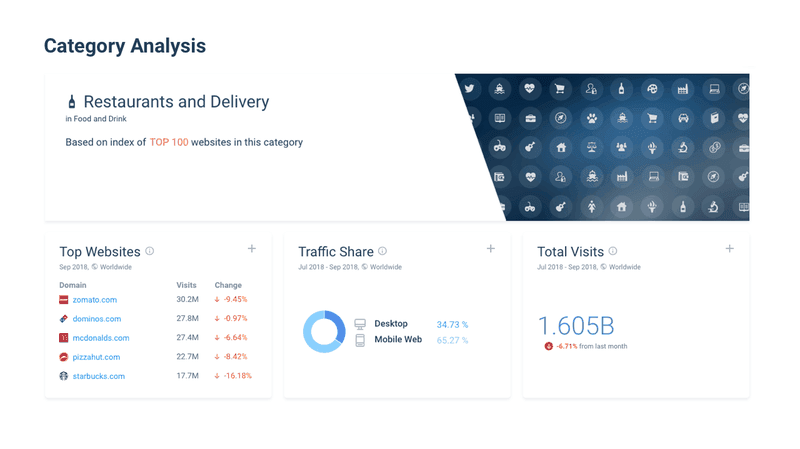
Ahrefs is one of the top SEO tools out there. It can give you some of the most sophisticated information about the types of backlinks you or your competitors have, search engine rankings, and much more.
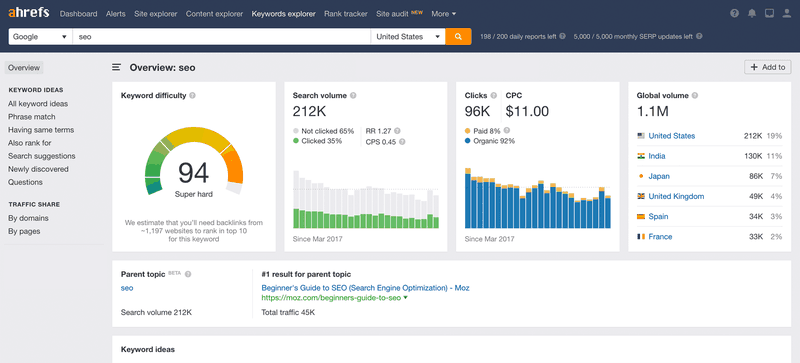
Tools for collaboration
Basecamp is a great tool for team collaboration. You can use it to message your team, store and organize project files efficiently, and work better with your team. There are so many data points to gather for your marketing plan and you will need to collaborate with multiple teams in your company.
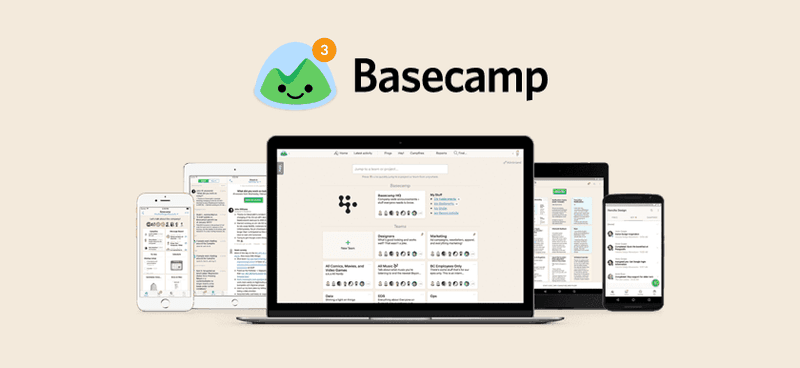
Slack is another great tool for team collaboration. Though it’s more focused on communication it does provide a great way to store information and collaborate with co-workers (and it has a slick design and an easy-to-use interface).
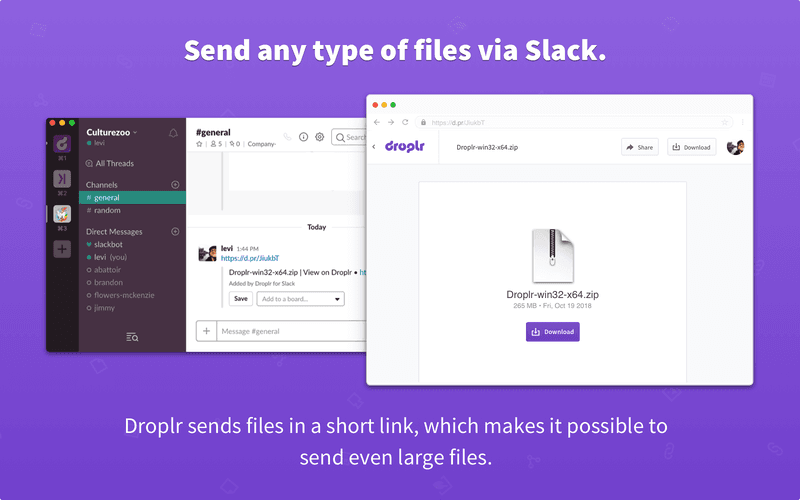
Speaking of design, let’s talk about visual design tools and software for your marketing plan.
Tools for charts and presentations
This is a great design tool for making charts. They have a really easy-to-use drag and drop design interface that allows you to create fancy charts and diagrams for your marketing plan in minutes.
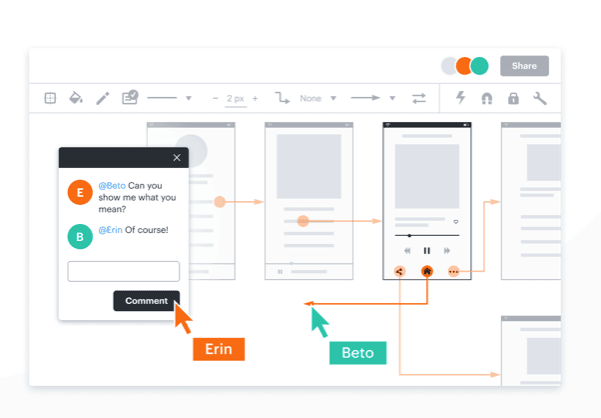
Canva is a great design tool for all kinds of design projects. It has a wide range of features that you could use to design amazing graphics and download them for your marketing plan.
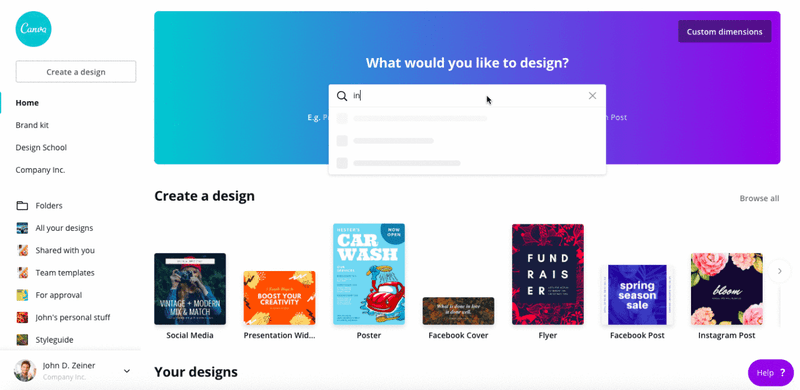
13. BONUS: Top marketing plan examples
There are so many areas of digital marketing and if you want to be really efficient you should make a plan for each one. The best way to learn is from the experts so let’s look at some of the best sample marketing plans. You can download any of these or save a copy for yourself.
Content Marketing Strategy Template - by Buffer
This is a really great plan for your content. It breaks down every process from discovering your ideal customers, to creating their buyer persona, finding the main challenges that your content could solve, and so on. This is a really in-depth guide designed for any content marketing out there.
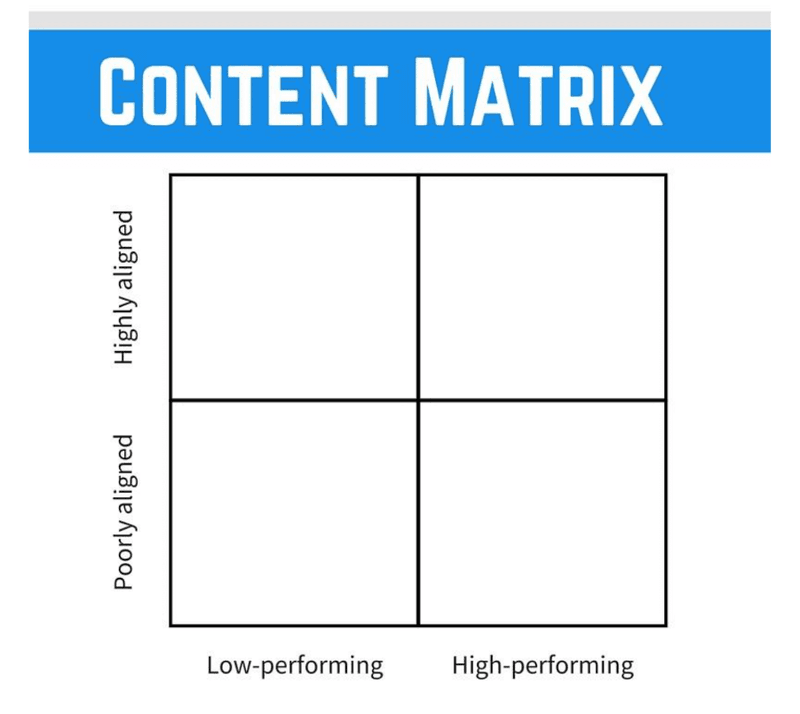
Simple Marketing Plan - from Cengage
Here’s another really great marketing plan example. This one looks really old school, so if you are a visual learner this one is probably not for you. But if you want to see a really well-written explanation of every section of a traditional marketing plan, you will get a lot of this example. Download it and fill it out, you will get a lot of value out of it.
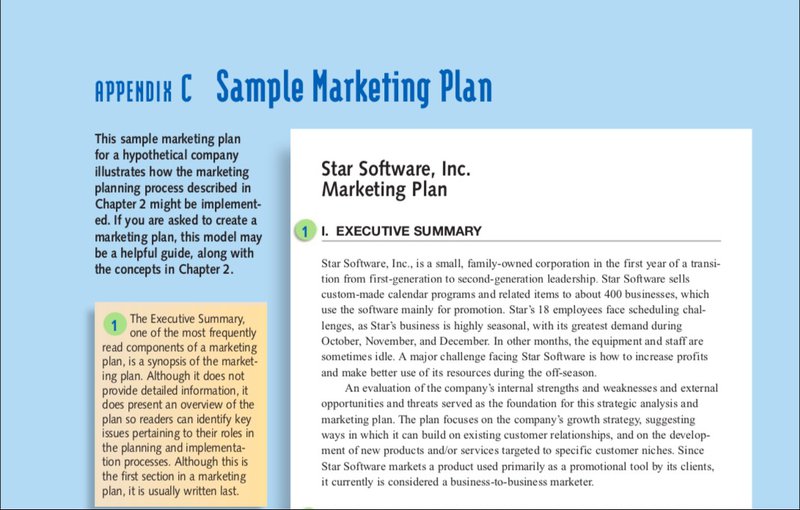
One Page Marketing Plan Template - from SmartSheet
Ok, if that wasn’t simple enough for you, here’s a quick one-page cheat sheet that you can use to quickly summarize your entire marketing plan. This one is really useful for a quick brainstorming session, especially when working with a remote team.
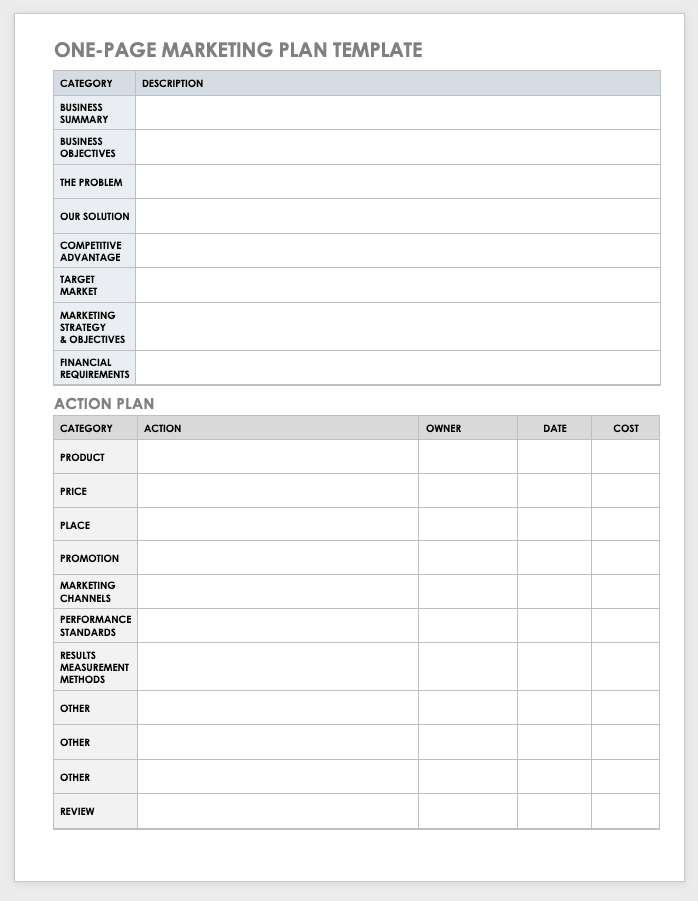
Marketing Strategy Template for Increasing Blog Traffic - from Sumo
Sumo has some incredible marketing plan templates. I used one of their templates to grow an Instagram account from 0-30k subscribers in 18 months. And here they strike again with a super-specific template & strategy on how to take your blog traffic to 10,000 visits in just 12 weeks.

Marketing plan infographic for specific projects - from Visme
Speaking of content, let’s talk about video.
Creating a video strategy for a brand can be a pretty complex task. You have a bunch of teams, a variety of factors to consider, and it can become a big mess pretty quickly. So, if you want to create a strategic marketing plan template for a specific project like that, then use this infographic template from Visme to display everything and make it all really easy for the whole team to follow.
This format is especially powerful when you’ve hired a digital marketing consultant because that’s when things can get a little unclear. So organizing every project into a quick infographic can provide a really great way to keep everyone organized.
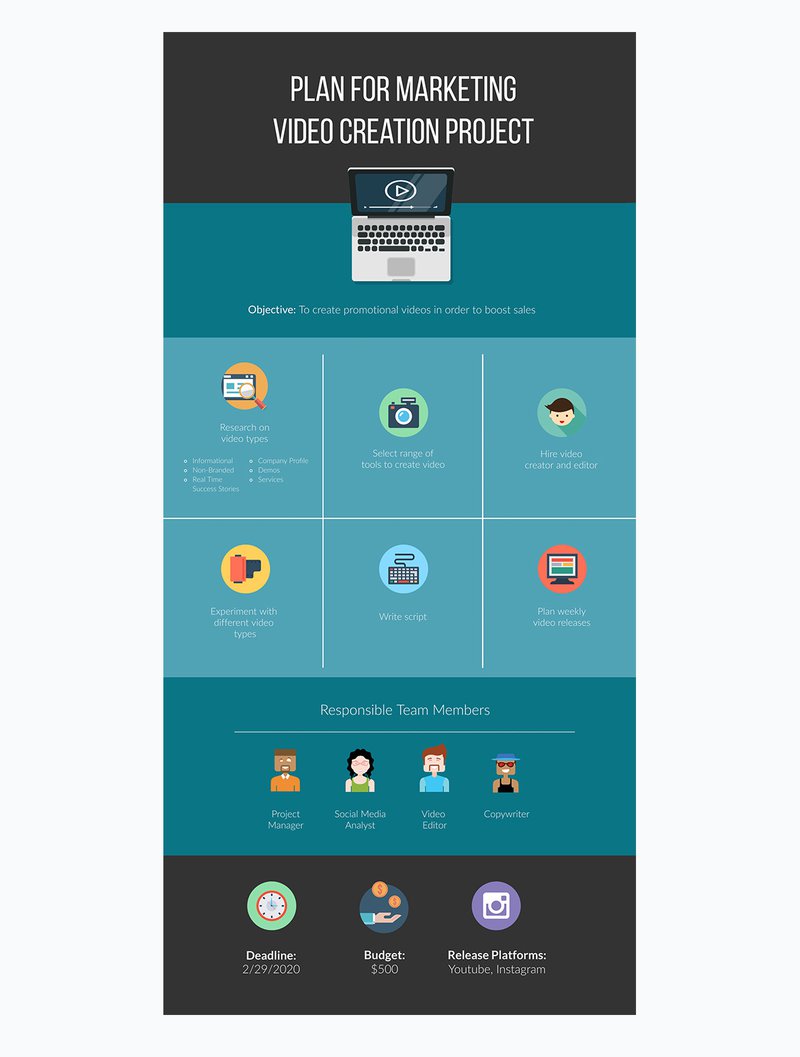
Email List Marketing Strategy Template
An email list is one of the most powerful tools any business has. It’s really hard to grow your list and keep subscribers engaged. Here’s a great marketing plan example for growing a list to over 1,500 new subscribers in 12 weeks.

Email Marketing Plan Template - from Hubspot
Here’s a great email marketing planning template from Hubspot that helps you create better emails. Hubspot is an incredible software product for any brand and they make incredible templates and guides on virtually every aspect of digital marketing. This template in particular has 3 parts - email planning, analytics, and A/B testing.
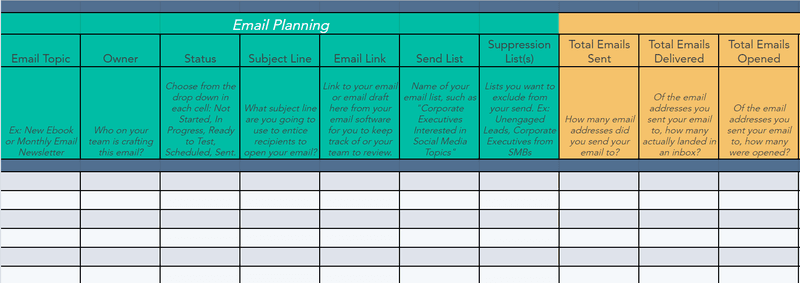
Ecommerce Marketing Plan Template - from Sumo
We’ve been focusing more and more on eCommerce businesses recently, and you can learn all about it in our eCommerce marketing guide . Here’s an example of a marketing plan that takes you through all the steps of growing your eCommerce revenue in 12 weeks.

eCommerce Marketing Plan Example - from Drip
Here’s another great marketing plan example from Drip. This one is a broad overview of each section and has some additional tracking info to fill out, that the other plans didn’t cover. It’s a quick and easy one.
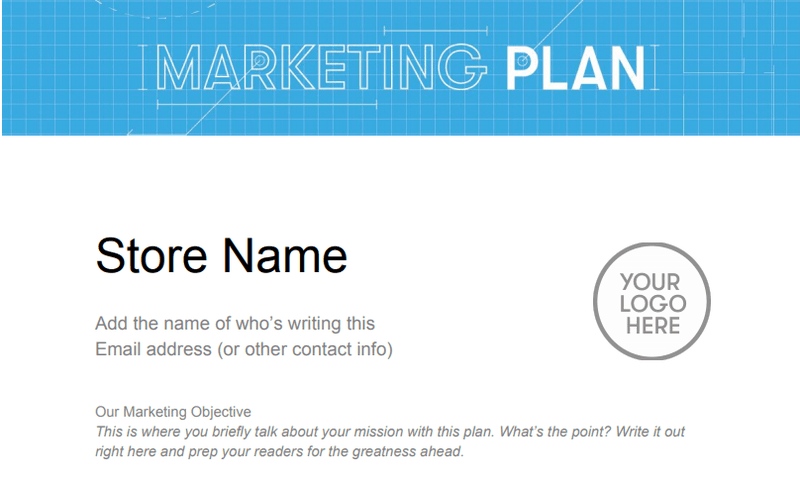
14. How to Create a Social Media Marketing Template
This is something that we get asked often. Sometimes a marketing manager or brand owner doesn’t want to design a whole new marketing plan from scratch, but only wants to focus on their social media.
How do you go about creating a social media marketing plan ?
Here’s a high-level overview of how to go about it.
1. Choose your SMART Goals.
We’ve spoken about this at the beginning of this article, and it’s super crucial that any kind of plan starts with some goals that make sense.
SMART stands for -
Here’s an example of a vague goal:
-We will increase our blog traffic to 100k monthly uniques.
Here’s how you turn that into a SMART goal:
- We will increase our blog traffic by 10% each month for the next 12 months by increasing all of our posts to 3,000 words and optimizing on-page content.
Did you notice how I set a deadline on that SMART goal?
T stands for time-bound and deadlines are absolutely crucial.
2. Define your target audience
It’s time to narrow down who your ideal customer is.
First, start by looking at your data on Google Analytics or any other tool you’re using. Find out as much information on your audience as you can.
This could include:
- Average income
- Shopping habits
3. Look at your competitors
4. analyze your social data.
Now that you know what your competitors are doing, compare that to where you are holding with your current marketing efforts.
Look at the following things on each channel:
- How many followers do you have
- How much engagement (likes & comments) you get
- Which types of posts are most successful
- Days of the week and times your account gets the most engagement
- Best times to post
5. Decide on accounts & channels
Next, choose the right social media platforms for your business. Decide which ones you want to use and for what purposes. It could be that one channel you could use for impressions, and on the other one, you really care about the engagement.
Here’s what we do at Mayple:
- Facebook - Organic impressions + ads to get new brands and marketing experts signed up -> lead generation and sales
- Instagram - Organic impressions + engagement aimed at marketers
- LinkedIn - Organic engagement + traffic for brand growth
You might find that Pinterest is a perfect platform to get traffic, while Instagram is primarily for sales. It totally depends on the industry, design, content format, and type of business you have.
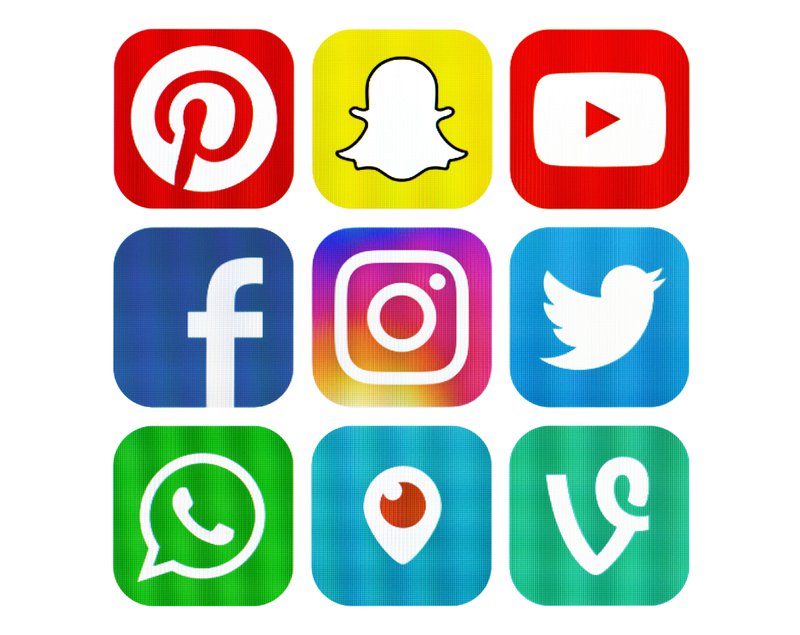
6. Get some inspiration
Now that you’ve decided on the channels you’re going after, look at some of the best social media posts for your niche and make an inspiration wall for yourself.
Look for posts or videos that catch your eye, designs, color schemes & messaging that would work well for your content.
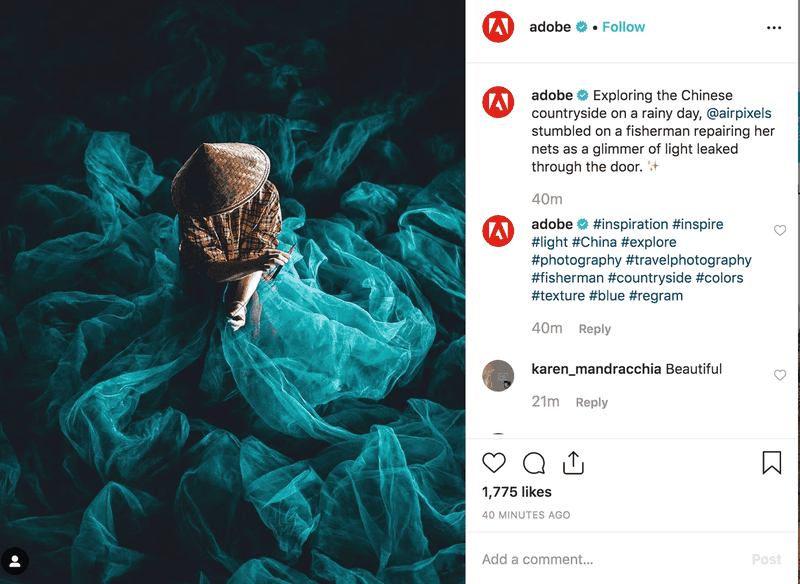
7. Decide on post types and formats
Next, decide on the exact types and formats of your posts.
Here are a few post formats you could pick from:
- Carousel posts
- Instagram Stories
- Short-form content
- Long-form content
I recommend deciding on 4-5 formats and testing them out for a few weeks.
8. Create a social media calendar
Now it’s time to put it all together into one calendar.
Use a scheduling app like eClincher , Sendible , CoSchedule , or Later .
They all have different features, so find something that fits your needs and budget.
Once you upload all of your posts into one calendar you can see it all visually, and see your post frequency for each platform.
9. Test for 30-60 days and re-evaluate
Are you excited? It’s time to launch this thing!
Launch your posts for the next 1-2 months and see how they do. After 2 months, re-evaluate your progress, and double down on the posts that did really well.
Take out the posts that didn’t do so well.
Continue optimizing as you go along.
Top Social Media Plan Templates
Here are a few of our favorite social media plan templates. You can use these to plan your calendar, to better optimize your strategy, and to rock out like the top brands out there.
Social Media Audit Template by Hootsuite
This template is a really great general for all of your needs. They have a separate tab for Instagram, Facebook, Twitter, LinkedIn, Snapchat, and Pinterest. Each tab is divided into a grid for all your accounts, performance, audience, goals, and even a SWOT analysis. These guys cover it all!
Get it ->
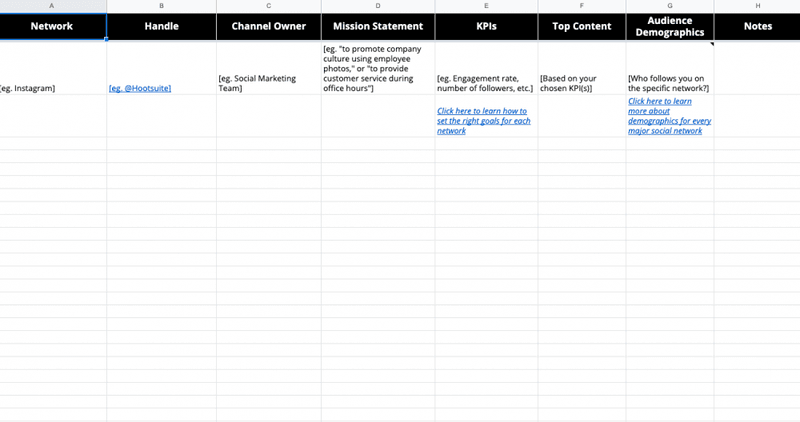
We’ve covered pretty much everything you need to know about how to plan, create, and design your digital marketing plan. Your plan should be the basis for all of the marketing initiatives of your marketing department. It should serve as the guideline for creative marketing material, setting up your campaigns, and your plan of action.
We’ve already created a really effective marketing plan template, which you can get - here .
Related Articles
![travel company digital marketing The Ultimate Beginner's Guide to Klaviyo [{year}]](https://entail.mayple.com/en-assets/mayple/fit-in/280x280/62810604a3953cb601522802_Klaviyobeginnersguide1_8e240650a02f316be960d7d6a0593acd_2000-1699776173348.jpg)
Ben Kazinik
The Ultimate Beginner's Guide to Klaviyo [2024]

What is Behavioral Targeting? How it Works + Key Strategies
![travel company digital marketing Amazon Listing Optimization: The Ultimate Seller Guide + Best Practices [{year}]](https://entail.mayple.com/en-assets/mayple/fit-in/280x280/63f73344661538b3bd684ebe_amazonlistingoptimization2520252812529_d777073f8a167e377bdb87febe6c8998_2000-1699518589853.jpg)
Amazon Listing Optimization: The Ultimate Seller Guide + Best Practices [2024]
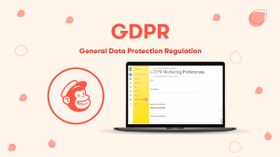
Octavia Drexler
11 Ways To Stay Compliant with Mailchimp GDPR (2024 Update)

John Marquez
Top 16 Social Media Platforms You Should Try in 2024
Travelers are going to extreme lengths to avoid scrolling and notification anxiety on vacation
- Adults are increasingly attached to their devices and are almost constantly online, study shows.
- Many are turning to the tourism industry to force themselves to disconnect and relax on vacation.
- Writer Sarah Wood breaks down the logistics and drivers of phone-free travel.

Six years ago, I spent ten days without my phone at a meditation retreat in Thailand. The experience was so refreshing that I felt like I had a new brain. I vowed to use my phone less, but unfortunately, the habit didn't stick. My phone usage has skyrocketed in the years since, sometimes clocking ten hours of screen time.
Planning a wedding and buying an apartment in the same month brought my digital dependence to new heights. On a recent trip to a Scottish cabin advertised as somewhere to "stay where the world can't find you," I tried to go tech-free and reset. With an itinerary of fly fishing and hiking, I thought it would be easy to unplug.
I was wrong.
The days were fine, but right before bed, I couldn't stop myself from scrolling through my email and notifications. I felt disheartened by my failed attempt to unplug.
62% of adults aged 18 to 29 say they're constantly online
Being unable to put your phone down, even on vacation, is becoming increasingly common. In 2024, a study by the Pew Research Center surveyed nearly 6,000 US adults on their tech usage . 62% of participants between 18 and 29 said they are almost constantly online.
In response to this constant online-ness, people also want to disconnect completely, especially while on vacation. Global search interest for "digital detox retreat" has increased by 50% in the past year. No longer beholden to emails and Slacks, vacations are the perfect time to shut down devices, and people are turning to the tourism industry to help them.
People are turning to the tourism industry to help them unplug
Property managers and tour operators are offering unplugged trips and tech-free destinations to meet this demand.
Unplugged is a cabin company in the UK offering "digital detox" long weekends in nature. Guests can use their phones to navigate to their Unplugged cabins, but once they arrive, they're expected to lock their phones in a box for their trip. The cabins have a paper map, a Polaroid camera for travelers, and a retro Nokia phone for emergencies.
"The key we found is to give people all the things that they might need their phone for," said Hector Hughes, CEO of Unplugged. The company launched in 2020 and has 23 cabins and a 94% occupancy rate since July last year, marking a 209% increase in bookings over the previous 12 months, according to Hughes.
Group travel operator For The Love of Travel (FTLO) ran its first phone-free trip this February and a second in April, and five more are listed on its site through 2025. For FTLO, the trips become "phone-free" once you arrive at the first hotel and meet your tour operator, who manages the logistics for the rest of the journey.
FTLO CEO Tara Cappel said guests are asked to leave their phones in their hotel safe or at the bottom of their bags when the group is together. "We're also obviously not controlling whether people are going back to the rooms and getting on their phones. It's an honor policy."
Related stories
According to Cappel, their first two trips were filled, and all guests expressed interest in another "phone-free" trip.
She acknowledged that tech-free travel hasn't become completely mainstream, "People are still a little intimidated by the idea."
Hughes told BI, "Many people haven't switched their phones off for years," Hughes added. "People experience phantom buzzes and find themselves searching for their phone instinctively before remembering it's locked in a box."
The reasons for going phone-free when traveling vary
One popular motivation is for couples to spend quality time with their partners. Hughes told BI that 80% of their guests are couples.
Elena Mnayarji, an MBA student at Berkeley, went on a phone-free honeymoon with her husband in Mallorca last summer. She said she didn't plan it but wanted to disconnect after a busy wedding. "By the time we got to Mallorca, I was exhausted and really needed to shut my brain off."
When she arrived in Mallorca, she turned her phone off and put it in a drawer at their hotel for their entire trip. Not checking her phone was difficult, but Elena was happy that she committed to it.
"For the first couple hours, it was a little tough," she said. "But I felt a lot less anxious." She also said her husband felt more connected to her.
Phone-free travel can also help with burnout
Last summer, nonprofit strategist Izzy Doonan did a tech-free week-long trip in the Cascades with her partner and another couple. They wouldn't have cell service, so they embraced the opportunity to get offline. "As the trip got closer, we all realized how burnt out we were. It was fitting to take a trip without our phones and really unplug," Doonan said.
As soon as they drove into the park and lost service, the group put their phones in the glove compartment of their car and didn't use them until they left the park.
"A lot of the nerves were from our parents because they wouldn't be able to contact us," said Doonan, who wasn't personally concerned. "I felt quite safe in the confines of a national park," she said, adding they had a car and other campers were around. "I would 1,000% do it again."
Logistics of traveling phone-free
Traveling phone-free does pose some logistical issues. "One concern that was brought up was that people's families back home were worried," said Cappel.
FTLO provides the trip leaders' phone numbers and full itineraries with contact information to travelers to share with whoever might need it. Mnayarji echoed, "I would recommend people tell their family if they're going to go phone-free. My mom was freaking out, so I had to text her from my husband's phone."
For both FTLO and Unplugged, you can use your phone to help you navigate to the destination and then are asked to put your phone away. Traveling domestically, bringing an emergency prepaid phone, or traveling with a tour operator in charge of the logistics are ways to make your tech-free trip as safe as possible.
Cappel said, "Committing to a multi-day phone-free trip is a lot, but if people can start with an afternoon and leave their phone in their hotel for the day, it's a great way to start and realize it's really doable."
Watch: Marriott International's Tina Edmundson tells Insider that the travel mindset has changed since the pandemic
- Main content

COMMENTS
Let us explore the top 20 digital marketing strategies for 2024 below:-. 1. Develop a user-friendly website. A user-friendly website is an essential part of a digital marketing strategy for travel brands in 2024. Having a good mobile-friendly website helps in many ways.
Establish measurable goals for your marketing plan and regularly monitor KPIs to track progress. Analyze website analytics, social media engagement, conversion rates, and customer feedback to gain insights into what resonates with your audience. Use data-driven decision-making to adapt your marketing strategies, focusing on successful channels ...
Digital marketing refers to the use of various digital channels and tools to promote a brand, product, or service. In the travel industry, digital marketing is used by travel companies to reach their target audience and promote their products and services online. Digital marketing for travel companies can include various tactics such as content ...
The importance of digital marketing in the travel and tourism industry cannot be overstated. From targeting specific audiences with precision to building brand loyalty and measuring results, digital marketing offers a broad range of benefits that can help businesses succeed in today's increasingly connected world.
You need to take a multi-pronged approach to marketing your travel agency. Your marketing strategy should include elements like social media marketing, paid marketing, content marketing, seasonal SEO, and local SEO. These pillars will contribute to the overall strength of your marketing plan.
Step 2: Develop a strong brand identity. Create a memorable and eye-catching brand identity that encapsulates your company's ethos and values. This includes your company name, logo, tagline, color scheme, and visual style. Consistency across all marketing channels reinforces brand recognition and establishes trust.
SEO (Search Engine Optimization) SEO is the core digital marketing strategy for travel agencies. It optimizes your website and content with the right keywords so your travel brand shows up prominently in local search results. This is a win-win approach while it boosts your website's visibility and attracts more visitors and your potential ...
Use identifiers such as age, gender, family size, earning potential, location, etc. You can also create elaborate buyer personas to guide your digital marketing efforts. 3. Define your USP. The travel agency business is highly competitive, making it difficult for smaller businesses to survive without a niche or differentiating characteristics.
Top 10 Travel Industry Marketing Strategies. Rethin Vipinraj. The tide is finally turning for the $247 billion Indian travel and tourism industry after more than a year - and the excitement is palpable. With travel bans easing in many parts of the world, domestic and international traffic is rising. Nearly every business vertical - from ...
Here are three ways we can use data to give digital travel campaigns an ROI boost. Build a story and media plan around your own data. In my experience as a marketing focused data scientist, CRM data has some of the richest signals, and is generally free for the brand. Brands have long relied on their CRM systems for offline and email marketing ...
So it should come as no surprise that when a pandemic put a halt on travel, tour operators turned to virtual experiences and social media to keep customers engaged. Travel companies from airlines to small activity operators doubled down on their travel digital marketing initiatives to stay relevant in 2020, even when bookings were nonexistent.
4. Retarget people who have shown interest. Travel is a big purchase, and people are unlikely to make a decision the first time they land on your site. Use Facebook remarketing to target consumers who have visited specific pages on your site or have shown an interest in a specific hotel room, date, or activity.
Travel advertising that delivers results. We've got decades of experience helping advertisers bring travelers to their destination, book hotels and flights, and more. We get you to the right traveler at the right time and through the right channel. You need someone who understands the travel business better than anyone else, and that's ...
The Digital Travel Expert Marketing blog is updated regularly with fresh content that is both informative and engaging. Our blog is a go-to source for travel SEO, Social Media, Travel Content, Influencer Marketing, and other digital marketing strategy ideas relevant to the hospitality and tourism industry. Stay up-to-date with the latest trends ...
If you, like many travel companies, are finding it hard to make headway in the current market, it may be time to bring in an expert. Contact Inflow's strategists today to learn how our digital marketing services can help your travel or tourism business. 2. Be seasonally smart with your marketing investments. The travel industry is seasonal.
Without changing its business model and broadening distribution channels, Thomas Cook was destined to be overthrown by Booking Holdings and Expedia. The market is extremely competitive, and it undergoes changes, becoming increasingly more digital. This calls for intricate approaches to marketing, distribution, and travel products themselves.
Whether you sell hotel rooms, apartments or packages deals that include travel, our digital marketing services for travel agencies will help you find new traffic through various means, including: Google AdWords campaigns, social media, meta search, display advertising and blog presence. Esario can also analyse your site for potential conversion ...
The first step in crafting an effective marketing strategy is to understand who your travelers are and what they seek. Today's travelers are looking for authentic, memorable experiences. They prefer personalized travel packages and value convenience and speed in booking. Recognizing these preferences is key to tailoring your marketing efforts.
LOVE HOLIDAYS. Love Holidays were ranked the second fastest growing company in the UK last year so it's no surprise they have their digital marketing ducks in a row. Much of their growth seems to have come from better awareness of the brand, with 16% of search visits coming from branded phrases.
Unlock the full potential of your travel business and ascend to new heights with our white-label travel website digital marketing services. We offer comprehensive solutions that include PPC, social media marketing, content marketing and more, eliminating the limitations of in-house resources. Partner with us and elevate your online presence to ...
Digital Marketing Strategy is a 7-week, 35-40 hour online certificate program from Harvard Business School. Digital Marketing Strategy equips professionals with the tools, mindset, and trends to make decisions about digital marketing strategy and tactics, including how to position a product or service for success, acquire and engage customers ...
AI, particularly gen AI, offers a new way to augment and scale these capabilities with the potential for enormous benefits: according to McKinsey research, generative AI has the potential to unlock between $2 trillion and $4 trillion in annual value across industries. 6 In the travel context, gen AI could take the form of a digital assistant ...
Creating a Data Advantage in Marketing—With or Without Cookies. June 07, 2024. By Eric Jesse , Karen Lellouche Tordjman , Derek Rodenhausen , Robert Derow, and Nathan Schoeffler. Reading time: 5 min. The end of third-party cookies was at hand until it wasn't. In April, Google announced that it would push back the implementation of Tracking ...
Worldwide Leader in Affiliate Marketing & Ecommerce Growth. At ClickBank, your company is in good company. The ClickBank platform empowers entrepreneurs and brands across the globe to grow, scale, and reach customers like never before. We've paid out more than $6.2 billion over the last 25+ years, but we're just getting started.
The digital marketing website examples on this page are all high-performance and will load fast, be fully responsive, SEO-friendly and compatible with the most popular WordPress plugins. Each template is crafted with a marketing business in mind. You can use these marketing website designs to get inspiration for your or your client's websites.
Here are the main features of this degree: Broader Business Education: This program provides a comprehensive foundation in various business disciplines, such as finance, management, and operations, as well as marketing. Analytics and Data Focus: A significant emphasis is placed on analytics and data-driven decision-making.
The five Ps. The five Ps are product, price, place, promotion, and people . Today, many marketers use the five Ps over the four Ps because they center the experiences of customers and staff in the marketing process. Typical considerations include how a customer behaves, their product experience, and overall satisfaction with the business.
Photo taken by author, May 2024. With that comes some new ad space available for advertisers. Some of the key media announcements within Google Ads include: Shopping ads to appear in Google Lens ...
Content marketing. Content marketing is very powerful for inbound marketing. Studies show that 60% of marketers create at least one piece of content per day and the year-over-year growth in traffic is 7.8X higher for content leaders. Companies like Capterra and Quuu attribute their success to really good content.
The company launched in 2020 and has 23 cabins and a 94% occupancy rate since July last year, marking a 209% increase in bookings over the previous 12 months, according to Hughes. Group travel ...